Annual Report 2021
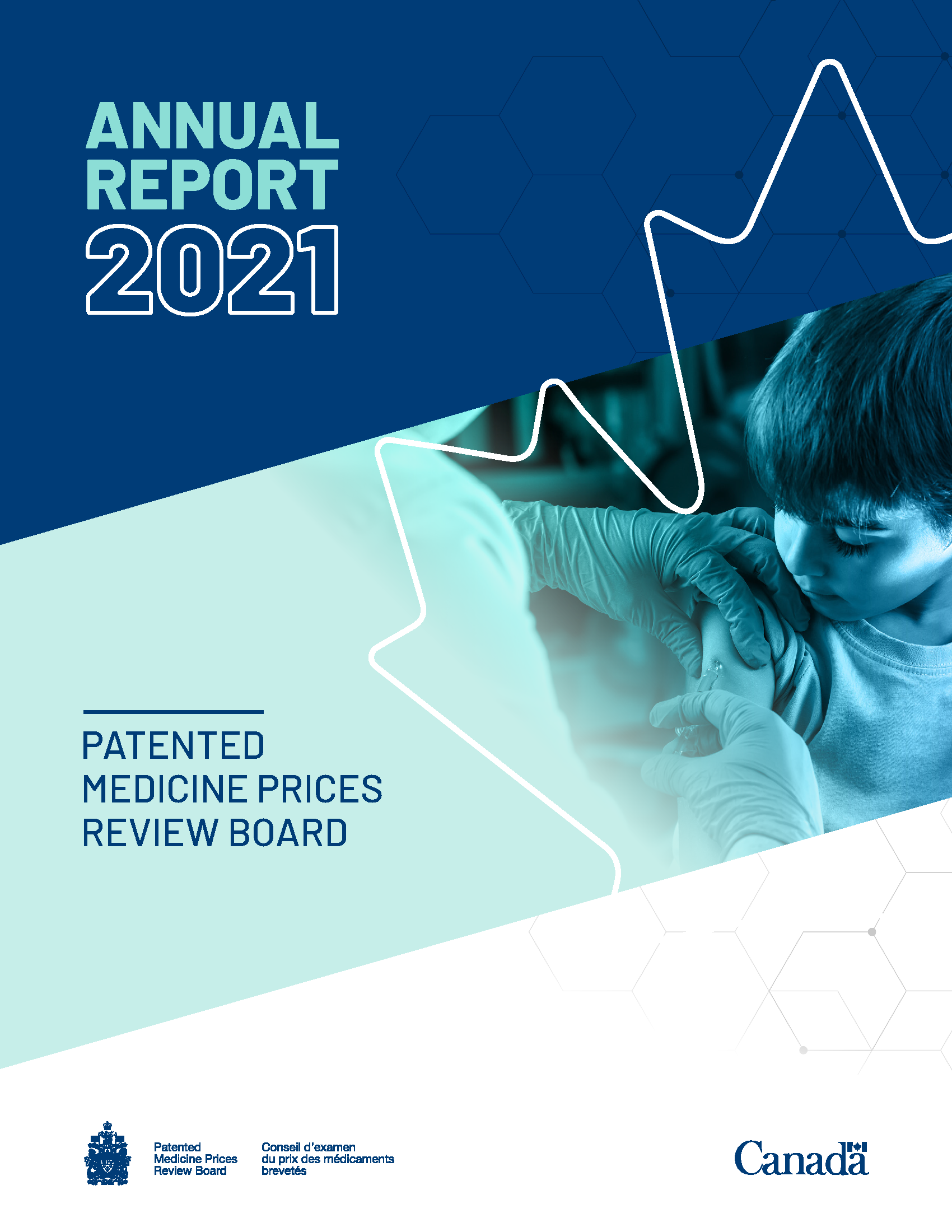
ISSN: 1495 – 0561
Cat. no.: H78E-PDF
PDF version (6.2 MB)
Table of Contents
- Statistical Highlights 2021
- Letter to the Minister
- Chairperson's Message
- About the Patented Medicine Prices Review Board: Acting in the Interest of Canadians
- Regulating Prices of Patented Medicines: Informing on PMPRB Regulatory Activities
- Key Pharmaceutical Trends: More Expensive Medicines Continue to Influence Sales
- The National Prescription Drug Utilization Information System: Supporting Health Care Decision Making in Canada
- Analysis of Research and Development Expenditures: At a Historical Low
- Appendix 1: Glossary
- Appendix 2: Patented Medicines/New Dosage Forms and Strengths First Reported to the PMPRB in 2021
- Appendix 3: Pharmaceutical Trends - Sales
- Appendix 4: Research and Development
Statistical Highlights 2021
Regulatory Mandate
- 1,177 patented medicines for human use were reported to the PMPRB, including 59 new medicines.
- 2 Voluntary Compliance Undertakings were accepted as of December 31, 2021.
- $38 thousand in excess revenues were offset by way of payments to the Government of Canada, in addition to price reductions.
Reporting Mandate
Sales Trends:
- Sales of patented medicines in Canada were $17.4 billion in 2021, a slight decrease of 1.7% from the previous year.
- Patented medicines accounted for approximately 51.0% of the sales of all medicines in Canada in 2021.
Price Trends:
- The Consumer Price Index rose by 3.4%, while the national average transaction price for patented medicines increased by 0.4%.
- Canadian list prices were third highest among the 31 Organisation for Economic Co-operation and Development (OECD) countries, lower than prices in the US and Switzerland.
Research and Development
R&D-to-Sales Ratios Remained Steady in 2021:
- 3.4% for all patentees, unchanged from 2020.
- 3.5% for Innovative Medicines Canada members, unchanged from 2020.
R&D Expenditures:
- $922.9 million in total R&D expenditures were reported by patentees, an increase of 12.2% over 2020.
- $735.9 million in R&D expenditures were reported by Innovative Medicines Canada members, an increase of 11.0% over 2020.
Letter to the Minister
15 September 2022
The Honourable Jean-Yves Duclos, P.C., M.P.
Minister of Health
House of Commons
Ottawa, Ontario
K1A 0A6
Dear Minister:
I have the pleasure to present to you, in accordance with sections 89 and 100 of the Patent Act, the Annual Report of the Patented Medicine Prices Review Board for the year ended December 31, 2021.
Yours very truly,
Mélanie Bourassa Forcier
Acting Chairperson
Chairperson’s Message

The Patented Medicine Prices Review Board (PMPRB) is an independent quasi-judicial body established by Parliament in 1987 under the Patent Act (the Act). The PMPRB’s mandate is to protect and inform Canadians by ensuring that the prices of patented medicines sold in Canada are not excessive and by reporting on pharmaceutical trends.
Uncertainty has been the one constant in the lives of Canadians the past two tumultuous years, with the best laid plans of governments and individuals repeatedly upended by intensifying waves of the COVID-19 pandemic. However, in so far as the PMPRB is concerned, recent announcements by the Minister of Health with respect to the implementation of Health Canada’s amendments to the Patented Medicines Regulations have finally brought certainty and predictability to policy questions that remained unsettled since the early days of the pandemic. Further predictability and clarity will emerge from the PMPRB’s upcoming consultation on its new Guidelines later this year. Once the new Guidelines are in place, as always, the PMPRB will do its utmost to protect Canadians from excessively priced patented medicines through the responsible and efficient use of our regulatory powers.
In terms of the PMPRB’s reporting mandate, this past year we continued to provide analytical support and expertise to our health partners under the broad umbrella of the National Prescription Drug Utilization Information System (NPDUIS) initiative. In addition to a great deal of behind-the-scenes analytical work on various pan-Canadian pharmaceutical policy initiatives, since the beginning of 2021, the PMPRB has published five analytical reports, one chartbook, and four presentations under the NPDUIS banner. These studies continue to highlight the pressures stemming from the increased use of higher-cost medicines in Canada. Over the last five years, sales of patented medicines have grown by an average of 2.2% per year, reaching $17.4 billion in 2021. High-cost medicines now account for 57.1% of these sales. As noted in this year’s Annual Report, in 2021, the 20 top-selling patented medicines in Canada, which accounted for 40% of total patented medicine sales, had a median treatment cost of $42,616, nearly 60 times the median in 2012. In 2021, Canadian list prices of patented medicines were the third highest in the Organisation for Economic Co-operation and Development (OECD), behind only the US and Switzerland. These trends all serve to reinforce the significance the government’s current suite of very ambitious pharmaceutical policy objectives, such as a national formulary, a strategy for drugs for rare diseases, and a national drug agency.
2021 was a year of significant change in senior leadership at the PMPRB, with Dr. Mitchell Levine’s five-year term as the Chairperson of the Board coming to an end in November 2021. Although a permanent replacement has yet to be named, I and my fellow Board members look forward to finally turning the page on the multiyear effort to modernize our regulatory framework and working with our stakeholders and partners under new leadership to deliver as best we can on the PMPRB’s mandate priorities.
Mélanie Bourassa Forcier
Acting Chairperson
About the Patented Medicine Prices Review Board: Acting in the Interest of Canadians
The Patented Medicine Prices Review Board (PMPRB) is an independent, quasi-judicial body established by Parliament in 1987 under the Patent Act (Act).
The PMPRB is a quasi-judicial administrative agency with a dual regulatory and reporting mandate. Through its regulatory mandate, it ensures that the prices of patented medicines sold in Canada are not excessive. The PMPRB also reports on trends in pharmaceutical sales and pricing for all medicines and on research and development (R&D) spending by patentees. In addition, at the request of the Minister of Health, pursuant to section 90 of the Act, the PMPRB conducts critical analyses of price, utilization, and cost trends for patented and non-patented prescription medicines under the National Drug Utilization Information System (NPDUIS) initiative. Its reporting mandate provides pharmaceutical payers and policy makers with information to make rational, evidence-based reimbursement and pricing decisions.
The PMPRB is part of the Health Portfolio, which includes Health Canada, the Public Health Agency of Canada, the Canadian Institutes of Health Research and the Canadian Food Inspection Agency. The Health Portfolio supports the Minister of Health in maintaining and improving the health of Canadians.
Our Mission
The PMPRB is a respected public agency that makes a unique and valued contribution to sustainable spending on pharmaceuticals in Canada by:
- Providing stakeholders with price, cost, and utilization information to help them make timely and knowledgeable pricing, purchasing, and reimbursement decisions; and
- Acting as an effective check on the prices of patented medicines through the responsible and efficient use of its consumer protection powers.
Protecting Consumers in a Complex Marketplace
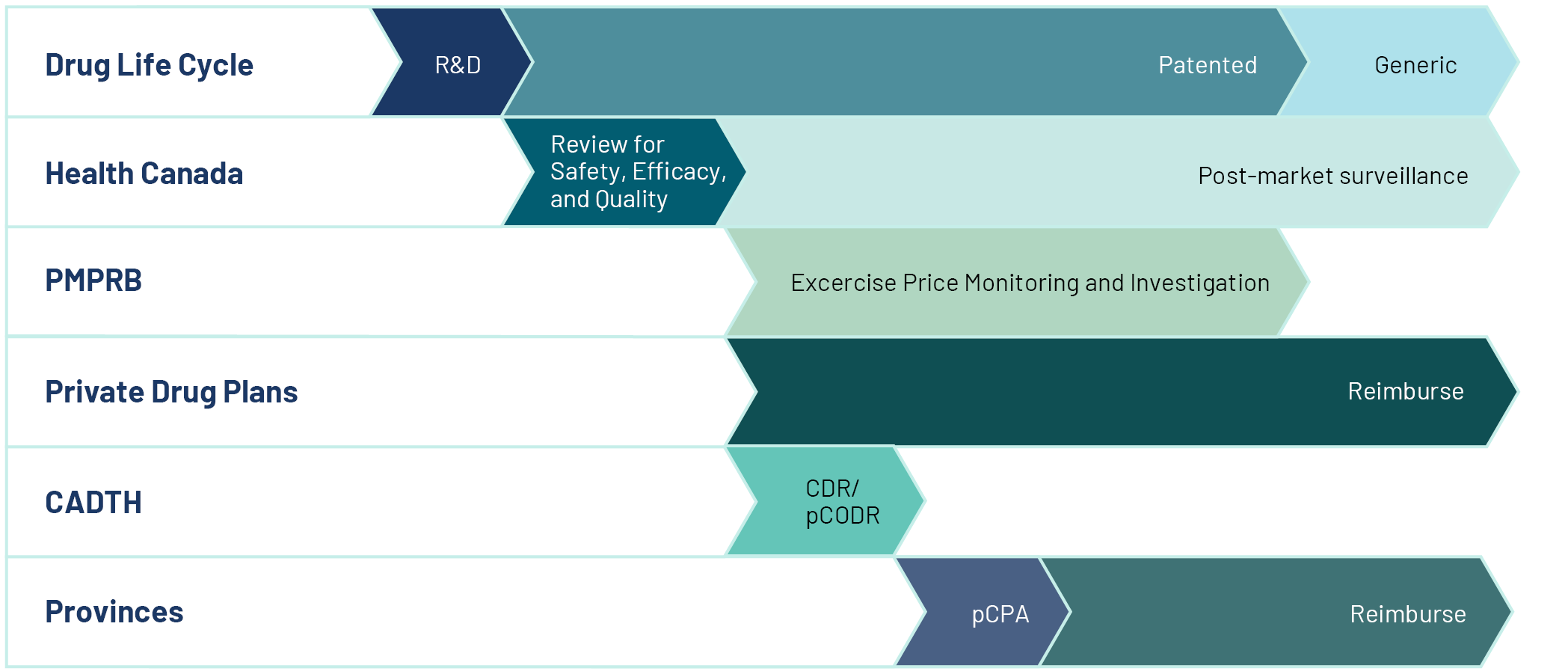
(CADTH) Canadian Agency for Drugs and Technologies in Health; (CDR) Common Drug Review; (pCODR) pan-Canadian Oncology Drug Review; and (pCPA) pan-Canadian Pharmaceutical Alliance
Data source: PMPRB
Figure description
This flowchart illustrates the role of Canadian regulators during the life cycle of a medicine through research and development, the patent period, and post-patent generic period. Health Canada reviews medicines for safety, efficacy, and quality at the start of the patent period and provides subsequent post-market surveillance. The PMPRB exercises price monitoring and investigation during the patent period, after Health Canada’s review. Private drug plans reimburse during and after the patent period, following Health Canada’s review. CADTH conducts the Common Drug Review and pan-Canadian Oncology Drug Review processes after Health Canada’s review. For provinces and territories, the pan-Canadian Pharmaceutical Alliance negotiations begin after CADTH reviews, and reimbursement is after these negotiations.
Although part of the Health Portfolio, because of its quasi-judicial responsibilities, the PMPRB carries out its mandate at arm’s length from the Minister of Health, who is responsible for the sections of the Act pertaining to the PMPRB. The PMPRB also operates independently of other healthcare-related bodies, such as:
- Health Canada, which approves medicines for marketing in Canada based on their safety, efficacy, and quality;
- federal, provincial and territorial (F/P/T) public drug plans, working collectively as the pCPA, which approve the listing of medicines on their respective formularies for reimbursement purposes; and
- the Common Drug Review and pan-Canadian Oncology Drug Review, administered by the CADTH, which recommend which new medicines should qualify for reimbursement by the pCPA.
The PMPRB is composed of public servants (Staff) who are responsible for carrying out the organization’s day-to-day work, and Board Members, Governor-in-Council appointees who serve as hearing panel members in the event of a dispute between Staff and a patentee over the price of a patented medicine.
Jurisdiction
Regulatory
The PMPRB reviews the price at which patentees (companies) sell their products to wholesalers, hospitals, pharmacies and other large distributors to ensure that this price is not excessive. This price is sometimes also known as the “factory gate” (ex-factory) price. The PMPRB does not regulate the prices of non-patented medicines.
The PMPRB’s jurisdiction is not limited to medicines for which the patent is for the active ingredient or for the specific formulation(s) or uses the patentee sells the medicine for in Canada. Rather, its jurisdiction also covers medicines for which a patent “pertains”, including patents for manufacturing processes, delivery systems or dosage forms, indications/use, and any formulations.
The Act requires patentees (which include any parties who benefit from patents regardless of whether they are owners or licensees under those patents and regardless of whether they operate in the “brand” or “generic” sector of the market) to inform the PMPRB of their intention to sell a new patented medicine. Upon the sale of a new patented medicine, patentees are required to file price and sales information at introduction and, thereafter, until all patents pertaining have expired. Patentees are not required to obtain approval of the price to be able to market their medicines. However, the Act requires the PMPRB to ensure that the prices of patented medicines sold in Canada are not excessive.
Staff review the prices that patentees charge for each individual strength and form of a patented medicine. If the price of a patented medicine appears to be potentially excessive, the patentee may volunteer to lower its price and/or refund its potential excess revenues through a Voluntary Compliance Undertaking (VCU). If this fails, the Chairperson may consider whether a hearing on the matter is in the public interest. At the hearing, a panel composed of Board members acts as a neutral arbiter between Staff and the patentee. If a Hearing Panel concludes, after hearing all of the evidence in light of the factors set out in section 85 of the Act, that the price of a patented medicine is/was excessive in any market, it can order the maximum ceiling price to be reduced to a non-excessive level. It can also order a patentee to make a monetary payment to the Government of Canada to offset the excess revenues earned and, in cases where the panel determines there has been a policy of excessive pricing, it can double the amount of the monetary payment.
Our Vision:
A sustainable pharmaceutical system where payers have the information they need to make smart reimbursement choices and Canadians can afford the patented medicines they need to live healthy and productive lives.
Reporting
As required by the Act, the PMPRB reports annually to Parliament through the Minister of Health on its price review activities, the prices of patented medicines and price trends of all prescription medicines, and on the R&D expenditures reported by pharmaceutical patentees.
In addition, as a result of an agreement by the F/P/T Ministers of Health in 2001, and at the request of the Minister of Health, pursuant to section 90 of the Act, the PMPRB conducts critical analyses of price, utilization, and cost trends for patented and non-patented prescription medicines under the National Prescription Drug Utilization Information System (NPDUIS). The PMPRB publishes the results of NPDUIS analyses in the form of reports, posters, presentations, briefs, and chartbooks. This program provides F/P/T governments and other interested stakeholders with a centralized, objective, and credible source of information on pharmaceutical trends.
Among other initiatives under its reporting mandate, the PMPRB also hosts various forums, such as webinars, research forums, and information sessions, with academics and policy experts to discuss and disseminate research on emerging areas for study on pharmaceutical trends in Canada and internationally.
1,177 patented medicines were reported to the PMPRB in 2021.
Communications and Outreach
The PMPRB takes a proactive and plain-language approach to its external communication activities. This includes targeted social media campaigns and more conventional (e.g., email and telephone) engagement with domestic, international, and specialized news media. The PMPRB is actively pursuing additional opportunities to leverage new and emerging media to communicate with its stakeholders and the Canadian public.
The PMPRB recognizes the importance of openness and transparency as we continue to work on modernizing the way we carry out our mandate. We communicate regularly, through various channels, about our progress, including projected timelines, and key milestones. Engagement with stakeholders will remain a central part of our multi-faceted communications approach. Reporting on our progress helps ensure we remain focused on delivering results.
Governance
The Board consists of not more than five members who serve on a part-time basis. Board members, including a Chairperson and a Vice-Chairperson, are appointed by the Governor-in-Council. The Chairperson, designated under the Act as the Chief Executive Officer of the PMPRB, has the authority and responsibility to supervise and direct its work. By law, the Vice-Chairperson exercises all the powers and functions of the Chairperson when the Chairperson is absent or incapacitated, or when the office of the Chairperson is vacant.
The members of the Board, including the Chairperson, are collectively responsible for implementing the applicable provisions of the Act. Together, they establish the guidelines, rules, by-laws, and other policies of the PMPRB provided for by the Act (section 96) and consult, as necessary, with stakeholders including provincial and territorial Ministers of Health, representatives of consumer groups, the pharmaceutical industry, and others.
Members of the Board
Vice-Chairperson (Acting Chairperson)
Mélanie Bourassa Forcier
LLB., LL.L, MSc, LL.M., DCL

Mélanie Bourassa Forcier was appointed Vice-Chairperson of the Board on June 19, 2019, and has been Acting Chairperson since November 2021.
Professor Mélanie Bourassa Forcier is a lawyer and Full Professor in the Faculty of Law at the Université de Sherbrooke. She directs the Law and Health Policy, and Law and Life Sciences programs. She has expertise in Health governance and Ethics in Health Policy, Intellectual Property, Regulation of Digital Technologies, Technology Transfers and in Pharmaceutical Law and Policies. Over the years she has particularly concentrated her research on policies promoting the development, integration and access to innovation in the health care sector.
Professor Bourassa Forcier has published numerous books and articles on the subject of pharmaceutical regulation and health law. She holds a Ph.D. in Pharmaceutical Patent Law from McGill University, an MSc in International Health Policy from the London School of Economics and Political Science (concentration in Health Economics), a LL.M. in Law and Biotechnologies from the University of Montreal and an LL.L. from the University of Ottawa (summa cum laude).
Members
Carolyn Kobernick,
B.C.L., LL.B.

Carolyn Kobernick was appointed Member of the Board on June 13, 2014.
Ms. Kobernick is a lawyer and former public servant. Prior to her retirement in 2013, Ms. Kobernick had been Assistant Deputy Minister of Public Law for the Department of Justice since 2006. As principal counsel to the Minister of Justice and Attorney General of Canada, Ms. Kobernick was instrumental in the development and delivery of policy for the Department of Justice. In addition to identifying key strategic, legal, and operational matters, she tackled cross-cutting national issues as the liaison between the Department of Justice and other government organizations.
Ms. Kobernick holds a B.C.L. and LL.B. from McGill University and is a member of the bar of Ontario. In 2012 she obtained a Certificate in Adjudication for Administrative Agencies, Boards and Tribunals from the Osgoode Hall Law School and the Society of Ontario Adjudicators and Regulators.
Dr. Ingrid Sketris,
BSc (Pharm), PharmD, MPA(HSA), Clinical Toxicology Residency

Dr. Ingrid Sketris was appointed Member of the Board on June 29, 2018.
Dr. Sketris is a licensed pharmacist and a professor at the College of Pharmacy, Dalhousie University, with cross appointments to Medicine and Health Administration.
Dr. Sketris received her Doctor of Pharmacy in 1979 from the University of Minnesota, followed by her residency in Clinical Toxicology at the University of Tennessee Centre for the Health Sciences. She also received a Master of Public Administration/Health Services Administration from Dalhousie University.
She is a leader in pharmacy, and has served as President of the Association of Faculties of Pharmacy of Canada and as a board member of the Canadian Council for Accreditation of Pharmacy Programs.
Dr. Sketris is a Fellow of the Canadian Society of Hospital Pharmacists, the American College of Clinical Pharmacy and the Canadian Academy of Health Sciences. She was previously elected to the US National Academies of Practice.
Matthew Herder,
B.Sc. (hons), LL.B., LL.M., J.S.M.

Matthew Herder was appointed Member of the Board on June 29, 2018.
Mr. Herder is the Director of the Health Law Institute at Dalhousie University, as well as an Associate Professor in the Department of Pharmacology in the Faculty of Medicine, with a cross-appointment to the Schulich School of Law.
Mr. Herder’s research focuses on biomedical innovation policy, with a particular emphasis on intellectual property rights and the regulation of biopharmaceutical interventions. His work is often interdisciplinary and policy-oriented, and he has received grants from the Canadian Institutes of Health Research and the Royal Society of Canada, in addition to appearing as an expert witness before several Parliamentary committees on pharmaceutical regulation and policy.
Prior to arriving at Dalhousie, Mr. Herder was the Ewing Marion Kauffman Foundation Legal Research Fellow at New York University’s School of Law. He was a Law Clerk at the Federal Court of Canada and was admitted to the Law Society of Upper Canada. Mr. Herder holds a Master of the Science of Law degree from Stanford Law School as well as two law degrees from Dalhousie University.
Organizational Structure and Staff
PMPRB Organizational Chart

Figure description
This organizational chart illustrates the high-level reporting structure within the PMPRB and lists the current Board and Senior Staff members. Board: Chairperson— Vacant; Vice-Chairperson (Acting Chairperson)— Mélanie Bourassa Forcier; Members— Carolyn Kobernick, Dr. Ingrid Sketris, Matthew Herder. Senior Staff: Executive Director— Douglas Clark; General Counsel— Isabel Jaen Raasch; Director Board Secretariat— Sherri Wilson; Director Policy and Economic Analysis— Tanya Potashnik; Director Regulatory Affairs and Outreach— Guillaume Couillard; Senior Director Corporate Services and CFO— Devon Menard.
Executive Director
The Executive Director is responsible for advising the Board and for the leadership and management of Staff.
Regulatory Affairs and Outreach
The Regulatory Affairs and Outreach Branch reviews the prices of patented medicines sold in Canada; ensures that patentees are fulfilling their filing obligations; encourages patentees to comply voluntarily with the PMPRB’s Guidelines; implements related compliance policies; and investigates complaints into the prices of patented medicines.
Policy and Economic Analysis
The Policy and Economic Analysis Branch develops policy and strategic advice; leads stakeholder consultations and makes recommendations on possible amendments to the PMPRB’s Guidelines; conducts research and analysis on the prices of medicines, pharmaceutical market developments, and R&D trends; and publishes studies aimed at providing F/P/T governments and other interested stakeholders with centralized, objective, and credible information in support of evidence-based policy.
Corporate Services
The Corporate Services Branch provides advice and services in relation to human resources management; facilities; procurement; health, safety and security; information technology; and information management. It coordinates activities pursuant to the Access to Information Act and the Privacy Act, and is responsible for strategic planning and reporting. It is also responsible for financial planning and reporting, accounting operations, audit and evaluation, and liaising with federal central agencies on these topics.
Board Secretariat
The Board Secretariat manages the Board’s meeting and hearing processes, including the official record of proceedings.
General Counsel
The General Counsel advises the PMPRB on legal matters, leads the legal team representing Staff in proceedings before the Board, and liaises with counsel for the Attorney General in PMPRB-related proceedings before federal and provincial courts.
Budget
In 2021-22, the PMPRB had a budget of $18.9 million and an approved staff level of 85 full-time equivalent employees.
Table 1. Budget and Staffing
| 2020-21 | 2021-22 | 2022-23 | |
|---|---|---|---|
| Budget | $17,804,400 |
$18,892,322 |
$17,003,213 |
| Salaries and employee benefits | $10,054,721 |
$10,175,540 |
$10,164,617 |
| Operating | $2,491,893 |
$2,510,296 |
$2,375,235 |
| Special Purpose Allotment† | $5,257,786 |
$6,206,486 |
$4,463,361 |
| Full Time Employees (FTEs) | 87 |
85 |
84 |
* Budget amounts are based on the Main Estimates
† The Special Purpose Allotment is reserved strictly for external costs of public hearings (legal counsel, expert witnesses, etc.). Unspent funds are returned to the Consolidated Revenue Fund.
Regulating Prices of Patented Medicines: Informing on PMPRB Regulatory Activities
Medical advancements have introduced many innovative new medicines to the Canadian marketplace to improve existing treatments and to treat conditions that previously had no pharmaceutical therapy. However, many of these new medicines come at a very high cost. Since 1987, pharmaceutical costs in Canada have grown at an average annual rate of 4.1%,Footnote 1 outpacing all other health care costs and growing at well over three times the pace of inflation. At 13.9% of total health care spending, pharmaceuticals now rank ahead of spending on physicians.Footnote 2 About 1 in 5 Canadians reports having no prescription medicine coverage and many more are under-insured or face high deductibles or co-pays. Almost 1 in 10 Canadians have had to forego filling a prescription medicine in the past year for reasons related to cost.Footnote 3
The PMPRB protects the interests of Canadian consumers by ensuring that the prices of patented medicines sold in Canada are not excessive. It does this by reviewing the prices that patentees charge for each individual patented medicine and by ensuring that patentees reduce their prices and pay back excess revenues, where appropriate.
Reporting Requirements
By law, patentees must file information about the sale of their medicines in Canada. The Act and the Patented Medicines Regulations (Regulations) set out the information required and Staff reviews pricing information on an ongoing basis until all relevant patents have expired.
The Compendium of Policies, Guidelines and Procedures (Guidelines) details price tests and triage mechanisms used by Staff when it reviews and investigates the prices of patented medicines. The Guidelines are not binding and were developed in consultation with stakeholders, including the provincial and territorial Ministers of Health, consumer groups, and the pharmaceutical industry. When an investigation suggests that the price of a patented medicine is excessive, the patentee may volunteer to lower its price and/or refund its potential excess revenues through a Voluntary Compliance Undertaking (VCU). If the patentee chooses not to submit a VCU, the Chairperson may consider whether a hearing on the matter is in the public interest. If such a hearing is held before a panel composed of Board members (“Hearing Panel”) and that Hearing Panel concludes, after hearing all of the evidence in light of the factors set out in section 85 of the Act, that the patented medicine was priced excessively in any market, an order may be issued to the patentee requiring that (1) the price be reduced; and/or (2) that measures be taken to offset any excess revenues that may have been earned through sales of the patented medicine at an excessive price. Copies of the Act, the Regulations, and the Guidelines are available on the PMPRB’s website.
Our Motto
Protect, Empower, Adapt.
Failure to Report
Access to timely and accurate information regarding the sale of patented medicines is necessary for the PMPRB to fulfil its regulatory mandate. Therefore, patentees and former patentees are required to submit this information to the PMPRB. The information that must be submitted is set out in section 82 of the Act and in the Regulations. In 2021, two medicines were reported to the PMPRB for the first time despite being patented and sold prior to 2021 (see Table 2, Failure to Report the Sale of Patented Medicines).
Failure to File Price and Sales Data (Form 2)
Failure to file refers to the complete or partial failure of a patentee to file the information required by the Act and the Regulations to the PMPRB. There were no Board Orders issued for failure to file in 2021.
Table 2. Failure to Report the Sale of Patented Medicines
| Patentee | Brand name | Medicinal ingredient | Year medicine reported to the PMPRB as under PMPRB’s jurisdiction | Year medicine reported to the PMPRB with subsequent patent |
|---|---|---|---|---|
Fresenius Kabi |
Omegaven |
Fish oil triglycerides |
2009, 2010 |
- |
CSL Behring Canada Inc. |
Hizentra† |
Subcutaneous immune globulin (human) |
2017 |
- |
* Drug Identification Numbers (DINs)
† The two Hizentra DIN (02463059 and 02463067) were first reported to the PMPRB in 2020, however they were not included in the 2020 Annual Report as they were reported after the cut-off date for inclusion.
Data source: PMPRB
Scientific Review
Human Drug Advisory Panel
A scientific evaluation is done on all new patented medicines as part of the price review process. The PMPRB established the Human Drug Advisory Panel (HDAP) to provide advice to Staff. The HDAP conducts an evaluation to provide clinical context pertaining to the scientific information that is being considered by Staff. HDAP members review and evaluate the appropriate scientific information available, including any submission by a patentee about the proposed level of therapeutic improvement, the selection of comparator medicines, and comparable dosage regimens.
The HDAP evaluates the therapeutic benefit of new patented medicines according to the following definitions:
- Breakthrough: A medicine that is the first one sold in Canada to effectively treat a particular illness or effectively address a particular indication.
- Substantial Improvement: A medicine that, relative to other medicines sold in Canada, provides substantial improvement in therapeutic effects.
- Moderate Improvement: A medicine that, relative to other medicines sold in Canada, provides moderate improvement in therapeutic effects.
- Slight or No Improvement: A medicine that, relative to other medicines sold in Canada, provides slight or no improvement in therapeutic effects.

* Assessment as of March 31, 2022
† Correction: Xospata - 40 mg/tablet (DIN 2495058) should have been included as "Moderate Improvement" in 2020.
Data source: PMPRB
Figure description
This bar graph depicts the breakdown in percentages of new patented medicines by therapeutic benefit over existing medicines in the year of introduction for the period 2012 to 2021. An overall revenue share for the period depicts the percentage of sales related to each level of therapeutic benefit.
| Slight/No improvement | Moderate improvement | Substantial improvement | Breakthrough | |
|---|---|---|---|---|
2012 Intro |
85% |
10% |
4% |
1% |
2013 Intro |
79% |
15% |
2% |
4% |
2014 Intro |
83% |
7% |
7% |
3% |
2015 Intro |
86% |
9% |
4% |
1% |
2016 Intro |
91% |
7% |
0% |
2% |
2017 Intro |
88% |
10% |
1% |
1% |
2018 Intro |
91% |
7% |
1% |
1% |
2019 Intro |
82% |
14% |
0% |
4% |
2020 Intro |
95% |
4% |
1% |
1% |
2021 Intro* |
96% |
4% |
0% |
0% |
Overall 2012-2021 |
87% |
9% |
2% |
2% |
Overall 2012-2021 |
76.5% |
14.2% |
8.8% |
0.6% |
A table below the graph gives the number of new patented medicines reviewed in each level of therapeutic improvement.
|
2012 Intro |
2013 Intro |
2014 Intro |
2015 Intro |
2016 Intro |
2017 Intro |
2018 Intro |
2019 Intro |
2020 Intro |
2021 Intro* |
Overall 2012-2021 |
Overall 2012-2021 Revenue Share |
Slight/No Improvement |
70 |
91 |
86 |
73 |
116 |
70 |
98 |
62 |
71 |
22 |
759 |
76,8 % |
Moderate Improvement |
8 |
17 |
7 |
8 |
9 |
8 |
8 |
11 |
3 |
1 |
80 |
14,4 % |
Substantial Improvement |
3 |
2 |
7 |
3 |
0 |
1 |
1 |
0 |
1† |
0 |
18 |
8,3 % |
Breakthrough |
1 |
5 |
3 |
1 |
3 |
1 |
1 |
3 |
1 |
0 |
19 |
0,6 % |
Figure 1 shows the distribution of new patented medicines introduced from 2012 to 2021 by their level of therapeutic benefit. The largest percentage of patented medicines (87%) introduced since 2012 were categorized as "Slight or No Improvement" in therapeutic benefit over existing therapies.Footnote 4
The "Overall 2012–2021" bar represents the therapeutic benefit breakdown for all new patented medicines introduced from 2012 to 2021. The "Overall 2012–2021 Revenue Share" bar illustrates the revenue share by therapeutic benefit for all new patented medicines introduced from 2012 to 2021.
Price Review
The PMPRB reviews the average price (net of reported discounts and deductions) of each strength of each individual dosage form of each patented medicine. In most cases, this unit is consistent with the Drug Identification Number(s) (DIN, DINs) assigned by Health Canada at the time the medicine is approved for sale in Canada.
New Patented Medicines Reported to the PMPRB in 2021
For the purpose of this report, a new patented medicine in 2021 is defined as any patented medicine or new dosage form or strength of a patented medicine first sold in Canada, or previously sold but first patented, between December 1, 2020, and December 1, 2021.
There were 59 new patented medicines for human use reported as sold in 2021. Some are one or more strengths of a new active substance and others are new presentations of existing medicines. Of these 59 new patented medicines, one (1.7%) was sold in Canada prior to the issuance of the Canadian patent that brought it under the PMPRB's jurisdiction. Table 3 shows the year of first sale for this medicine.
Table 3. Number of New Patented Medicines for Human Use in 2021 by Year First Sold
| Year First Sold | Number of Medicines |
|---|---|
| 2014 | 1 |
| Total | 1 |
Data source: PMPRB
The list of New Patented Medicines Reported to PMPRB is available on the PMPRB’s website. This list is updated yearly upon the release of the Annual Report and includes information on the status of the review (i.e., whether the price of the medicine is under review, within the Guidelines, under investigation, or subject to a VCU or Notice of Hearing). Figure 2 illustrates the number of new patented medicines for human use reported to the PMPRB from 1989 to 2021.

Data source: PMPRB
Figure description
This bar graph depicts the number of new patented medicines for human use reported to the Patented Medicine Prices Review Board by year.
In 1989, 68 patented medicines for human use were reported to the PMPRB;
1990: 74;
1991: 94;
1992: 88;
1993: 77;
1994: 64;
1995: 81;
1996: 80;
1997: 93;
1998: 90;
1999: 111;
2000: 81;
2001: 82;
2002: 98;
2003: 77;
2004: 96;
2005: 68;
2006: 112;
2007: 77;
2008: 83;
2009: 81;
2010: 68;
2011: 109;
2012: 82;
2013: 115;
2014: 103;
2015: 85;
2016: 128;
2017: 80;
2018: 108;
2019: 81;
2020: 79;
2021: 59.
Of the 59 new patented medicines, the prices of 23 had been reviewed as of March 31, 2022:
- 12 were found to be within the thresholds set outin the Guidelines and, as such, did not trigger investigations; Footnote 5
- 3 were at a level that appeared to exceed the thresholds set out in the Guidelines by an amount that did not trigger investigations;
- 7 were at levels that appeared to exceed the thresholds set out in the Guidelines and resulted in investigations being commenced; and
- 1 was the subject of a Voluntary Compliance Undertaking.
For a complete list of the 59 new patented medicines and their status, see Appendix 2.
Price Review of Existing Patented Medicines for Human Use in 2021
For the purpose of this report, existing patented medicines include all patented medicines first sold and reported to the PMPRB prior to December 1, 2020.
At the time of this report, there were 1,118 existing patented medicines:
- 771 were priced within the thresholds set out in the Guidelines and, as such, did not trigger investigations;
- 162 had prices that appeared to exceed the thresholds set out in the Guidelines by an amount that did not trigger investigations;
- 162 were the subject of investigations;
- 7 were under review;
- 11 were the subject of a Voluntary Compliance Undertaking;
- 4 were the subject of a hearing; and
- 1 was subject to a Stayed Price Reduction Order (Stay Order).
Table 4 provides a summary of the status of the price review of the new and existing patented medicines for human use in 2021.
Table 4. Patented Medicines for Human Use Sold in 2021—Status of Price Review as of March 31, 2022
| New medicines introduced in 2021 | Existing medicines | Total | |
|---|---|---|---|
| Total | 59 | 1,118 | 1,177 |
| Within Guidelines Thresholds | 12 | 771 | 783 |
| Under Review | 36 | 7 | 43 |
| Does Not Trigger Investigation | 3 | 162 | 165 |
| Under Investigation | 7 | 162 | 169 |
| Subject to Voluntary Compliance Undertaking | 1 | 11 | 12* |
| Price Hearing | 0 | 4 | 4 |
| Subject to Price Reduction Order (Stayed) | 0 | 1 | 1 |
* The terms and conditions of previous years VCUs that have carried over into 2021 are not captured in this count.
Data source: PMPRB
Update From the 2020 Annual Report
- 5 of the patented medicines for human use that were reported as under review in the 2020 Annual Report remain under review.
- 41 of the 166 investigations reported in the 2020 Annual Report resulted in one of the following:
- the closure of the investigation where it was concluded the price was within the thresholds set out in the Guidelines;
- a VCU by the patentee to reduce the price and offset excess revenues through a payment and/or a reduction in the price of another patented medicine (see "Voluntary Compliance Undertakings"); or
- a public hearing to determine whether the price was excessive, including any remedial Order determined by the Board (see “Hearings”).
Patented Over-the-Counter Medicines, Patented Generic Medicines, and Patented Medicines For Veterinary Use
Staff only review the prices of patented over-the counter medicines, patented generic medicines, and patented veterinary medicines when a complaint of excessive pricing has been received. No such complaints were received in 2021.
Voluntary Compliance Undertakings and Hearings
Voluntary Compliance Undertakings
A VCU is a promise by a patentee to reduce its price(s) and/or offset any potential excess revenues from the sale of a patented medicine that is subject to an investigation. The Guidelines set out procedures for patentees to submit a VCU. The consideration of a VCU is an administrative procedure and does not constitute an admission or determination by the PMPRB that the price submitted by the patentee, or used to calculate a revenue offset, is not excessive. However, the acceptance of a VCU by the Chairperson will result in the closure of an investigation.
In 2021, the Chairperson approved the closure of investigations based on the receipt of two VCUs. In addition to price reductions for certain medicines, potential excess revenues totaling $38,309.14 were offset by way of a payment to the Government of Canada.
As of May 31, 2022, the Chairperson had approved the closure of five investigations after the receipt of two additional VCUs that resulted in price reductions.
Table 5. Voluntary Compliance Undertakings in 2021 up to May 31, 2022
| Patented medicine (brand name) | Therapeutic use | Patentee | Date of approval | Offset of excessive revenues | |
|---|---|---|---|---|---|
| Price reduction | Payment to the government | ||||
VCUs in 2021 |
|||||
Neratinib (sold under trade name Nerlynx) |
An oral protein kinase inhibitor approved for the extended adjuvant treatment of women with early-stage hormone receptor positive, HER2 overexpressed/amplified breast cancer within one year after completion of trastuzumab-based adjuvant therapy. |
Knight Therapeutics Inc. |
March |
x |
|
Lemborexant (sold under trade name Dayvigo) |
For the treatment of insomnia, characterized by difficulties with sleep onset and/or sleep maintenance. |
Eisai Limited |
October |
x |
$38,309.14 |
Total as of December 31, 2021 |
$38,309.14 |
||||
VCUs in 2022 as of May 31, 2022 |
|||||
Burosumab (sold under trade name Crysvita) |
For the treatment of X-linked hypophosphatemia (XLH), and for the treatment of FGF23 related hypophosphatemia in tumor-induced osteomalacia (TIO). |
Ultragenyx Pharmaceuticals Inc. |
February |
x |
|
Fremanezumab (sold under trade name Ajovy) |
For the prevention of migraine in adults who have at least four migraine days per month. |
Teva Canada Innovation |
February |
x |
|
Total as of May 31, 2022 |
$38,309.14 |
||||
Hearings
The PMPRB holds hearings into two types of matters:
- excessive pricing; and
- failure to file–jurisdiction.
Excessive Pricing
When an investigation into the price of a patented medicine is completed, and the matter is not resolved, the Executive Director may submit a report to the Chairperson. The Chairperson may decide to issue a Notice of Hearing if he or she is of the opinion that it is in the public interest. During a hearing, submissions and evidence from the parties are heard by a Hearing Panel consisting of at least two Board members. The Hearing Panel determines whether a patented medicine is being, or has been, sold at an excessive price in any market in Canada by taking into consideration the available information relating to the factors set out in section 85 of the Act. If the Hearing Panel finds the price is excessive, it can issue an order to reduce the maximum ceiling price of the patented medicine in question (or of another patented medicine of the patentee) and/or to offset revenues received as a result of the excessive price. Judicial review of Board decisions can be sought in the Federal Court of Canada.
In January 2019, the PMPRB announced it would hold a public hearing in the matter of the price of the patented medicine cysteamine bitartrate sold under the trade name Procysbi by Horizon Therapeutics Canada. The purpose of this hearing was to determine whether the medicine has been, or is being, sold in any market in Canada at a price that, in the Board’s opinion, is or was excessive: and, if so, what order, if any, should be made to remedy the excessive pricing. The hearing was held over several weeks in late 2020-early 2021 and a decision on the matter is pending.
Failure to File–Jurisdiction
When it is the opinion of Staff that a patentee has failed or refused to provide the PMPRB with the pricing, sales, or revenues and like information required by law, the Executive Director may submit a report to the Chairperson. The Chairperson may decide to issue a Notice of Hearing if he or she is of the opinion that it is in the public interest to hold a hearing to determine whether the patentee has, in fact, breached the reporting requirements of the Act and Regulations. If the Hearing Panel finds, as the result of a public hearing, that the patentee has failed to report the required information, the Hearing Panel can order the patentee to file the required pricing and sales information.
There were no new failure to file hearings as of March 31, 2022.
On May 7, 2020, the Board issued its decision on re-determination on its decision dated December 19, 2016, whereby the Board originally found that Canadian Patent No. 2,478,237 pertains to the patented medicine adapalene sold under the trade name Differin and ordered Galderma to file the required information for the period between January 1, 2010, and March 14, 2016. The Board’s decision on redetermination again ordered Galderma to file the required information for the period between January 1, 2010, and March 14, 2016. On August 11, 2020, Galderma Canada Inc. filed an application for judicial review of the Board’s May 7, 2020 decision on redetermination (T-906-20).
Summary
Excess revenues totaling $38,309.14 were offset by payments to the Government of Canada through VCUs and Board Orders in 2021 and up to May 31, 2022.
Since 1993, 162 VCUs have been accepted. In addition, 31 notices of hearing have been issued, 14 of which were resolved through settlements prior to the hearing on the merits and 17 of which were subject to a full public hearing on the merits (10 related to allegations of excessive pricing and 7 related to allegations of failure to file). These measures resulted in price reductions and the offset of excess revenues by additional price reductions and/or payments to the Government of Canada. Over $210 million has been collected through VCUs, settlements, and Board Orders through payments to the Government of Canada.
Matters Before the Federal Court, Federal Court of Appeal, and Supreme Court of Canada or Other Courts
A-237-19: on October 20, 2017, Alexion Pharmaceuticals Inc. filed an application for judicial review of the Board’s decision dated September 20, 2017, in respect of its finding that the patented medicine eculizumab sold under the trade name Soliris was being sold at an excessive price in Canada and ordering Alexion to lower its price (currently stayed) and make an excess revenue payment of $4,245,329.60. The Board’s decision was found to be reasonable by the Federal Court via a decision dated May 23, 2019. Alexion has appealed the Federal Court’s decision in the Federal Court of Appeal. The Federal Court of Appeal heard the appeal of the Board Panel’s decision in October 2020. The Federal Court of Appeal granted Alexion’s appeal on July 29, 2021, and remitted the matter to the Board for redetermination. On June 21, 2022, the matter was settled through a Board order granting a discontinuation of the redetermination and related settlement agreement.
T-906-20: on January 18, 2017, Galderma Canada Inc. filed an application for judicial review of the Board’s decision dated December 19, 2016. In that decision the Board found that Canadian Patent No. 2,478,237 pertains to the patented medicine adapalene sold under the trade name Differin and ordered Galderma to file the required information for the period between January 1, 2010, and March 14, 2016. The Federal Court granted Galderma’s judicial review application on November 9, 2017, and quashed the Board’s decision. On November 21, 2017, the Attorney General appealed the Federal Court’s grant of the judicial review application. On June 28, 2019, the Federal Court of Appeal granted the appeal and issued its decision sending the matter back to the Board for redetermination. The Board’s decision on redetermination, issued on May 7, 2020, again ordered Galderma to file the required information for the period between January 1, 2010, and March 14, 2016. On August 11, 2020, Galderma Canada Inc. filed an application for judicial review of the Board’s May 7, 2020, decision on redetermination (T-906-20). The Board Panel’s redetermination in this matter is under judicial review by the Federal Court.
T-1419-20: on November 23, 2020, Innovative Medicines Canada and nineteen individual pharmaceutical companies brought an application in Federal Court for judicial review of the PMPRB’s decision to issue new Guidelines on October 23, 2020 (then slated to come into effect in July 1, 2021). The application seeks a declaration that the new Guidelines are ultra vires the Patent Act and an order quashing and setting aside the decision of the PMPRB to issue the new Guidelines. The hearing on the matter was scheduled for May 2-3, 2022, but was subsequently adjourned.
There are no PMPRB-related matters before the Supreme Court of Canada.
Two challenges related to PMPRB legislation were commenced in 2019:
T-1465-19: on September 6, 2019, Innovative Medicines Canada (I.M.C.) and sixteen individual pharmaceutical companies brought an application in Federal Court to judicially review s. 4 (new factors), s. 6 and Schedule (new basket of countries), and ss. 3(4) (new net price calculation) of the 2019 Amendments to the Patented Medicines Regulations on the basis that they were ultra vires the regulation-making power contained in the Patent Act. The Federal Court issued its decision on June 29, 2020, and held that the amendments in s 4, s. 6 and the Schedule are intra vires the Patent Act, but that the amendment in ss. 3(4) is not. On September 10, 2020, I.M.C. and the individual pharmaceutical companies filed a Notice of Appeal with respect to the Federal Court decision. The Attorney General of Canada has also filed a cross-appeal in respect of the invalidated amendments. This appeal is currently pending.
No. 500-17-109270-192. Merck et al. v Canada (Attorney General): on August 22, 2019, six individual pharmaceutical companies brought an application for judicial review in Quebec Superior Court challenging the constitutionality of ss. 79-103 of the Patent Act. In its decision issued on December 18, 2020, the Quebec Superior Court found the amendments to subsections 4(4)a) and 4(4)b) that would update the net price calculation to require patentees to include discounts and rebates provided to third parties unconstitutional and of no force or effect. The Court found the rest of the Regulations, including the other amendments, and the relevant sections of the Patent Act constitutionally valid. The pharmaceutical company applicants filed a Notice of Appeal with respect to the Superior Court of Quebec’s decision on January 25, 2021 and the Attorney General of Canada has also filed a cross-appeal in respect of the invalidated amendments. The Quebec Court of Appeal granted the appeal in part and dismissed the cross-appeal on February 18, 2022.
Table 6. Status of Board Proceedings in 2021 up to July 4, 2022
| Medicine | Indication/use | Patentee | Issuance of notice of hearing | Status |
|---|---|---|---|---|
Eculizumab (sold under trade name Soliris) |
Paroxysmal nocturnal hemoglobinuria Atypical hemolytic uremic syndrome |
Alexion Pharmaceuticals Inc. |
January 20, 2015 |
Board Order: Found the price of Soliris was and is excessive under Sections 83 & 85 of the Act Payment of excess revenues: $4,245,329.60 * Application for Judicial Review and subsequent appeal: see below. Matter (redetermination) discontinued on June 21, 2022, following a settlement agreement. |
Cysteamine bitartrate |
Nephropathic cystinosis |
Horizon Therapeutics Canada |
January 14, 2019 |
Hearing held in 2020-2021 and decision is pending. |
| Medicine | Indication/use | Patentee | Issuance of Notice of Hearing | Status |
|---|---|---|---|---|
Adapalene (sold under trade names Differin and |
Acne |
Galderma Canada Inc. |
(redetermination) |
Board Order: May 7, 2020. Galderma to file the required information for the requested period. * Application for Judicial Review and prior litigation: see below. |
| Medicine | Indication/use | Applicant | Issue | Date of notice of hearing/status |
|---|---|---|---|---|
Eculizumab (sold under trade name Soliris) |
Paroxysmal nocturnal hemoglobinuria |
Alexion Pharmaceuticals Inc. |
Allegations of excessive pricing |
Application for Judicial Review. Court File T-1596-17 (Re. Board Panel’s decision of September 20, 2017): Decision issued May 23, 2019. Notice of Appeal (Federal Court of Appeal) filed on June 21, 2019. Court File A-237-19: Appeal granted, matter sent to Board for redetermination. |
Adapalene (sold under trade names Differin and |
Acne |
Galderma Canada Inc. |
Failure to file (jurisdiction) |
Application for Judicial Review. Court File T-83-17 (Re. Board Panel’s decision of December 19, 2016): Decision issued November 9, 2017 quashing in part Board Panel’s decision. Notice of Appeal (Federal Court of Appeal) filed on November 21, 2017. Court File A-385-17. Decision issued on June 28, 2019. Matter sent for redetermination by the Board. Redetermination decision issued Application for Judicial Review. Court File T-906-20 (Re. Board Panel’s Decision of May 7, 2020) filed on August 11, 2020. Matter pending. |
N/A |
N/A |
Innovative Medicines Canada et al |
Vires of new Guidelines issued by the PMPRB in October 2020. |
Application for Judicial Review. Court File T-1419-20: Hearing on the matter currently adjourned. |
Key Pharmaceutical Trends: More Expensive Medicines Continue to Influence Sales
Pharmaceutical spending is influenced by many factors, including price, utilization, the entry of newer, more expensive medicines, and the loss of market exclusivity for older patented medicines. In 2021, there was a sizable increase in the volume of patented medicines sold, as well as a moderate rise in the sales of higher-cost medicines. At the same time, some key top-selling medicines stopped reporting sales to the PMPRB, and as a result, the total spending on patented medicines decreased slightly by 1.7%. Canadian list prices of patented medicines remained among the highest in the Organisation for Economic Co-operation and Development (OECD), ranking third, well behind the US and just marginally lower than Switzerland.
The PMPRB is responsible for reporting on trends in pharmaceutical sales and pricing for all medicines, patented and non-patented, and for reporting research and development spending by patentees.
Under the Regulations, patentees are required to submit detailed information on their sales of patented medicines, including quantities sold, gross ("list") and net prices, and net revenues. The PMPRB uses this information to analyze trends in the sales, prices,Footnote 6 and use of patented medicines.Footnote 7 This section provides key trends, including analyses of Canadian national, public, and private payer markets for all medicines. Note that any reference to sales in this section should be interpreted as sales revenues unless otherwise noted.
Over one quarter ($6.1 Billion) of Canadian pharmaceutical sales in 2021 were for medicines that previously but no longer report to the PMPRB
Disclaimers
- Although select statistics reported in the KEY PHARMACEUTICAL TRENDS section are based in part on data obtained under license from the MIDAS® database and the Private Pay Direct Drug Plan database proprietary to IQVIA Solutions Canada Inc. and/or its affiliates (“IQVIA”), the statements, findings, conclusions, views, and opinions expressed in this Annual Report are exclusively those of the PMPRB and are not attributable to IQVIA.
- To provide a broader perspective on pharmaceutical trends in Canada, summaries of the results of NPDUIS analyses have been included as additional “Brief Insights” throughout the Pharmaceutical Trends section of the Annual Report. A variety of public and licensed data sources are used for NPDUIS analytical studies. Many of these sources do not differentiate between patented and non-patented generic medicines; in these instances, the general term “generic” is used to include both. NPDUIS is a research initiative that operates independently of the regulatory activities of the PMPRB.
Trends in Sales of Patented Medicines
Canadians spend much more on patented medicines today than they did a decade ago. Over the last five years, sales of these medicines have grown by an average of 2.2% per year, reaching $17.4 billion in 2021. This section looks at the most important factors driving the change in sales revenues from 2020 to 2021 and compares them to trends from previous years.
Trends in Sales Revenues
Between 2020 and 2021, there was a modest $297 million (1.7%) decrease in the sales of patented medicines. Figure 3 reports on trends in the sales of patented medicines from 1990 to 2021. While there has been a ten-fold increase in annual sales over the last 30 years, the year-over-year rate of change within that period has varied. This trend is highlighted by the five-year compound annual growth rate given in Figure 3(b).
Figure 3(a) gives the sales of patented medicines as a share of overall medicine sales. This share reached a peak of 72.7% in 2003. In 2021, patented medicines accounted for 51.0% of the sales of all medicines in Canada.
The trends in sales per capita and sales as a percentage of the gross domestic product (GDP) show the increasing importance of patented medicines in the Canadian economy. Overall, per capita sales of patented medicines rose from $61.60 in 1990 to $456.14 in 2021, while sales as a percentage of GDP rose from 0.25% in 1990 to 0.76% in 2021 [Figure 3(c)].
To highlight the continuing impact of patented medicines, Figures 3(a) and 3(b) also provide results for “All PMPRB Medicines”. This broader category includes all medicines, current and historic, that ever reported sales to the PMPRB. Historically, medicines have experienced a substantial decrease in market share upon loss of patent protection; however, that same effect has not been observed in a number of the medicines that have stopped reporting to the PMPRB in recent years.
Sales for All PMPRB Medicines rose by 4.0% in 2021, reaching $23.5 billion or 68% of the sales of all medicines in Canada. Medicines that previously reported to the PMPRB accounted for estimated sales of $6.1 billion, or 26.0% of all sales. This is considerably more than a decade ago when medicines that formerly reported to the PMPRB accounted for $0.9 billion, or 4.2% of all sales.
A complete table of the data presented in Figure 3 for patented medicines currently reporting to the PMPRB is included in Appendix 3.
Figure 3. Trends in Patented Medicine Sales, 1990 to 2021

Note: To account for revised submissions from patentees, sales are recalculated for the five years preceding the current Annual Report year. If the data has been revised, the values reported here may differ from those presented in earlier Annual Reports.
* Includes sales of currently patented medicines and medicines that once reported to the PMPRB but are no longer reporting a patent.
Data source: PMPRB; MIDAS® database, 1990–2021, IQVIA (all rights reserved)
Figure description
This line and bar graphic depicts the annual sales of patented medicines currently reporting to the PMPRB and patented medicines that once reported to the PMPRB but are no longer reporting a patent and the patented medicine share of sales for current PMPRB medicines and sales for all PMPRB medicines, for the period from 1990 to 2021.
In 1990, the sales of current PMPRB patented medicines was $1.7 billion and the current PMPRB patented medicine share of all medicine sales was 43.2%;
1991: $2.0 billion, 43.2%;
1992: $2.2 billion, 43.8%;
1993: $2.4 billion, 44.4%;
1994: $2.4 billion, 43.9%;
1995: $2.6 billion, 44.4%;
1996: $3.0 billion, 45.0%;
1997: $3.7 billion, 52.3%;
1998: $4.3 billion, 55.1%;
1999: $5.4 billion, 61.0%;
2000: $6.3 billion, 63.0%;
2001: $7.6 billion, 65.0%;
2002: $8.9 billion, 67.4%;
2003: $9.7 billion, 72.7%;
2004: $10.5 billion, 72.2%;
2005: $10.9 billion, 70.6%.
In 2006, the sales of current PMPRB medicines was $11.7 billion, current PMPRB medicines share of all medicine sales was 67.8%, the sales of all PMPRB medicines was $12.3 billion, and the share of sales for all PMPRB medicines was 69.9%;
2007: $12.1 billion, 63.2%, $12.7 billion, 67.9%;
2008: $12.6 billion, 61.7%, $13.3 billion, 65.5%;
2009: $13.0 billion, 59.6%, $13.7 billion, 63.1%;
2010: $12.4 billion, 55.8%, $13.2 billion, 59.2%;
2011: $12.9 billion, 58.3%, $13.8 billion, 63.6%;
2012: $12.9 billion, 59.2%, $13.8 billion 63.0%;
2013: $13.4 billion, 60.7% $14.4 billion, 64.6%;
2014: $13.8 billion, 59.9%, $15.1 billion, 64.3%;
2015: $15.1 billion, 61.6%, $16.6 billion, 66.9%;
2016: $15.6 billion, 60.8%, $17.3 billion, 66.8%;
2017: $16.8 billion, 61.5%, $18.8 billion, 68.6%;
2018: $16.7 billion, 59.0%, $19.9 billion, 69.8%;
2019: $17.2 billion, 57.5%, $20.8 billion, 69.3%;
2020: $17.7 billion, 55.4%, $22.6 billion, 70.8%;
2021: $17.4 billion, 51.0%, $23.5 billion, 68.3%.

Note: As data is updated each year, historical results may not exactly match those reported in previous editions.
* Includes sales of currently patented medicines and medicines that once reported to the PMPRB but are no longer reporting a patent.
Data source: PMPRB; MIDAS® database, 1990–2021, IQVIA (all rights reserved)
Figure description
This line and bar graphic depicts the annual rate of change in patented medicine sales and the 5-year compound annual growth rate from 1990 to 2021 for patented medicines currently reporting to the PMPRB and patented medicines that once reported to the PMPRB but are no longer reporting a patent.
In 1991, the rate of change in sales for Current PMPRB medicines was 13.1%;
1992: 14.0%;
1993: 9.4%;
1994: -2.1%.
In 1995, the rate of change in sales for Current PMPRB medicines was 10.8% and the 5-year compound annual growth rate for sales of Current PMPRB medicines was 8.9%;
1996: 12.8%, 8.4%;
1997: 22.6%, 11.0%;
1998: 18.9%, 12.4%;
1999: 27.0%, 17.6%;
2000: 16.7%, 19.4%;
2001: 18.9%, 20.4%;
2002: 17.5%, 19.2%;
2003: 9.0%, 17.7%;
2004: 7.8%, 14.2%;
2005: 4.2%, 11.6%;
2006: 7.4%, 9.0%.
In 2007, the rate of change in sales for Current PMPRB medicines was 3.2%, the 5-year compound annual growth rate for sales of Current PMPRB medicines was 6.3% and the rate of change in sales for All PMPRB medicines was 3.2%;
2008: 4.6%, 5.4%, 4.8%;
2009: 2.9%, 4.4%, 2.9%;
2010: -4.3%, 2.6%, -3.2%;
In 2011, the rate of change in sales for Current PMPRB medicines was 3.5%, the 5-year compound annual growth rate for sales of Current PMPRB medicines was 2.0%, the rate of change in sales for All PMPRB medicines was 4.5%, and the 5-year compound annual growth rate for sales of All PMPRB medicines was 2.3%;
2012: 0.1%, 1.3%, 0.1%, 1.7%;
2013: 4.2%, 1.2%, 4.6%, 2.0%;
2014: 3.1%, 1.2%, 4.6%, 2.0%;
2015: 9.4%, 4.0%, 9.9%, 4.7%;
2016: 3.3%, 3.9%, 4.2%, 4.6%;
2017: 7.6%, 5.4%, 8.7%, 6.4%;
2018: -0.6%, 4.5%, 6.9%, 6.7%;
2019: 3.5%, 4.5%, 4.5%, 6.6%;
2020: 3.0%, 3.2%, 8.7%, 6.4%;
2021: -1.7%, 2.2%, 4.0%, 6.3%.

Data source: PMPRB; Statistics Canada; OECD
Figure description
This line graphic depicts Current PMPRB medicine sales per capita and as a share of GDP from 1990 to 2021.
In 1990, Current PMPRB medicine sales per capita was $61.60 and as a share of GDP 0.25%;
1991: $71.40, 0.29%;
1992: $77.70, 0.31%;
1993: $83.90, 0.32%;
1994: $82.80, 0.30%;
1995: $88.70, 0.31%;
1996: $101.40, 0.35%;
1997: $123.70, 0.41%;
1998: $142.90, 0.46%;
1999: $177.60, 0.54%;
2000: $205.90, 0.57%;
2001: $245.20, 0.67%;
2002: $284.30, 0.75%;
2003: $307.00, 0.78%;
2004: $329.20, 0.79%;
2005: $338.50, 0.77%;
2006: $360.00, 0.78%;
2007: $368.90, 0.77%;
2008: $379.50, 0.76%;
2009: $386.90, 0.83%;
2010: $364.70, 0.75%;
2011: $376.10, 0.73%;
2012: $371.80, 0.71%;
2013: $381.80, 0.71%;
2014: $388.70, 0.70%;
2015: $421.80, 0.76%;
2016: $430.94, 0.77%;
2017: $454.09, 0.78%;
2018: $446.30, 0.75%;
2019: $458.60, 0.75%;
2020: $472.00, 0.80%;
2021: $456.14, 0.76%.
Brief Insights: Trends in the Sales of Generic Medicines
While sales of patented medicines decreased by 1.7% in 2021, retail sales of generic medicines rose by 7.3%, from $5.48 billion in 2020 to $5.88 billion in 2021. This is a notable increase over the generally low or negative rates of change observed since 2010, which were due in large part to the introduction of price-setting policies initiated by individual provincial governments and through the pan-Canadian Pharmaceutical Alliance (pCPA).
In 2018, the introduction of a five-year joint agreement between the pCPA and the Canadian Generic Pharmaceutical Association (CGPA) reduced the prices of 67 generic medicines to 10% or 18% of their reference brand price, driving expenditures down to virtually the same level as in 2010, even as generics continued to grow as a share of units sold in the retail pharmaceutical market (Figure 4).
As the prices of generic medicines begin to stabilize, the return to higher rates of sales growth in 2021 reflect a sustained increase in the use of generics over the previous year.

Note: The results reflect prescription sales in the national retail market based on manufacturer ex-factory list prices.
Data source: MIDAS® database, 2006–2021, IQVIA (all rights reserved)
[NPDUIS Report: Generics360, 2018 – graph updated to include data up to 2021]
Figure description
This line graph gives the generic share of the retail pharmaceutical market in Canada from 2006 to 2021 in terms of spending (sales) and units sold.
| 2006 | 2007 | 2008 | 2009 | 2010 | 2011 | 2012 | 2013 | 2014 | 2015 | 2016 | 2017 | 2018 | 2019 | 2020 | 2021 | |
|---|---|---|---|---|---|---|---|---|---|---|---|---|---|---|---|---|
Share of units |
58.2% |
59.5% |
62.4% |
63.2% |
62.4% |
64.1% |
68.1% |
70.7% |
72.7% |
74.1% |
75.2% |
75.5% |
76.1% |
76.6% |
77.2% |
78.1% |
Share of sales |
21.9% |
24.4% |
27.0% |
29.2% |
31.6% |
31.1% |
32.0% |
31.1% |
30.2% |
28.9% |
28.4% |
27.3% |
24.6% |
22.8% |
22.4% |
22.4% |
Drivers of the Growth in Sales Revenues
The growth in the sales revenues of patented medicines is influenced by changes in several key factors:
- Volume effect: changes in the quantity or amount of patented medicines sold.
- This effect focuses on established medicines that were on the market for the period analyzed. Increases in the population, changes in demographic composition (e.g., shifts in the age distribution), increases in the incidence of disease, and changes in prescribing practices are among the factors that may contribute to this effect.
- Mix effect: shifts in use between lower- and higher-cost patented medicines.
- This effect applies to both new medicines and those that were already on the market. The switch to new higher-priced medicines, the use of new medicines that treat conditions for which no effective treatment previously existed, and changes in prescribing practices are among the factors that may contribute to this change.
- Exiting effect: previously patented medicines that have stopped reporting sales revenues to the PMPRB or are no longer sold in Canada.
- Loss-of-exclusivity effect: medicines that have lost market exclusivity and are open to some level of generic competition but are still patented.
- Price effect: changes in the prices of existing patented medicines.
- This effect applies to both increases and decreases in the prices of patented medicines over the time period analyzed.
Some factors, such as the mix effect, will generally put an upward pressure on sales, while others, such as the loss-of-exclusivity effect, have the opposite effect.
Figure 5 summarizes the major factors that drove the year-by-year change in patented medicine salesFootnote 8 between 2016 and 2021 (a) in absolute dollar amounts, and (b) as proportions of the overall annual change in sales. In addition to the standard sales drivers, the emergence of novel medicines that have a significant influence on sales may be monitored as a separate effect. For example, direct acting antiviral (DAA) treatments for hepatitis C are presented separately to show the continued impact of their large-scale entry onto the market in 2014 and 2015. As the influence of the DAA treatments on expenditures has since stabilized, this will be the last year the PMPRB will report their effect separately. Please consult previous reports to view the full historical data.
Figure 5. Key Drivers of Change in the Sales of Patented Medicines, 2016 to 2021
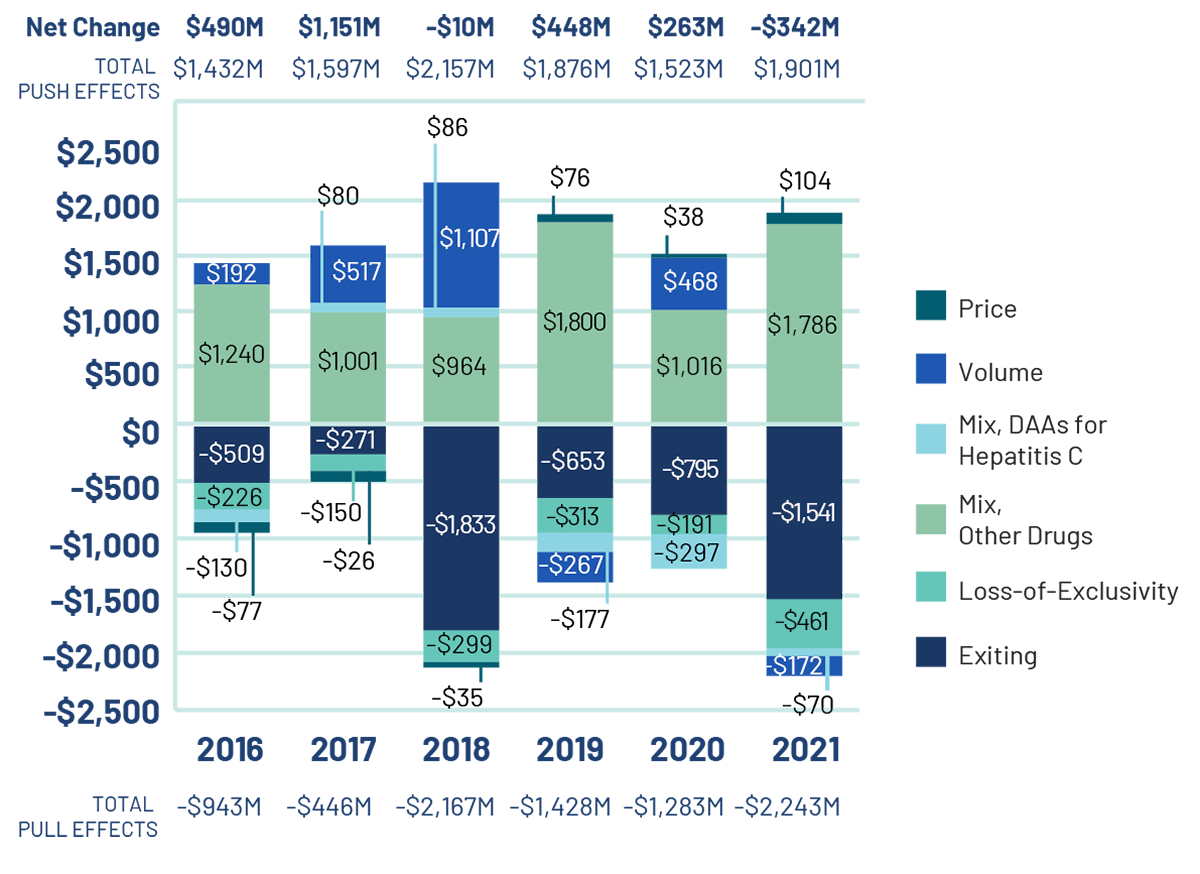
Figure description
These two bar graphs describe the factors that impacted the annual rates of change in the sales of patented medicines from 2016 to 2021. The first graph gives the rate of change in absolute dollar amounts and the second gives the corresponding percent rate of growth for each contributing factor along with the total push up (positive) and pull down (negative) effects. Direct-acting antiviral (DAA) medicines for hepatitis C are presented separately from the rest of the drug-mix effect because of their high impact.
(a) Absolute change in millions of dollars
| Exiting | Loss-of-Exclusivity | Mix, Other Drugs | Mix, DAAs for hepatitis C | Volume | Price | |
|---|---|---|---|---|---|---|
2016 |
-$509 |
-$226 |
$1,240 |
-$130 |
$192 |
-$77 |
2017 |
-$271 |
-$150 |
$1,001 |
$80 |
$517 |
-$26 |
2018 |
-$1,833 |
-$299 |
$964 |
$86 |
$1,107 |
-$35 |
2019 |
-$711 |
-$313 |
$1,800 |
-$177 |
-$267 |
$76 |
2020 |
-$795 |
-$191 |
$1,016 |
-$297 |
$468 |
$38 |
2021 |
-$,1541 |
-$461 |
$1,786 |
-$70 |
-$172 |
$104 |
| Absolute change (millions of dollars) | 2016 | 2017 | 2018 | 2019 | 2020 | 2021 |
|---|---|---|---|---|---|---|
Total Pull Effects |
-$943 |
-$446 |
-$2,167 |
-$1,428 |
-$1,283 |
-$2,243 |
Total Push Effects |
$1,432 |
$1,597 |
$2,157 |
$1,876 |
$1,523 |
$1,901 |
Net Change |
$490 |
$1,151 |
-$10 |
$448 |
$263 |
-$342 |
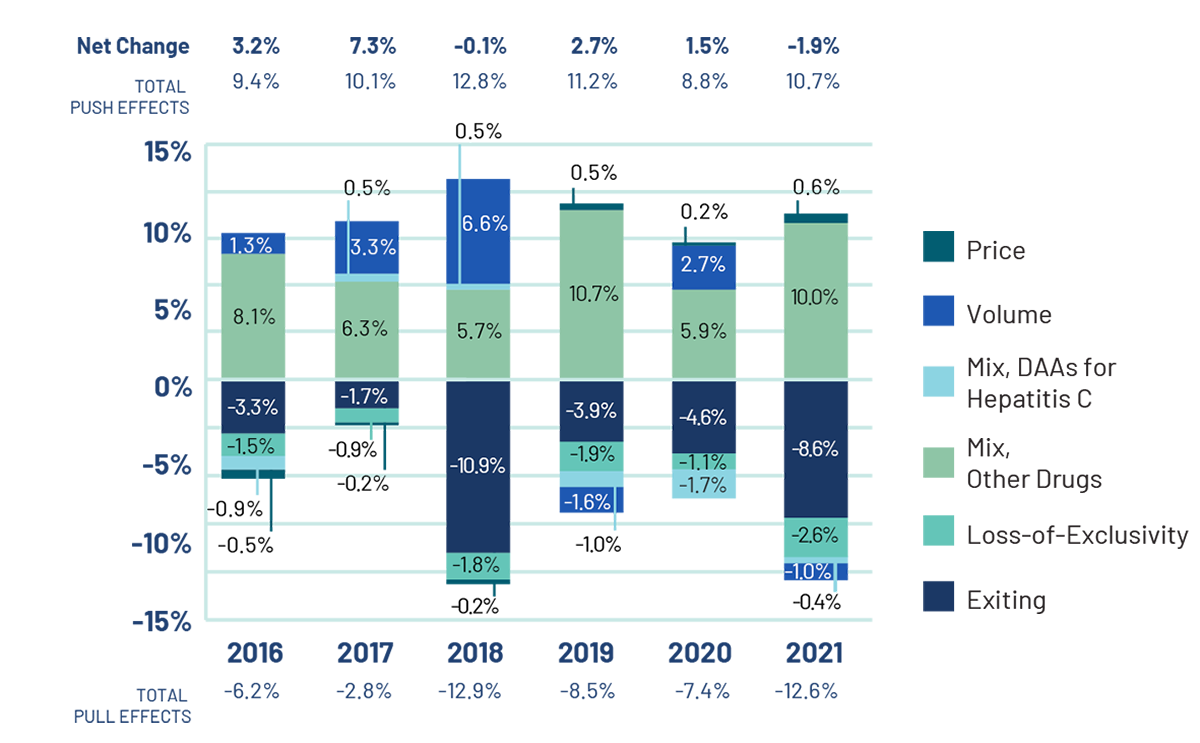
Note: When multiple factors change simultaneously, they create a residual or cross effect, which is not reported separately in this analysis, but is accounted for in the total cost change.
Values may not add to the net change due to rounding and the cross effect.
* As this model uses various measures to isolate the factors contributing to growth, the net change reported here may differ slightly from the reported overall change in the patented medicines market reported in Figure 3(b).
Data source: PMPRB
Figure description
(b) Relative change in percent
| Exiting | Loss-of-Exclusivity | Mix, Other Drugs | Mix, DAAs for hepatitis C | Volume | Price | |
|---|---|---|---|---|---|---|
2016 |
-3.3% |
-1.5% |
8.1% |
-0.9% |
1.3% |
-0.5% |
2017 |
-1.7% |
-0.9% |
6.3% |
0.5% |
3.3% |
-0.2% |
2018 |
-10.9% |
-1.8% |
5.7% |
0.5% |
6.6% |
-0.2% |
2019 |
-3.9% |
-1.9% |
10.7% |
-1.0% |
-1.6% |
0.5% |
2020 |
-4.6% |
-1.1% |
5.9% |
-1.7% |
2.7% |
0.2% |
2021 |
-8.6% |
-2.6% |
10.0% |
0.4% |
-1.0% |
0.6% |
| Relative change (in percent) | 2016 | 2017 | 2018 | 2019 | 2020 | 2021 |
|---|---|---|---|---|---|---|
Total Pull Effects |
-6.2% |
-2.8% |
-12.9% |
-8.5% |
-7.4% |
-12.6% |
Total Push Effects |
9.4% |
10.1% |
12.8% |
11.2% |
8.8% |
10.7% |
Net Change |
3.2% |
7.3% |
-0.1% |
2.7% |
1.5% |
-1.9% |
Changes in the prices of patented medicines have played a minor role in the growth in patented medicine sales over the last several years, suggesting that, on average, the prices of existing patented medicines are fairly stable. However, this does not reflect the overall increases in treatment costs due to the entry of newer, higher-priced patented medicines, the impact of which is captured by the mix effect.
The shift to new higher-cost patented medicines has been a major driver of sales growth in recent years. In 2021, the use of higher-cost patented medicines other than DAAs put an upward pressure on expenditures of $1.8 billion (push effect of 10.0%). While growth was observed in many therapeutic areas, the increase in sales of “antineoplastic and immunomodulating agents” exceeded that of any other class. These medicines, which include oncology treatments, accounted for more than 44% of all patented medicine sales in 2021. Results by therapeutic class are discussed in further detail in the upcoming sections.
Counterbalancing the upward sales pressure from the mix effect, there was a moderate market segment shift as some high-selling medicines stopped reporting their sales to the PMPRB. The exiting effect accounted for a pull effect of $1.54 billion (-8.6%) on sales in 2021. Figure 6 illustrates the change in the impact of the exiting effect since 2016 and identifies the 10 top-selling medicines that stopped reporting to the PMPRB in 2021.
Figure 6. Pull Effect on Patented Medicine Sales from the Exiting Effect, 2016 to 2021
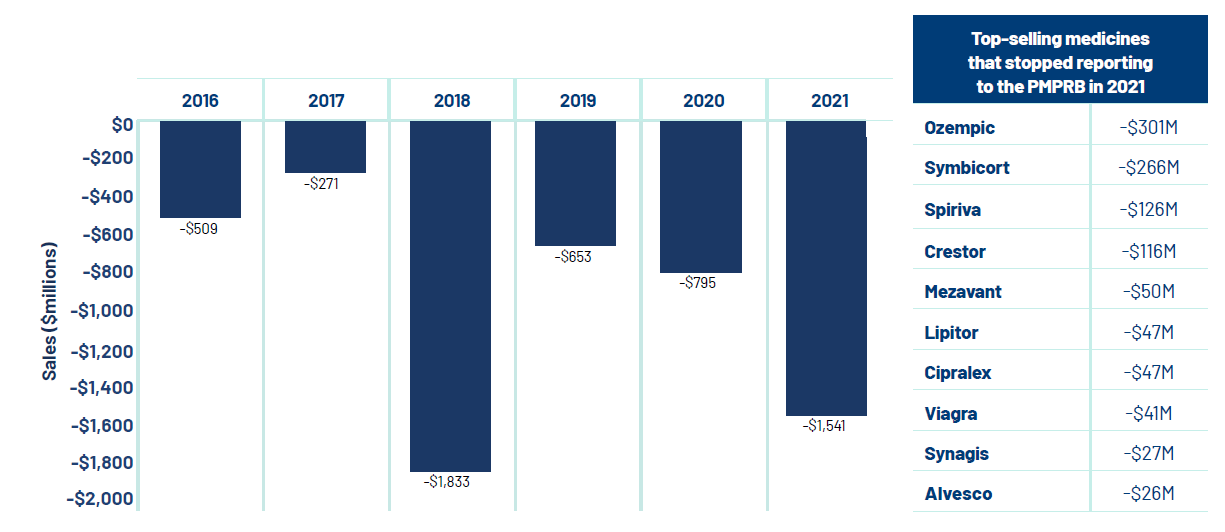
Note: If a medicine stops reporting a patent mid-way through the year, its impact may be reflected in the exiting effect in more than one reporting year.
The amounts reported in any given year may not reflect an entire year’s worth of sales for these medicines.
Data source: PMPRB
Figure description
This bar graph describes the change in patented medicine sales caused by patented medicines no longer reporting patents from 2016 to 2021. An accompanying table gives the change in sales for the top-selling medicines that stopped reporting patents in 2021.
| Year | Change in sales (millions of dollars) |
|---|---|
2016 |
-$509 |
2017 |
-$271 |
2018 |
-$1,833 |
2019 |
-$653 |
2020 |
-$795 |
2021 |
-$1,541 |
| Top-selling medicines that stopped reporting to the PMPRB in 2021 | Change in sales (millions of dollars) |
|---|---|
Ozempic |
-$301 |
Symbicort |
-$266 |
Spiriva |
-$126 |
Crestor |
-$116 |
Mezavant |
-$50 |
Lipitor |
-$47 |
Cipralex |
-$47 |
Viagra |
-$41 |
Synagis |
-$27 |
Alvesco |
-$26 |
Brief Insights: Cost Drivers of Public and Private Drug Plans
Canadian public drug plans and private insurers together account for over three quarters of all prescribed drug spending in Canada.i This includes sales for all products reimbursed by the plan, including but not limited to patented and non-patented brand medicines, patented and non-patented generic medicines, and non-patented single-source medicines.
Drug costs, including markups, represent the largest component of prescription drug expenditures and have the greatest influence on overall trends. Drug costs rose by 5.3% in public plans in 2019/20 and 4.0% in private plans in 2020.
The increasing use of higher-cost medicines is the primary cost driver for Canadian public and private drug plans. Over the past several years, higher-cost medicines (other than DAAs for hepatitis C) have exerted a consistent and significant upward pressure on expenditures, accounting for a 6.3% contribution toward drug costs in public plans in 2020-21 and 7.1% toward private plan costs in 2021.
The significant downward force exerted by generic pricing policies implemented in 2018 under the price change effect has stabilized, no longer offsetting the increasing cost pressures from the drug-mix effect. The pull-down effect from substitution became stronger than price effect, pulling drug costs down by 1.4% of public plans in 2020-21 and 1.0% of private plans in 2021. Additional savings are expected to be realized in the substitution effect in coming years as a result of recent biosimilar policy changes in many public drug plans, as well as initiatives introduced by some private payers aimed at promoting switching from biologic originators to available biosimilars. With a strong market for biologics in Canada, these efforts may act as a means of offsetting the mounting pressure from higher-cost medicines.
For public plans, a decrease in the number of active beneficiaries during the COVID-19 pandemic resulted in a pull effect of -2.0% on drug costs while a sizable increase in the number of claims per patient pushed overall spending upward by 4.3% over the same period. This rise was captured in the volume effect. Ontario OHIP+ program spending was consistent with 2019-20, and as such had little impact on drug cost growth in 2020-21.
(a) NPDUIS public drug plans*, 2015-16 to 2020-21
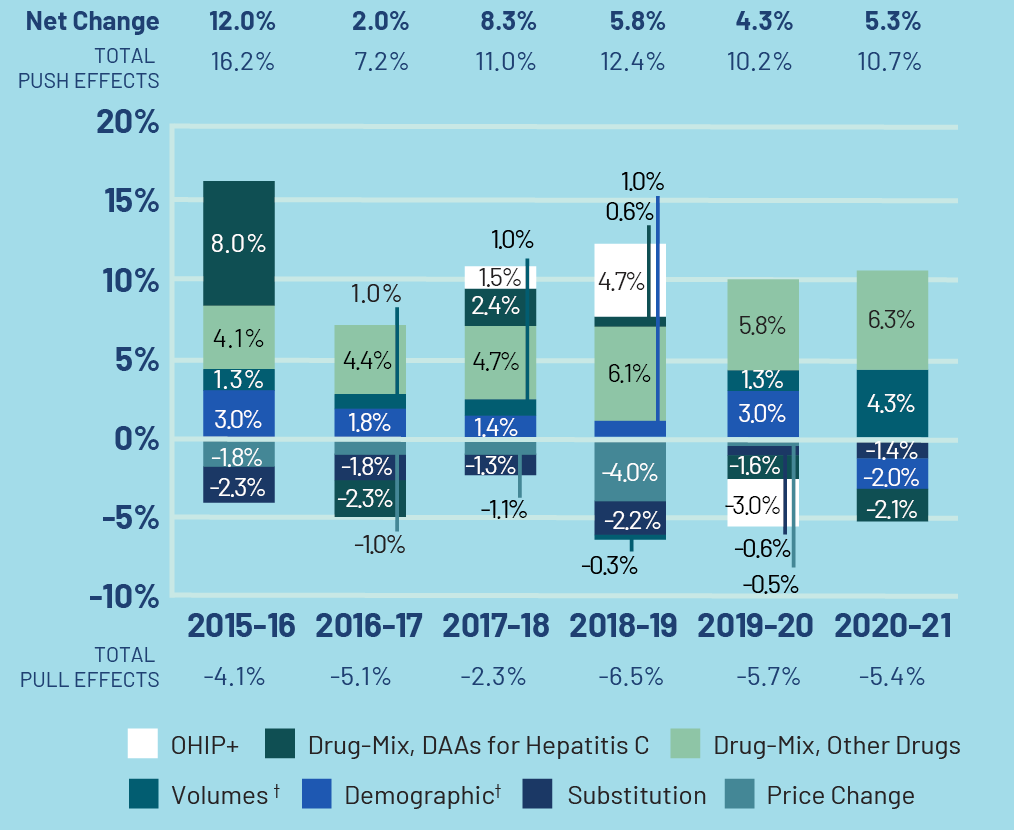
Figure description
These two bar graphs describe the factors that have impacted the annual rates of change in medicine costs for public and private plans. The first graph depicts the total for the combined NPDUIS public drug plans from fiscal year 2015-16 to 2020-21 and the second depicts the Canadian private drug plans from calendar year 2016 to 2021. The total positive or push effects, negative or pull effects, and net change are given above and below the bars for each year. Direct-acting antiviral (DAA) medicines for hepatitis C are presented separately from the rest of the drug-mix effect because of their high impact. The effects of the introduction of the OHIP+ program in Ontario are also shown separately from 2017-18 to 2019-20 in the public plan results and 2018 to 2019 in the private plan results.
(a) NPDUIS public drug plans*, 2015-16 to 2020-21
| 2015-16 | 2016-17 | 2017-18 | 2018-19 | 2019-20 | 2020-21 | |
|---|---|---|---|---|---|---|
OHIP+ |
– |
– |
1.5% |
4.7% |
-3.0% |
- |
Drug-Mix, DAAs for Hepatitis C |
8.0% |
-2.3% |
2.4% |
0.6% |
-1.6% |
-2.1% |
Drug-Mix, Others |
4.1% |
4.4% |
4.7% |
6.1% |
5.8% |
6.3% |
Volume |
1.3% |
1.0% |
1.0% |
-0.3% |
1.3% |
4.3% |
Demographic |
3.0% |
1.8% |
1.4% |
1.0% |
3.0% |
-2.0% |
Price Change |
-1.8% |
-1.0% |
-1.1% |
-4.0% |
-0.5% |
0.0% |
Substitution |
-2.3% |
-1.8% |
-1.3% |
-2.2% |
-0.6% |
-1.4% |
Total pull effects |
-4.1% |
-5.1% |
-2.3% |
-6.5% |
-5.7% |
-5.4% |
Total push effects |
16.2% |
7.2% |
11.0% |
12.4% |
10.2% |
10.7% |
Net change |
12.0% |
2.0% |
8.3% |
5.8% |
4.3% |
5.3% |
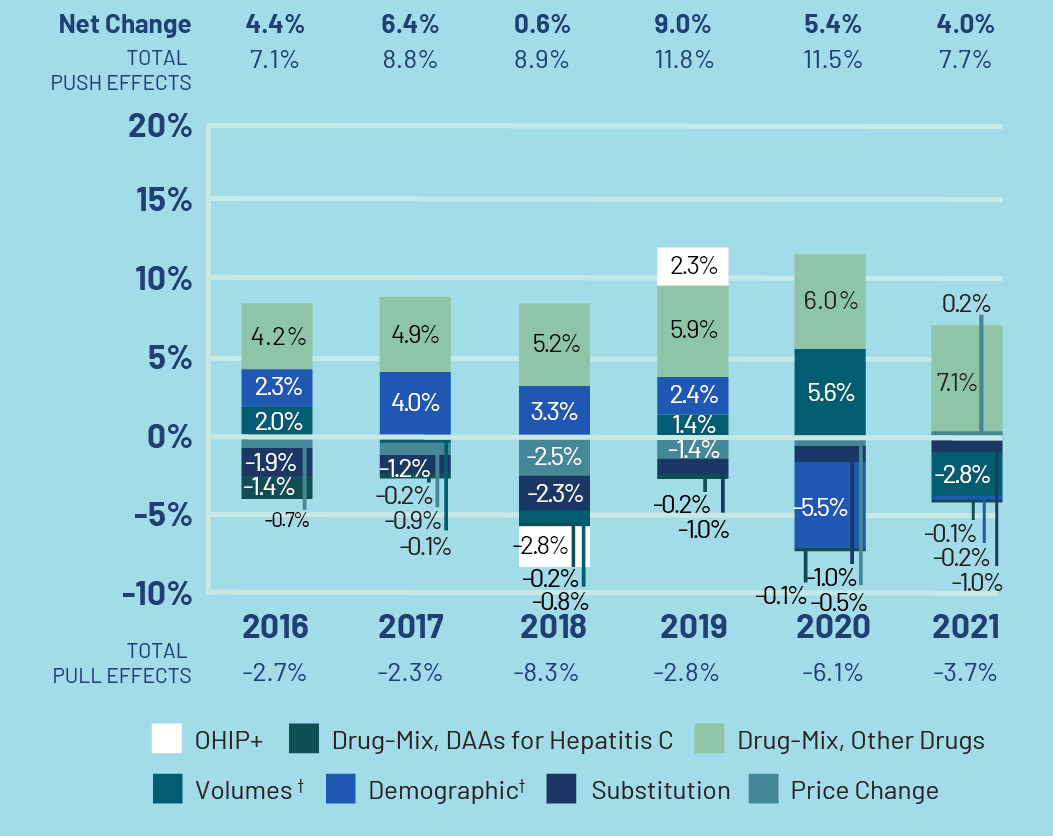
Note: Public plans report on a fiscal year basis and private plans report on the calendar year. This has an impact on the magnitude of the effect of policies such as the OHIP+ program or the generic pricing initiative introduced in 2018, for which most of the impact on public plans was felt in the 2018-19 fiscal year.
When multiple factors change simultaneously, they create a residual or cross effect, which is not reported separately in this analysis, but is accounted for in the total cost change.
Values may not add to the net change due to rounding and the cross effect.
* British Columbia, Alberta, Saskatchewan, Manitoba, Ontario, New Brunswick, Nova Scotia, Prince Edward Island, Newfoundland and Labrador, Yukon, and the Non-Insured Health Benefits Program
† A temporary partial data discontinuity from the private drug plans data supplier in 2021 influenced the results for the demographic and volume effects. As such, the next Annual Report may include a revised estimate of these effects for 2021.
Data source: NPDUIS database, Canadian Institute for Health Information; IQVIA Private Pay Direct Drug Plan database
i Canadian Institute for Health Information. 2020. Prescribed Drug Spending in Canada, 2020: A Focus on Public Drug Programs. Ottawa, ON: CIHI. Available: https://www.cihi.ca/sites/default/files/document/prescribed-drug-spending-in-canada-2020-report-en.pdf
[NPDUIS Report: CompassRx 2020/21; NPDUIS Poster: Pressures behind the Rising Costs in Canadian Private Drug Plans, 2018 – graph updated to 2021]
Figure description
(b) Private drug plans, 2016 to 2021
|
2016 |
2017 |
2018 |
2019 |
2020 |
2021 |
OHIP+ |
– |
– |
-2.8% |
2.3% |
– |
– |
Drug-Mix, DAAs for Hepatitis C |
-1.4% |
-0.2% |
-0.2% |
-0.2% |
-0.1% |
-0.1% |
Drug-Mix, Others |
4.2% |
4.9% |
5.2% |
5.9% |
6.0% |
7.1% |
Volume |
2.0% |
0.1% |
-0.8% |
1.4% |
5.6% |
-2.8% |
Demographic |
2.3% |
4.0% |
3.3% |
2.4% |
-5.5% |
-0.2% |
Price Change |
-0.7% |
-0.9% |
-2.5% |
-1.4% |
-0.5% |
0.2% |
Substitution |
-1.9% |
-1.2% |
-2.3% |
-1.0% |
-1.0% |
-1.0% |
Total pull effects |
-2.7% |
-2.3% |
-8.3% |
-2.8% |
-6.1% |
-3.7% |
Total push effects |
7.1% |
8.8% |
8.9% |
11.8% |
11.5% |
7.7% |
Net change |
4.4% |
6.4% |
0.6% |
9.0% |
5.4% |
4.0% |
Newer Medicines Driving Sales Revenues
Figure 8 breaks down the 2021 sales of patented medicines according to the year in which the medicine was first issued a Notice of Compliance (NOC) by Health Canada. Throughout the latter part of the 1990s and early 2000s, sales growth was largely driven by a succession of new “blockbuster” medicines that ultimately achieved very high sales volumes. As the patents for these medicines expired, their share of sales gradually decreased.
The introduction of new higher-cost medicines such as biologics, oncology medicines, and treatments for hepatitis C has accounted for a growing share of sales in recent years. Humira, which was issued an NOC in 2004, was the top-selling medicine in 2021, accounting for $887.8 million (5.1%) of total patented medicine sales (Table 8). Similarly, many new medicines introduced over the last decade also made the list of top-sellers in 2021, including Eylea (2013), Imbruvica (2014), Jardiance (2015), and Keytruda (2016).

Data source: PMPRB
Figure description
This bar graph depicts the share of sales of patented medicines by the year in which the medicine was first issued a NOC by Health Canada and approved for sale in Canada.
Medicines introduced before 2002 comprised 3.9% of 2021 sales;
2002: 0.6%;
2003: 0.5%;
2004: 6.5%;
2005: 1.2%;
2006: 1.9%;
2007: 2.1%;
2008: 6.2%;
2009: 5.5%;
2010: 3.9%;
2011: 3.3%;
2012: 5.9%;
2013: 9.2%;
2014: 8.7%;
2015: 10.4%;
2016: 11.1%;
2017: 7.4%;
2018: 5.3%;
2019: 3.7%;
2020: 2.2%;
2021: 0.4%.
Higher-Cost Medicines Driving Sales Revenues
Over the last decade, there has been a notable shift in pharmaceutical development toward more specialized medicines, with an increasing number of higher-cost medicines entering the market and accounting for a substantial share of sales.
In 2021, the trend in the shift to new or higher-cost medicines continued to put an upward pressure on overall patented medicine sales. The top 10 medicines contributed $800 million to the increase in sales (Table 7). Most of these medicines had an average annual treatment cost greater than $10,000.Footnote 9
| Medical Ingredient (Trade Name) | ATC* | Date of first NOC† | Sales ($millions) 2020 | Sales ($millions) 2021 | Absolute change in sales ($millions) 2020–2021 | Avg. annual treatment cost† 2021 |
|---|---|---|---|---|---|---|
Pembrolizumab |
L01 |
May-15 |
$370.5 |
$525.7 |
$155.2 |
$46,848 |
Aflibercept |
S01 |
Nov-13 |
$555.3 |
$673.6 |
$118.3 |
$9,824 |
Empagliflozin |
A10 |
Jul-15 |
$262.1 |
$346.0 |
$83.9 |
$729 |
Ustekinumab |
L04 |
Dec-08 |
$328.6 |
$410.1 |
$81.5 |
$25,139 |
Dupilumab |
D11 |
Nov-17 |
$101.3 |
$174.1 |
$72.8 |
$18,453 |
Onasemnogene abeparvovec |
M09 |
Dec-20 |
$8.6 |
$72.8 |
$64.2 |
$2.8M§ |
Apixaban |
B01 |
Dec-11 |
$373.3 |
$435.5 |
$62.2 |
$762 |
Risankizumab |
L04 |
Apr-19 |
$73.1 |
$132.2 |
$59.1 |
$17,617 |
Bictegravir/emtricitabine/tenofovir alafenamide |
J05 |
Jul-18 |
$135.7 |
$188.7 |
$53.1 |
$10,861 |
Lisdexamfetamine dimesylate |
N06 |
Feb-09 |
$229.0 |
$278.6 |
$49.5 |
$736 |
Total top 10 medicines** |
$2,437.5 |
$3,237.3 |
$799.8 |
Note: Highlighted medicines were also identified as top contributors in 2020.
E Expensive drugs for rare diseases (EDRDs), defined as a medicine with an orphan designation from the European Medicines Agency or the US Food and Drug Administration, as well as a treatment cost exceeding $100,000 per year or $10,000 per 28-day cycle for oncology.
* Level 2 of the Anatomic Therapeutic Chemical (ATC) Classification system maintained by the World Health Organization.
† Date of first Notice of Compliance or Notice of Compliance with Conditions issued by Health Canada.
‡ The annual treatment cost was calculated based on the average annual cost per active beneficiary in selected private drug plans. This amount may be underestimated.
§ Zolgensma cost is reflective of a one-time gene therapy treatment.
** Values may not add to totals due to rounding.
Data source: PMPRB, IQVIA Private Pay Direct Drug Plan database, 2021
While Table 7 reports the top 10 medicines contributing to the increase in the sales of patented medicines, Table 8 compares the 10 top-selling patented medicines in 2012 and 2021, along with their treatment costs. The shift towards higher-cost medicines is also evident in the list of top-selling patented medicines. Over the last 10 years, the average treatment cost of the top 10 medicines increased from $9,365 in 2012 to $23,121 in 2021. In 2021, four of the top 10 medicines were biologics, with annual treatment costs ranging from $9,284 to $46,848, while two of the top-selling non-biologic medicines in 2021 had an annual treatment cost exceeding $60,000. With collective annual sales of $4.7 billion, these 10 medicines accounted for over one quarter of the total sales for all patented medicines in 2021.
| 2012 | 2021 | ||||||||||
|---|---|---|---|---|---|---|---|---|---|---|---|
| Medicinal ingredient (Trade name) |
ATC* | Date of first NOC† | Avg. annual treatment cost | Sales ($millions) |
Share of patented sales |
Medicinal ingredient (Trade name) |
ATC* | Date of first NOC† | Avg. annual treatment cost | Sales ($millions) |
Share of patented sales |
1. Infliximab (Remicade) |
L04A |
01-Jun |
$23,080 |
$397 |
3.1% |
1. Adalimumab (Humira) |
L04A |
04-Sep |
$18,997 |
$888 |
5.1% |
2. Adalimumab (Humira) |
L04A |
04-Sep |
$14,115 |
$366 |
2.8% |
2. Aflibercept (Eylea) |
S01L |
13-Nov |
$9,284 |
$674 |
3.9% |
3. Ranibizumab (Lucentis) |
S01L |
07-Jun |
$7,879 |
$311 |
2.4% |
3. Lenalidomide (Revlimid)E |
L04A |
08-Jan |
$62,914 |
$538 |
3.1% |
4. Etanercept (Enbrel) |
L04A |
00-Dec |
$13,115 |
$292 |
2.3% |
4. Pembroli-zumab (Keytruda)E |
L01X |
15-May |
$46,848 |
$526 |
3.0% |
5. Pregabalin (Lyrica) |
N03A |
05-Jun |
$673 |
$219 |
1.7% |
5. Apixaban (Eliquis) |
B01A |
11-Dec |
$762 |
$436 |
2.5% |
6. Escitalopram oxalate (Cipralex) |
N06A |
04-Dec |
$370 |
$210 |
1.6% |
6. Ustekinumab (Stelara) |
L04A |
08-Dec |
$25,139 |
$410 |
2.4% |
7. Rituximab (Rituxan) |
L01X |
00-Mar |
$12,622 |
$199 |
1.5% |
7. Ibrutinib (Imbruvica)E |
L01X |
14-Nov |
$65,147 |
$350 |
2.0% |
8. Tiotropium bromide monohydrate (Spiriva) |
R03B |
02-Nov |
$441 |
$182 |
1.4% |
8. Empagliflozin (Jardiance) |
A10B |
15-Jul |
$729 |
$346 |
2.0% |
9. Trastuzumab (Herceptin) |
L01X |
99-Aug |
$20,868 |
$175 |
1.4% |
9. Rivaroxaban (Xarelto) |
B01A |
08-Sep |
$656 |
$296 |
1.7% |
10. Ezetimibe (Ezetrol) |
C10A |
03-May |
$493 |
$167 |
1.3% |
10. Lisdexam- |
N06B |
09-Feb |
$736 |
$279 |
1.6% |
Total top 10 medicines‡ |
$9,365 ($7,147)§ |
$2,517 |
19.6% |
Total top 10 medicines‡ |
$23,121 ($20,836)§ |
$4,740 |
27.3% |
||||
Total patented medicines |
$12,885 |
Total patented medicines |
$17,446 |
||||||||
Note: Biologic medicines are highlighted.
E Expensive drugs for rare diseases (EDRDs), defined as a medicine with an orphan designation from the European Medicines Agency or the US Food and Drug Administration, as well as a treatment cost exceeding $100,000 per year or $10,000 per 28-day cycle for oncology.
* Level 3 of the Anatomic Therapeutic Chemical (ATC) classification system maintained by the World Health Organization.
† Date of first Notice of Compliance or Notice of Compliance with Conditions issued by Health Canada.
‡ Values may not add to totals due to rounding.
§ Sales-weighted average annual treatment cost ($)
Data source: PMPRB, IQVIA Private Pay Direct Drug Plan database, 2021
Figure 9 details the trend in the treatment costs of patented medicines since 2006. For many years, the majority of the 20 top-selling patented medicines had annual treatment costs under $1,000, but in recent years, costs for the top-sellers have soared into the thousands or tens of thousands of dollars. In 2021, the top 20 medicines, which accounted for 39.6% of patented medicine sales, had a median annual treatment cost of $42,616, nearly 60 times the median in 2012.
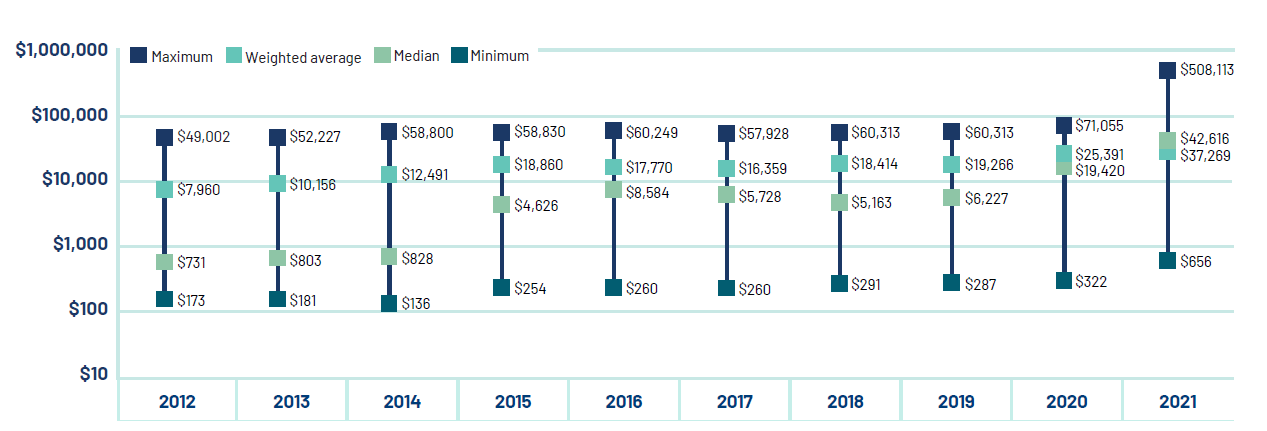
Data source: PMPRB; IQVIA Private Pay Direct Drug Plan database, 2012–2021
Figure description
This graph depicts the minimum, maximum, median, and weighted average annual treatment costs for the 20 top-selling patented medicines sold in Canada from 2012 to 2021.
| Treatment cost | 2012 | 2013 | 2014 | 2015 | 2016 | 2017 | 2018 | 2019 | 2020 | 2021 |
|---|---|---|---|---|---|---|---|---|---|---|
Maximum |
$49,002 |
$52,227 |
$58,800 |
$58,830 |
$60,249 |
$57,928 |
$60,313 |
$60,313 |
$71,055 |
$508,113 |
Weighted average |
$7,960 |
$10,156 |
$12,491 |
$18,860 |
$17,770 |
$16,359 |
$18,414 |
$19,266 |
$25,391 |
$37,269 |
Median |
$731 |
$803 |
$828 |
$4,626 |
$8,584 |
$5,728 |
$5,163 |
$6,227 |
$19,420 |
$42,616 |
Minimum |
$173 |
$181 |
$136 |
$254 |
$260 |
$260 |
$291 |
$287 |
$322 |
$656 |
Figure 10 shows that high-cost medicines represent an increasingly significant share of the total sales of patented medicines, rising steeply from 17.3% in 2012 to 57.1% in 2021. This growth was evident in all ranges of annual treatment costs ($10,000 to $20,000; $20,000 to $50,000; $50,000 to $100,000; and $100,000 and over), with medicines in the highest cost band climbing from 0.6% to 5.0% of sales over the same period. Despite the sharp increase in their share of costs, less than 1% of the population use these medicines.
High-cost treatments continue to dominate the pharmaceutical landscape
The 20 top-selling medicines in 2021 had a median annual treatment cost of $42,616, nearly 60x the median in 2012.

Note: The methodology for this analysis was revised in 2018, and as such, historical results may not match those reported in earlier editions.
* Values may not add to totals due to rounding.
Data source: PMPRB; IQVIA Private Pay Direct Drug Plan database, 2012–2021
Figure description
This bar graph depicts the high-cost medicine share of total patented medicine sales per year by annual treatment cost from 2012 to 2021. The bars are subdivided into four bands based on average annual treatment cost: $10 to $20 thousand; $20 to $50 thousand; $50 to $100 thousand; and greater than $100 thousand.
| Year | Share of sales for medicines costing $10 to $20 thousand | Share of sales for medicines costing $20 to $50 thousand | Share of sales for medicines costing $50 to $100 thousand | Share of sales for medicines costing greater than $100 thousand | Total share of sales of high-cost medicines |
|---|---|---|---|---|---|
2012 |
7.9% |
7.7% |
1.1% |
0.6% |
17.3% |
2013 |
9.1% |
10.5% |
1.4% |
0.8% |
21.8% |
2014 |
9.8% |
11.7% |
3.2% |
1.0% |
25.7% |
2015 |
11.0% |
13.4% |
7.7% |
1.2% |
33.3% |
2016 |
12.9% |
15.6% |
6.9% |
1.4% |
36.8% |
2017 |
14.4% |
20.2% |
5.2% |
1.5% |
41.3% |
2018 |
15.1% |
19.4% |
5.8% |
1.8% |
42.1% |
2019 |
17.6% |
18.7% |
8.6% |
3.4% |
48.3% |
2020 |
19.2% |
18.4% |
10.4% |
4.1% |
52.1% |
2021 |
19.9% |
19.8% |
12.4% |
5.0% |
57.1% |
The table below the graph gives additional information including the medicine cost, the number of medicines, the average annual treatment cost, and the estimated treatment population and corresponding share of total Canadian population.
| - | 2012 | 2013 | 2014 | 2015 | 2016 | 2017 | 2018 | 2019 | 2020 | 2021 |
|---|---|---|---|---|---|---|---|---|---|---|
Medicine cost (millions of dollars) |
$2,882 |
$3,624 |
$4,284 |
$5,549 |
$6,141 |
$6,864 |
$6,996 |
$8,330 |
$9,124 |
$9,956 |
Total number of medicines |
92 |
105 |
116 |
129 |
143 |
150 |
162 |
172 |
189 |
201 |
Number of medicines costing $10,000 to $20,000 |
37 |
39 |
40 |
42 |
44 |
47 |
49 |
52 |
57 |
60 |
Number of medicines costing $20,000 to $50,000 |
40 |
45 |
50 |
58 |
68 |
69 |
73 |
71 |
74 |
74 |
Number of medicines costing $50,000 to $100,000 |
6 |
11 |
15 |
17 |
18 |
20 |
24 |
29 |
35 |
38 |
Number of medicines costing more than $100,000 |
9 |
10 |
11 |
12 |
13 |
14 |
16 |
20 |
23 |
29 |
Avg. treatment cost (thousands of dollars) |
$38.1 |
$37.8 |
$41.4 |
$44.8 |
$43.5 |
$42.7 |
$45.8 |
$51.8 |
$53.9 |
$59.0 |
Estimated treatment population (thousands) |
136.9 |
167.2 |
186.9 |
222.4 |
254.1 |
284.8 |
285.8 |
331.3 |
349.8 |
370.3 |
Share total Canadian population |
0.39% |
0.48% |
0.53% |
0.62% |
0.70% |
0.77% |
0.78% |
0.88% |
0.92% |
0.97% |
Brief Insights: High-Cost Medicines in Public Drug Plans
High-cost medicines account for approximately 35% of all public drug plan expenditures. This is lower than the share for patented medicines reported in Figure 10 because public plan costs also include non-patented generic and non-patented single-source medicines.
Public plans reimbursed 135 high-cost medicines in fiscal year 2020-21, while private drug plans reimbursed 247 high-cost medicines in calendar 2021.

Note: High-cost medicines are defined as having an annual treatment cost greater than $10,000. If medicines reach this threshold in any given year, they are included in the count for all other years. Thus, the number and composition of high-cost medicines in any given year may vary depending on the time of analysis.
The number of oncology medicines and other high-cost medicines covered by public plans may be underestimated, as some are reimbursed through specialized programs, such as cancer care, that are not captured in the data.
Values may not add to totals due to rounding.
* British Columbia, Alberta, Saskatchewan, Manitoba, Ontario, New Brunswick, Nova Scotia, Prince Edward Island, Newfoundland and Labrador, Yukon, and the Non-Insured Health Benefits (NIHB) Program. Results for 2020-21 do not include the NIHB program.
† DAA: Direct-acting antivirals for the treatment for hepatitis C, which were launched in 2014 and 2015. See earlier cost driver analysis (Figure 7) for more information.
‡ The total number of high-cost medicines reimbursed by the NPDUIS public drug plans is calculated using prescription drug utilization data, which includes claims for all medicines funded by public plans, and does not necessarily reflect the number of medicines listed on the formularies for these plans.
Data source: NPDUIS database, Canadian Institute for Health Information (fiscal year data)
[NPDUIS Report: CompassRx 2020/21 (pre-publication results)]
Figure description
This stacked bar graph depicts the high-cost medicine share of total medicine costs for the NPDUIS public drug plans from fiscal year 2015-16 to 2020-21. The bars are subdivided into bands based on average annual costs per active beneficiary: $10 to $20 thousand; $20 to $50 thousand; and more than $50 thousand. The share of new direct-acting antiviral (DAA) medicines for hepatitis C is reported separately. An accompanying table gives the total number of high-cost medicines, the share of beneficiaries using these medicines, and the share of prescriptions they represent.
| 2015-16 | 2016-17 | 2017-18 | 2018-19 | 2019-20 | 2020-21 | |
|---|---|---|---|---|---|---|
| Medicine cost in millions of dollars | $2,252.3 | $2,347.5 | $2,829.0 | $3,288.3 | $3,426.0 | $3,483.9 |
| Total number of medicines | 95 | 103 | 107 | 121 | 130 | 135 |
| Average cost per active beneficiary of $10,000‒$20,000: share of total medicine cost | 9.3% | 10.3% | 10.7% | 12.0% | 12.7% | 14.0% |
| Average cost per active beneficiary of $20,000‒$50,000: share of total medicine cost | 7.9% | 8.9% | 9.1% | 9.9% | 11.3% | 11.9% |
| Average cost per active beneficiary of greater than $50,000: share of total medicine cost for medicines other than DAAs for hepatitis C | 2.7% | 3.6% | 4.1% | 4.9% | 5.8% | 7.0% |
| Average cost per active beneficiary of greater than $50,000: share of total medicine cost for DAAs | 7.4% | 5.2% | 7.2% | 7.2% | 4.2% | 1.8% |
| High-cost medicines - share of active beneficiaries | 1.58% | 1.73% | 1.75% | 1.72% | 2.12% | 2.51% |
| High-cost medicines - share of total prescriptions | 0.28% | 0.30% | 0.34% | 0.38% | 0.40% | 0.42% |
High-cost medicines continue to account for an increasing share of all patented medicine sales
Over the last decade, the number of medicines with average annual treatment costs of over $100,000 more than tripled from 9 to 29. These medicines now account for 5.0% of all patented medicine sales.
The shift toward higher-cost treatments is especially evident in oncology medicines. Figure 12 shows the share of total sales for patented oncology medicines by treatment cost based on a standard 28-day treatment regimen.Footnote 10
The number of patented oncology medicines with 28-day treatment costs over $7,500 rose from 10 to 58 between 2012 and 2021, now accounting for 16.8% of total patented medicine sales.
As a result, the average treatment cost for oncology medicines in 2021 was $13,478, double the average cost in 2015 and close to four times that in 2006.
Many treatment regimens use multiple medicines resulting in even higher treatment costs per beneficiary. The dual pressures of increasing average treatment costs and growing utilization mean that this therapeutic area is likely to continue to grow as a proportion of patented medicine sales.
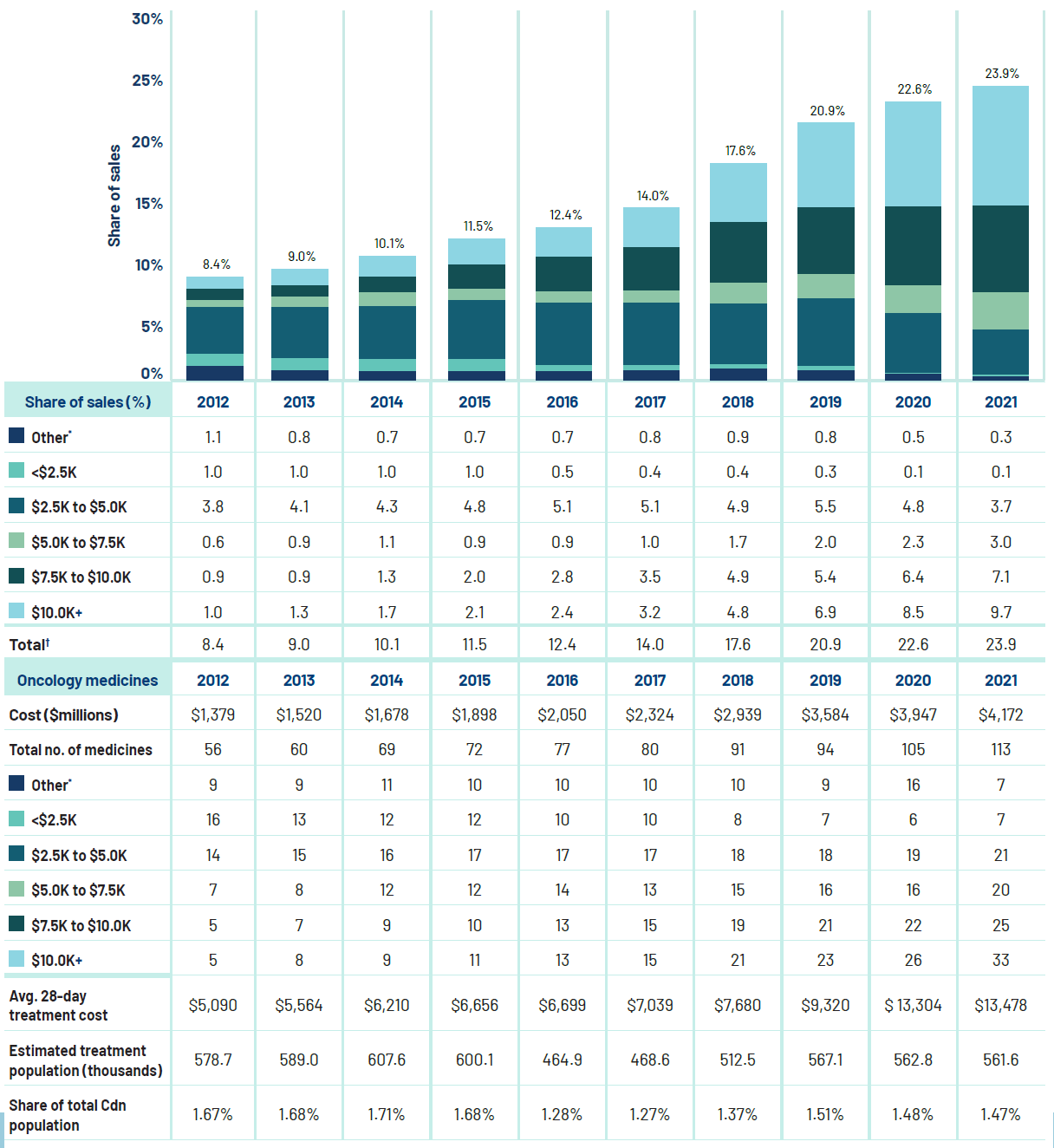
Note: The methodology for this analysis was revised in 2018 and 2019, and as such, historical results may not match those reported in earlier editions. These results reflect the total sales for patented medicines used in the treatment of cancer. While some of these medicines may also be used to treat other conditions, the data used for this analysis does not distinguish between indications, and thus, the reported sales may reflect some non-cancer use.
* Treatment costs for these medicines are not available.
† Values may not add to totals due to rounding.
Data source: PMPRB; CADTH pCODR
Figure description
This bar graph depicts the patented oncology medicine share of total patented medicine sales from 2012 to 2021. The bars are subdivided into six bands based on the average 28-day treatment cost: medicines whose costs are not available; medicines costing less than $2.5 thousand; $2.5 to $5.0 thousand; $5.0 to $7.5 thousand; $7.5 to $10.0 thousand; and more than $10.0 thousand.
| Year | Share of sales for patented oncology medicines for which treatment cost is unavailable | Share of sales for patented oncology medicines for which treatment cost is less than $2,500 | Share of sales for patented oncology medicines for which treatment cost is $2,500 to $5,000 | Share of sales for patented oncology medicines for which treatment cost is $5,000 to $7,500 | Share of sales for patented oncology medicines for which treatment cost is $7,500 to $10,000 | Share of sales for patented oncology medicines for which treatment cost is more than $10,000 | Total share of sales for patented oncology medicines |
|---|---|---|---|---|---|---|---|
2012 |
1.1% |
1.0% |
3.8% |
0.6% |
0.9% |
1.0% |
8.4% |
2013 |
0.8% |
1.0% |
4.1% |
0.9% |
0.9% |
1.3% |
9.0% |
2014 |
0.7% |
1.0% |
4.3% |
1.1% |
1.3% |
1.7% |
10.1% |
2015 |
0.7% |
1.0% |
4.8% |
0.9% |
2.0% |
2.1% |
11.5% |
2016 |
0.7% |
0.5% |
5.1% |
0.9% |
2.8% |
2.4% |
12.4% |
2017 |
0.8% |
0.4% |
5.1% |
1.0% |
3.5% |
3.2% |
14.0% |
2018 |
0.9% |
0.4% |
4.9% |
1.7% |
4.9% |
4.8% |
17.6% |
2019 |
0.8% |
0.3% |
5.5% |
2.0% |
5.4% |
6.9% |
20.9% |
2020 |
0.5% |
0.1% |
4.8% |
2.3% |
6.4% |
8.5% |
22.6% |
2021 |
0.3% |
0.1% |
3.7% |
3.0% |
7.1% |
9.7% |
23.9% |
The table below the graph gives additional information including the medicine cost, the number of medicines, the average 28-day treatment cost, and the estimated treatment population and corresponding share of total Canadian population.
| Oncology medicines | 2012 | 2013 | 2014 | 2015 | 2016 | 2017 | 2018 | 2019 | 2020 | 2021 |
|---|---|---|---|---|---|---|---|---|---|---|
Cost (millions of dollars) |
$1,379 |
$1,520 |
$1,678 |
$1,898 |
$2,050 |
$2,324 |
$2,939 |
$3,584 |
$3,947 |
$4,172 |
Total number of medicines |
56 |
60 |
69 |
72 |
77 |
80 |
91 |
94 |
105 |
113 |
Number of medicines for which cost is unavailable |
9 |
9 |
11 |
10 |
10 |
10 |
10 |
9 |
16 |
7 |
Number of medicines costing less than $2,500 |
16 |
13 |
12 |
12 |
10 |
10 |
8 |
7 |
6 |
7 |
Number of medicines costing $2,500 to $5,000 |
14 |
15 |
16 |
17 |
17 |
17 |
18 |
18 |
19 |
21 |
Number of medicines costing $5,000 to $7,500 |
7 |
8 |
12 |
12 |
14 |
13 |
15 |
16 |
16 |
20 |
Number of medicines costing $7,500 to $10,000 |
5 |
7 |
9 |
10 |
13 |
15 |
19 |
21 |
22 |
25 |
Number of medicines costing more than $10,000 |
5 |
8 |
9 |
11 |
13 |
15 |
21 |
23 |
26 |
33 |
Average |
$5,090 |
$5,564 |
$6,210 |
$6,656 |
$6,699 |
$7,039 |
$7,680 |
$9,320 |
$13,304 |
$13,478 |
Estimated treatment population (thousands) |
578.7 |
589.0 |
607.6 |
600.1 |
464.9 |
468.6 |
512.5 |
567.1 |
562.8 |
561.6 |
Share total Canadian population |
1.67% |
1.68% |
1.71% |
1.68% |
1.28% |
1.27% |
1.37% |
1.51% |
1.48% |
1.47% |
Brief Insights: Spending on Expensive Drugs for Rare Diseases
Expensive drugs for rare diseases (EDRDs) represent an increasing share of the Canadian pharmaceutical market, due to sales growth of existing medicines as well as the rapid pace of new launches, with at least 10 new EDRDs gaining approval each year since 2015. Growth in EDRD sales has vastly outpaced the total pharmaceutical market, rising from 1.7% of expenditures in 2012 to 12.2% in 2021. Three quarters of EDRD spending in 2021 was for oncology medicines.
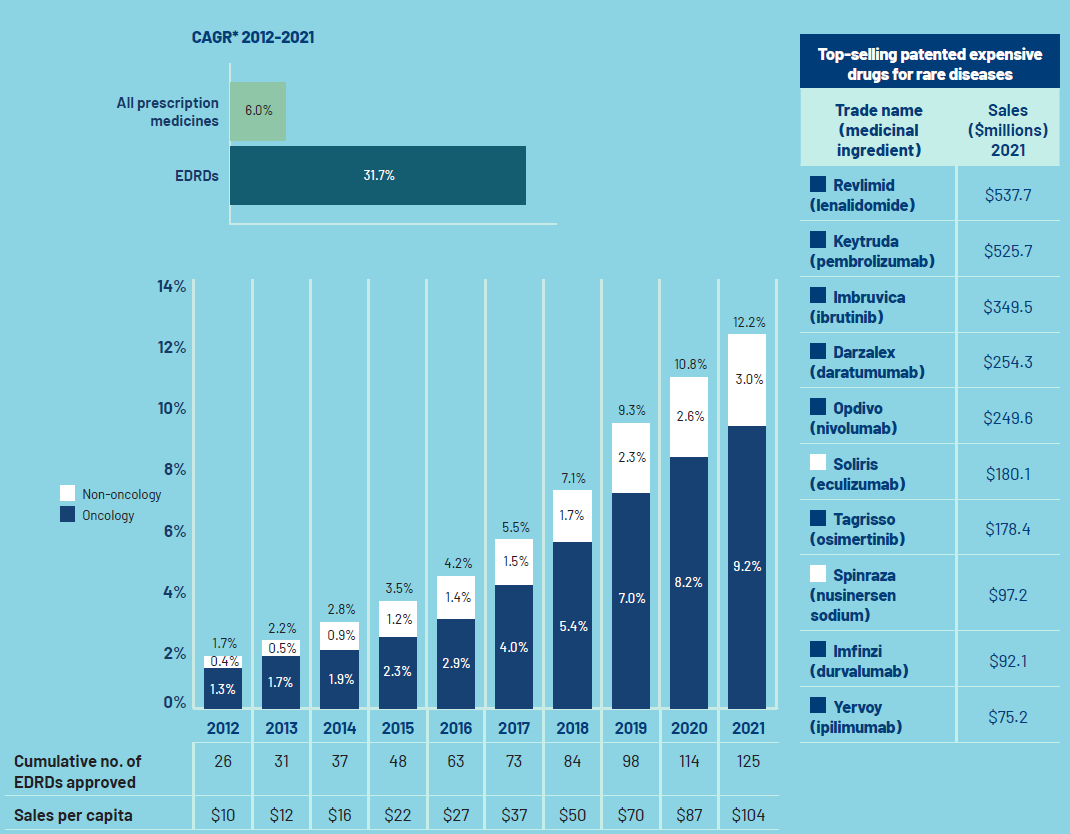
Note: The data for this analysis was updated and, as such, historical results may not match those reported in previous editions. The count of EDRDs for 2016–2020 has also been revised to include medicines newly classified as EDRDs.
For this analysis, EDRDs are defined as medicines with at least one orphan designation (by the US Food and Drug Administration or the European Medicines Agency) and estimated treatment costs exceeding $100,000 per year for non-oncology drugs or $7,500 per 28 days for oncology drugs.
* Compound annual growth rate (CAGR) of expenditures over the study period
Data source: PMPRB; MIDAS® database, 2012–2021, IQVIA (all rights reserved)
[NPDUIS Chartbook: Expensive Drugs for Rare Diseases: Canadian Trends and International Comparisons, 2011–2020 – content updated for 2021]
Figure description
This stacked bar graph depicts the market shares held by oncology and non-oncology expensive drugs for rare diseases in Canada from 2012 to 2021. The compound annual growth rate for all Canadian pharmaceutical sales over that period was 6.0%; for expensive drugs for rare diseases, this growth rate was 31.7%. A table below the graph gives the cumulative number of EDRDs approved as well as the Canadian EDRD sales per capita for each year.
| Share of Canadian pharmaceutical sales | 2012 | 2013 | 2014 | 2015 | 2016 | 2017 | 2018 | 2019 | 2020 | 2021 |
|---|---|---|---|---|---|---|---|---|---|---|
Oncology EDRDs |
1.3% |
1.7% |
1.9% |
2.3% |
2.9% |
4.0% |
5.4% |
7.0% |
8.2% |
9.2% |
Non-oncology EDRDs |
0.4% |
0.5% |
0.9% |
1.2% |
1.4% |
1.5% |
1.7% |
2.3% |
2.6% |
3.0% |
Total EDRDs |
1.7% |
2.2% |
2.8% |
3.5% |
4.2% |
5.5% |
7.1% |
9.3% |
10.8% |
12.2% |
Cumulative no. of EDRDs approved |
26 |
31 |
37 |
48 |
63 |
73 |
84 |
98 |
114 |
125 |
EDRD sales per capita |
$10 |
$12 |
$16 |
$22 |
$27 |
$37 |
$50 |
$70 |
$87 |
$104 |
An additional table lists the 10 top-selling patented expensive drugs for rare diseases in 2021, along with their annual sales, in millions of dollars.
Top-selling patented expensive drugs for rare diseases in 2021 |
Oncology or non-oncology |
2021 sales (millions of dollars) |
|---|---|---|
Revlimid |
Oncology |
$537.7 |
Keytruda |
Oncology |
$525.7 |
Imbruvica (ibrutinib) |
Oncology |
$349.5 |
Darzalex (daratumumab) |
Oncology |
$254.3 |
Opdivo (nivolumab) |
Oncology |
$249.6 |
Soliris (eculizumab) |
Non-oncology |
$180.1 |
Tagrisso (osimertinib) |
Oncology |
$178.4 |
Spinraza (nusinersen sodium) |
Non-oncology |
$97.2 |
Imfinzi (durvalumab) |
Oncology |
$92.1 |
Yervoy |
Oncology |
$75.2 |
Top Therapeutic Classes Driving Sales Revenues
“Antineoplastics and immunomodulating agents”, “alimentary tract and metabolism”, and “general antiinfectives for systemic use and antiparasitic products” were the three top-selling therapeutic classes in 2021, accounting for close to two thirds of all patented medicine sales. The “antineoplastics and immunomodulating agents” class experienced a 7.3% increase in sales between 2020 and 2021 while “respiratory system products” had the greatest year-over-year decrease at -45.3%.
Figure 14 breaks down the sales of patented medicines in Canada by therapeutic class using level 1 of the World Health Organization’s (WHO) Anatomical Therapeutic Chemical (ATC) system.Footnote 11 It compares the distribution of sales by therapeutic class in 2012 and 2021 and provides the rates of growth in sales for each class from 2020 to 2021.
The “antineoplastics and immunomodulating agents” class accounted for a much larger share of sales in 2021 (44.2%) than in 2012 (25.4%), as more oncology medicines entered the market over the past decade, many of which were high-cost. By contrast, the share of sales held by “cardiovascular system” medicines decreased dramatically from 10.5% to 2.2% over the same period, continuing the trend observed in previous years.
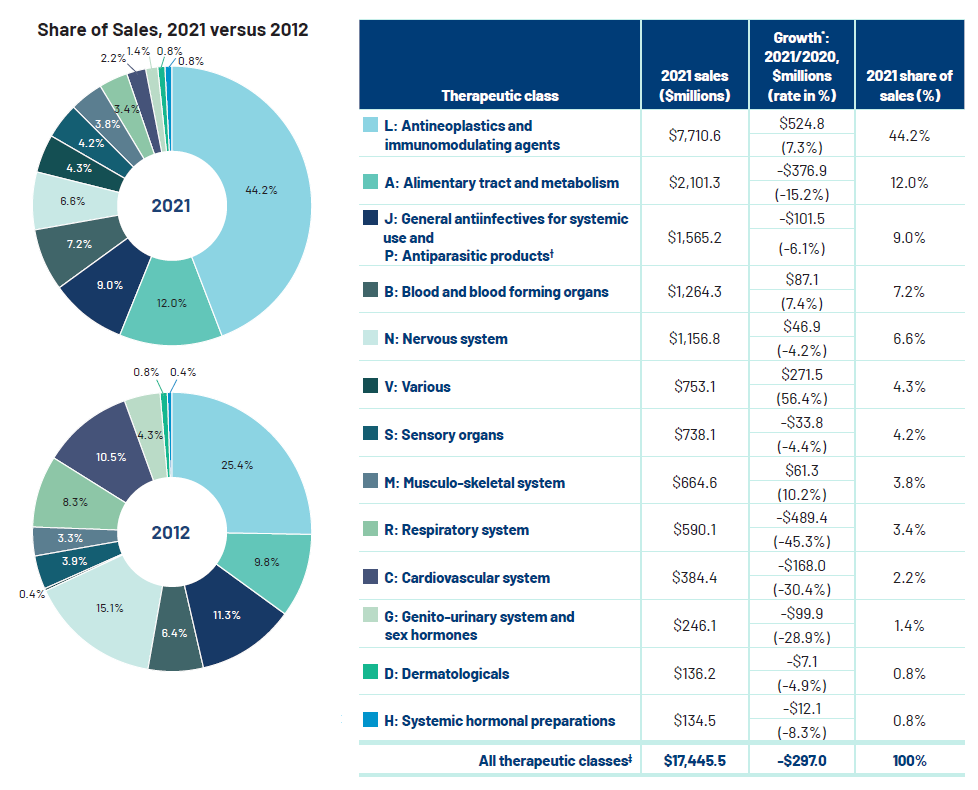
* Medicines that stop reporting their sales to the PMPRB can factor into growth rates for the relevant therapeutic areas. Please refer to Figures 5 and 6 for a discussion on medicines that exited the patented market in 2021.
† These groups have been combined for reasons of confidentiality.
‡ Values may not add to totals due to rounding.
Data source: PMPRB
Figure description
These two pie charts depict the sales of patented medicines as a percentage of all medicine sales by therapeutic class in 2021 and 2012.
| Therapeutic class | 2021 Share of sales (%) | 2012 Share of sales (%) |
|---|---|---|
L: Antineoplastics and immunomodulating agents |
44.2 |
25.4 |
A: Alimentary tract and metabolism |
12.0 |
9.8 |
J: General antiinfectives for systemic use and P: Antiparasitic products |
9.0 |
11.3 |
B: Blood and blood forming organs |
7.2 |
6.4 |
N: Nervous system |
6.6 |
15.1 |
V: Various |
4.3 |
0.4 |
S: Sensory organs |
4.2 |
3.9 |
M: Musculo-skeletal system |
3.8 |
3.3 |
R: Respiratory system |
3.4 |
8.3 |
C: Cardiovascular system |
2.2 |
10.5 |
G: Genito-urinary system and sex hormones |
1.4 |
4.3 |
D: Dermatologicals |
0.8 |
0.8 |
H: Systemic hormonal preparations |
0.8 |
0.4 |
The accompanying table gives the 2021 total sales by therapeutic class, the growth in sales (millions of dollars) and the growth rate (percent) from 2020 to 2021, and the 2021 share of sales.
| Therapeutic class | 2021 sales (millions of dollars) | Growth*: 2021 in millions of dollars (rate in %) |
2021 share of sales (%) |
|---|---|---|---|
L: Antineoplastics and immunomodulating agents |
$7,710.6 |
$524.8 (7.3%) |
44.2% |
A: Alimentary tract and metabolism |
$2,101.3 |
-$376.9 (-15.2%) |
12.0% |
J: General antiinfectives for systemic P: Antiparasitic products† |
$1,565.2 |
-$101.5 (-6.1%) |
9.0% |
B: Blood and blood forming organs |
$1,264.3 |
$87.1 (7.4%) |
7.2% |
N: Nervous system |
$1,156.8 |
$46.9 (-4.2%) |
6.6% |
V: Various |
$753.1 |
$271.5 (56.4%) |
4.3% |
S: Sensory organs |
$738.1 |
-$33.8 (-4.4%) |
4.2% |
M: Musculo-skeletal system |
$664.6 |
$61.3 (10.2%) |
3.8% |
R: Respiratory system |
$590.1 |
-$489.4 (-45.3%) |
3.4% |
C: Cardiovascular system |
$384.4 |
-$168.0 (-30.4%) |
2.2% |
G: Genito-urinary system and |
$246.1 |
-$99.9 (-28.9%) |
1.4% |
D: Dermatologicals |
$136.2 |
-$7.1 (-4.9%) |
0.8% |
H: Systemic hormonal preparations |
$134.5 |
-$12.1 (-8.3%) |
0.8% |
All therapeutic classes‡ |
$17,445.5 |
-$297.0 |
100% |
Biologic medicines
Biologic medicines, many of which are in the high-cost category, capture a substantial share of the Canadian market. These medicines accounted for 46% of patented medicine sales in 2021, with the top three biologics alone representing more than 10% of sales. Figure 15 breaks down the annual share of sales for biologic patented medicines by major therapeutic class and lists the 10 top-selling biologics for 2021.
Although the share of biologic medicine sales has increased in many therapeutic classes, “immunomodulating agents other than oncology” had the highest uptake over the study period, rising from 10% of total patented medicine sales in 2012 to 17% in 2021. Oncology medicines also represent a steadily growing share of the biologics market, increasing from 3% of patented medicine sales in 2012 to 10% in 2021.

Note: Values may not add to totals due to rounding.
* Level 1 of Anatomical Therapeutic Chemical (ATC) classification system maintained by the World Health Organization.
Data source: PMPRB
Figure description
This bar graph depicts the biologic medicine share of total patented medicine sales by therapeutic class from 2012 to 2021. Each bar is subdivided into the therapeutic class bands: Other; Alimentary tract and metabolism; Sensory organs; Antiinfectives for systemic use; Immunomodulating agents other than oncology; and Oncology. The total sales in billions of dollars are given for each year.
| Therapeutic Class | 2012 | 2013 | 2014 | 2015 | 2016 | 2017 | 2018 | 2019 | 2020 | 2021 |
|---|---|---|---|---|---|---|---|---|---|---|
Other |
5% |
5% |
5% |
5% |
6% |
6% |
7% |
7% |
8% |
10% |
A: Alimentary tract and metabolism |
3% |
4% |
4% |
3% |
4% |
4% |
4% |
4% |
3% |
3% |
S: Sensory organs |
2% |
3% |
3% |
4% |
4% |
4% |
4% |
3% |
3% |
3% |
J: Antiinfectives for systemic use |
4% |
4% |
3% |
4% |
4% |
4% |
4% |
3% |
3% |
3% |
L: Immunomodulating agents – other than Oncology |
10% |
13% |
14% |
15% |
17% |
17% |
13% |
15% |
16% |
17% |
L: Oncology |
3% |
3% |
4% |
5% |
5% |
6% |
7% |
9% |
10% |
10% |
Total biologic share of patented medicine sales |
27% |
31% |
33% |
35% |
39% |
42% |
39% |
41% |
43% |
46% |
Total biologic sales (billions of dollars) |
$4.4 |
$5.1 |
$5.5 |
$5.9 |
$6.5 |
$7.0 |
$6.5 |
$7.1 |
$7.5 |
$7.9 |
The accompanying table gives the share of 2021 sales for the 10 top-selling biologics and their therapeutic class.
| Medicine | Therapeutic class | Share of 2021 sales |
|---|---|---|
Humira |
L: Immunomodulating agents other than oncology |
5.1% |
Eylea |
S: Sensory organs |
3.9% |
Keytruda |
L: Oncology |
3.0% |
Stelara |
L: Immunomodulating agents other than oncology |
2.4% |
Opdivo |
L: Oncology |
1.4% |
Entyvio |
L: Immunomodulating agents other than oncology |
1.4% |
Darzalex |
L: Oncology |
1.4% |
Simponi |
L: Immunomodulating agents other than oncology |
1.1% |
Soliris |
L: Immunomodulating agents other than oncology |
1.0% |
Ocrevus |
L: Oncology |
1.0% |
Total top 10 biologics |
21.7% |
|
Brief Insights: Biosimilar uptake
Given the high use and cost of biologics in Canada, biosimilars offer an opportunity for significant cost savings. However, biosimilar substitution has more complexities than traditional generics as they are not considered identical to their originator medicines, but rather highly similar versions, and Health Canada’s authorization of a biosimilar is not a declaration of equivalence to the originator biologic.
Recently, several Canadian payers have undertaken initiatives to encourage switching from biologics to biosimilars with an aim of increasing biosimilar uptake. Results for the biosimilars targeted by these initiatives in 2021 show positive signs in terms of increased utilization. In British Columbia, the first Canadian province to implement a biosimilar switching initiative, biosimilars now account for 94% of the infliximab market, contributing to the increase in uptake observed nationally in recent years. Biosimilars accounted for 28% of the total Canadian infliximab market in Q4-2021, compared to only 8% in Q4-2018, while shares in the etanercept and insulin glargine markets have increased to 49% and 30%, respectively (Figure 16). The recent market entry of biosimilars for adalimumab and rituximab have achieved sizable uptake for these two markets, reaching 22% and 41% of units sold by the last quarter of 2021, respectively.
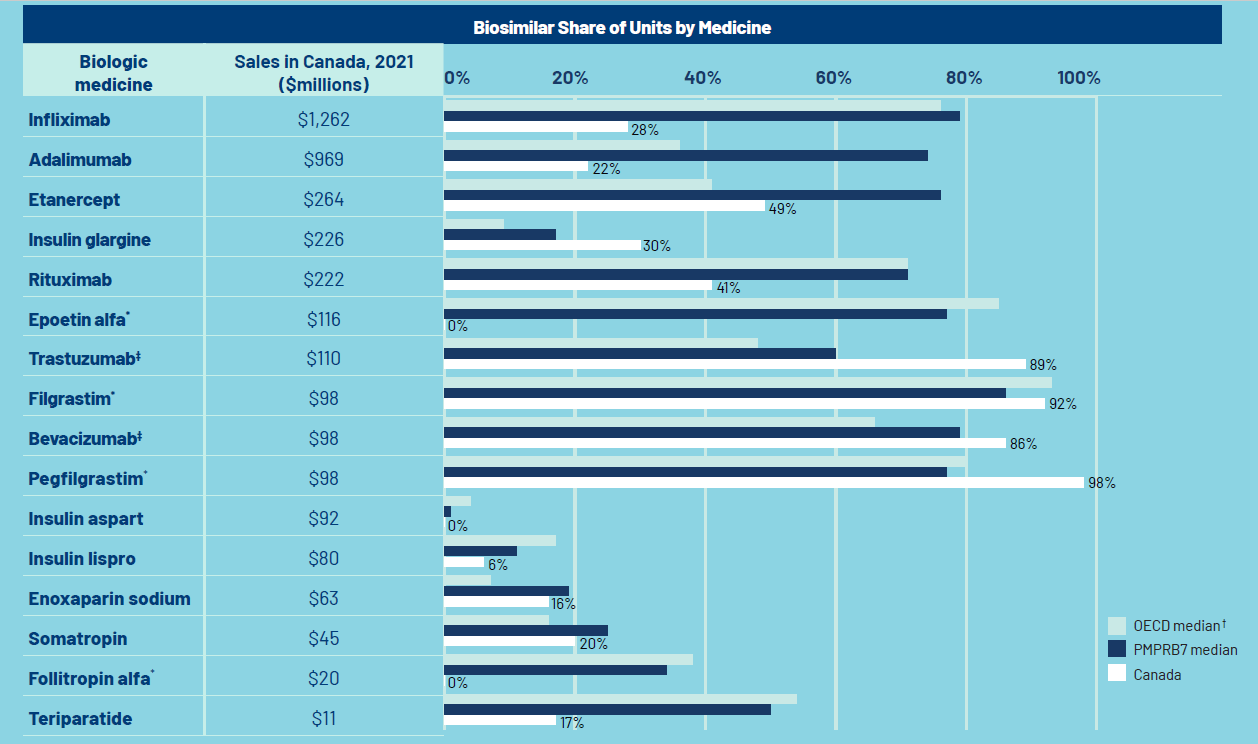
* Generally used to treat acute conditions.
† Canada is excluded from the median OECD value.
‡ Mainly used for treatment of oncology indications and administrated in hospitals in Canada.
Data source: MIDAS® database, prescription retail and hospital markets, 2021, IQVIA (all rights reserved)
[NPDUIS Chartbook: Biologics in Canada, Part 1: Market Trends, 2018 – graph updated for 2021]
Figure description
This bar graph reports the biosimilar uptake, in share of units, for Canada, the PMPRB7, and the Organisation for Economic Co-operation and Development as of the fourth quarter of 2021. The graph compares the uptake for biologic medicines with biosimilar availability in Canada. Total 2021 Canadian sales for each medicine are also given, in millions of dollars.
| Biologic medicine | Sales in Canada, 2021, in millions of dollars | Biosimilar uptake, Q4-2021, share of units | ||
|---|---|---|---|---|
| Median OECD† | Median PMPRB7 | Canada | ||
Infliximab |
$1,262 |
76% |
79% |
28% |
Adalimumab |
$969 |
36% |
74% |
22% |
Etanercept |
$264 |
41% |
76% |
49% |
Insulin glargine |
$226 |
9% |
17% |
30% |
Rituximab |
$222 |
71% |
71% |
41% |
Epoetin alfa* |
$116 |
85% |
77% |
0% |
Trastuzumab‡ |
$110 |
48% |
60% |
89% |
Filgrastim* |
$98 |
93% |
86% |
92% |
Bevacizumab‡ |
$98 |
66% |
79% |
86% |
Pegfilgrastim* |
$98 |
80% |
77% |
98% |
Insulin aspart |
$92 |
4% |
1% |
0% |
Insulin lispro |
$80 |
17% |
11% |
6% |
Enoxaparin sodium |
$63 |
7% |
19% |
16% |
Somatropin |
$45 |
16% |
25% |
20% |
Follitropin alfa* |
$20 |
38% |
34% |
0% |
Teriparatide |
$11 |
54% |
50% |
17% |
While these results demonstrate growing use of biosimilars, Canada continues to lag behind international markets. Canada’s 28% biosimilar share of infliximab in 2021 was lower than all but one OECD country and well below the OECD median of 76% (Figure 17).

Note: Countries with limited data were excluded from the analysis.
Data source: MIDAS® database, prescription retail and hospital markets, Q4-2021, IQVIA (all rights reserved)
[NPDUIS Chartbook: Biologics in Canada. Part 1: Market Trends, 2018 – graph updated for 2021]
Figure description
This bar graph gives the uptake for infliximab biosimilars for each country in the Organisation for Economic Co-operation and Development as a share of all infliximab units sold in the fourth quarter of 2021. Countries with limited sales data were excluded from this analysis. The median for all countries listed was 76%.
| Country | Share of units |
|---|---|
Hungary |
100% |
Poland |
100% |
Norway |
99% |
United Kingdom |
97% |
Finland | 97% |
Italy |
94% |
Austria |
93% |
Sweden |
93% |
Portugal |
90% |
Spain |
79% |
France |
79% |
Ireland |
78% |
Slovenia |
76% |
Mexico |
73% |
Czech Republic |
68% |
Germany |
67% |
Belgium |
45% |
Australia |
44% |
Turkey |
44% |
South Korea |
43% |
Slovakia |
41% |
United States |
32% |
Switzerland |
32% |
Canada |
28% |
Japan |
25% |
Oncology medicines
Figure 18 illustrates the growth in the sales of patented oncology medicines since 2012. In 2021, oncology medicines accounted for 23.9% of total patented medicine sales, close to triple the 2012 share of 8.3%. The shift toward high-cost treatments in the oncology market has contributed to the steeper rate of sales growth observed since 2016.
Oral forms of cancer treatment are a noteworthy emerging segment, representing more than half of all oncology medicine sales and 13.6% of the patented medicine market in 2021, compared to just 3.3% in 2012. The oral therapy Revlimid was the top-selling oncology medicine in 2021, accounting for 3.1% of all patented medicine sales.Footnote 12
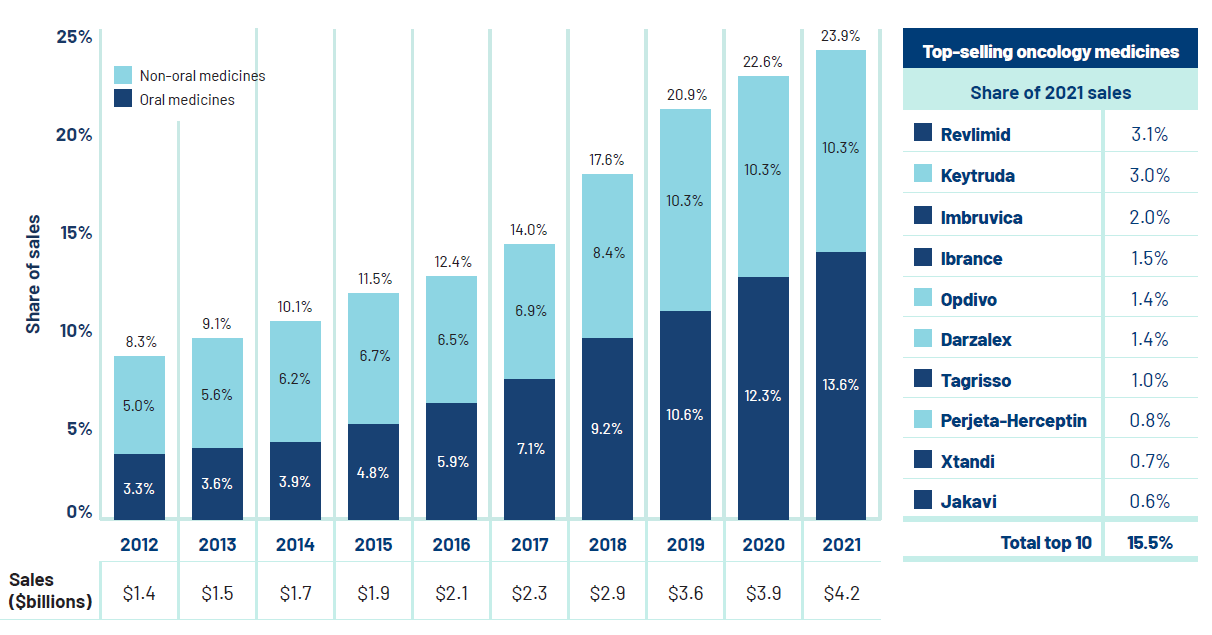
Note: These results reflect the total sales for patented medicines used in the treatment of cancer. While some of these medicines may also be used to treat other conditions, the data used for this analysis does not distinguish between indications, and thus, the reported sales may reflect some non-oncology use.
Values may not add to totals due to rounding.
Data source: PMPRB
Figure description
This stacked bar graph depicts the oncology medicine share of patented medicine sales from 2012 to 2021. Each bar is subdivided into non-oral and oral formulations. The combined total oncology share of patented medicine sales is indicated as well as the net sales in billions of dollars.
| 2012 | 2013 | 2014 | 2015 | 2016 | 2017 | 2018 | 2019 | 2020 | 2021 | |
|---|---|---|---|---|---|---|---|---|---|---|
Non-oral medicines |
5.0% |
5.6% |
6.2% |
6.7% |
6.5% |
6.9% |
8.4% |
10.3% |
10.3% |
10.3% |
Oral medicines |
3.3% |
3.6% |
3.9% |
4.8% |
5.9% |
7.1% |
9.2% |
10.6% |
12.3% |
13.6% |
Total oncology share |
8.3% |
9.1% |
10.1% |
11.5% |
12.4% |
14.0% |
17.6% |
20.9% |
22.6% |
23.9% |
Sales (billions of dollars) |
$1.4 |
$1.5 |
$1.7 |
$1.9 |
$2.1 |
$2.3 |
$2.9 |
$3.6 |
$3.9 |
$4.2 |
The accompanying table gives the share of 2021 sales for the 10 top-selling oncology medicines.
Oncology medicine |
Formulation |
Share of 2021 sales |
Revlimid |
Oral |
3.1% |
Keytruda |
Non-oral |
3.0% |
Imbruvica |
Oral |
2.0% |
Ibrance |
Oral |
1.5% |
Opdivo |
Non-oral |
1.4% |
Darzalex |
Non-oral |
1.4% |
Tagrisso |
Oral |
1.0% |
Perjeta-Herceptin |
Non-oral |
0.8% |
Xtandi |
Oral |
0.7% |
Jakavi |
Oral |
0.6% |
Total top 10 |
15.5% |
|
Price Trends
The PMPRB uses the Patented Medicines Price Index (PMPI) to monitor trends in the prices of patented medicines. The PMPI measures the average year-over-year change in the ex-factory prices of patented medicines sold in Canada using a sales-weighted average of price changes at the level of individual medicines.Footnote 13 This is similar to the approach Statistics Canada uses to construct the Consumer Price Index (CPI). The PMPI is based on an average transaction price and sales information submitted by patentees for a six-month period.
The PMPI only measures the sales growth attributable to changes in the prices of patented medicines. It does not measure changes in the use of patented medicines; this is measured by the quantity index or PMQI (see “Utilization of Patented Medicines”). Nor does it measure the cost impact of changes in prescribing patterns or the introduction of new medicines.
The Patent Act requires the PMPRB to consider changes in the CPI, among other factors, in determining whether the price of a patented medicine is excessive. Figure 19 compares year-over-year changes in the PMPI to corresponding changes in the CPI from 2003 to 2021. The PMPI is reported based on two measures: the national average transaction price, which is a net price; and the national list price, which is a gross price.Footnote 14 Both measures are reported to the PMPRB by patentees. General price inflation, as measured by the CPI, has exceeded the average increase in the prices of patented medicines almost every year since 2003. In 2021, the CPI rose by 3.4%, while the national average transaction price and the national list price PMPIs increased by 0.4% and 0.5%, respectively.
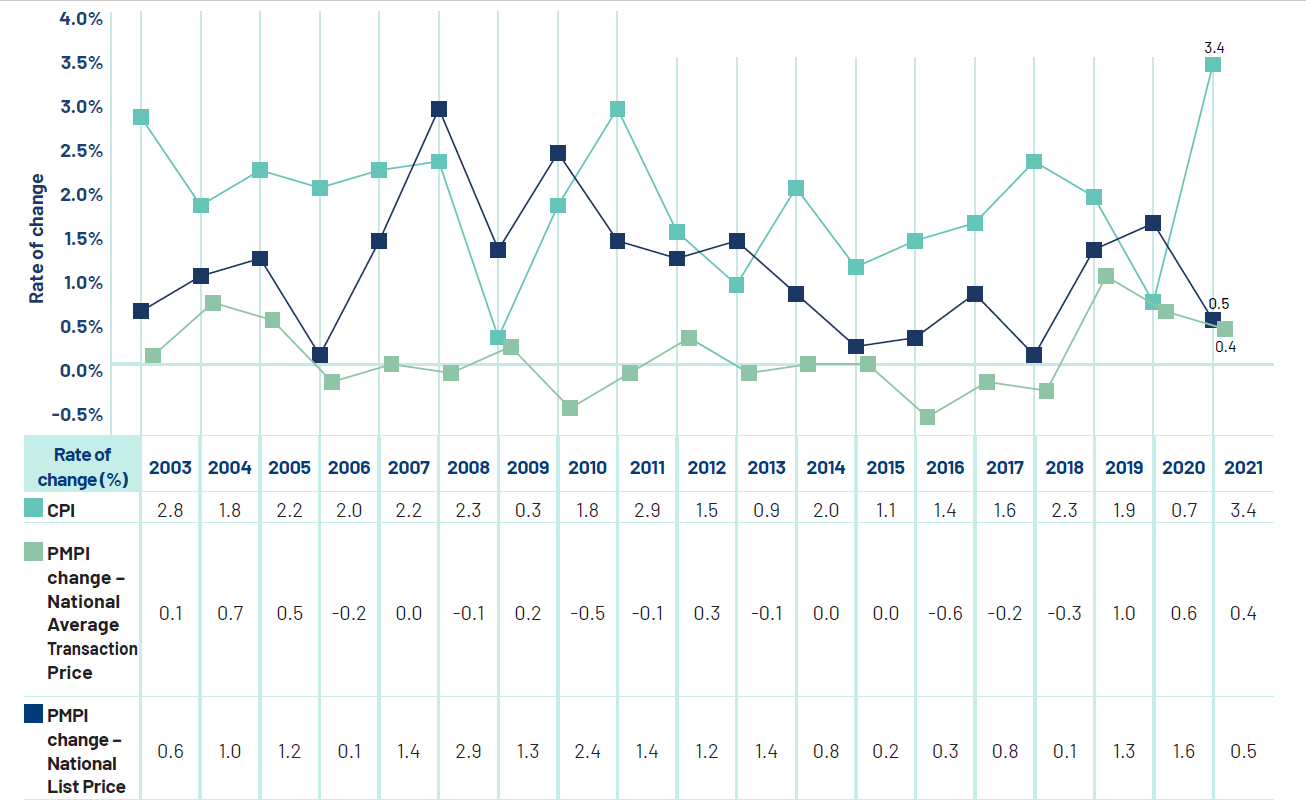
Note: To account for revised submissions from patentees, price and quantity indices are recalculated for the five years preceding the current Annual Report year. If the data has been revised, the values reported here may differ from those presented in earlier Annual Reports.
Data source: PMPRB; Statistics Canada
Figure description
This line graph depicts the year-over-year percent changes in the PMPI and CPI for the years 2003 to 2021. The PMPI is represented by two lines, one based on the national average transaction price and one based on the national list price.
| 2003 | 2004 | 2005 | 2006 | 2007 | 2008 | 2009 | 2010 | 2011 | 2012 | 2013 | 2014 | 2015 | 2016 | 2017 | 2018 | 2019 | 2020 | 2021 | |
|---|---|---|---|---|---|---|---|---|---|---|---|---|---|---|---|---|---|---|---|
CPI change |
2.8% |
1.8% |
2.2% |
2.0% |
2.2% |
2.3% |
0.3% |
1.8% |
2.9% |
1.5% |
0.9% |
2.0% |
1.1% |
1.4% |
1.6% |
2.3% |
1.9% |
0.7% |
3.4% |
PMPI change (National List Price) |
0.6% |
1.0% |
1.2% |
0.1% |
1.4% |
2.9% |
1.3% |
2.4% |
1.4% |
1.2% |
1.4% |
0.8% |
0.2% |
0.3% |
0.8% |
0.1% |
1.3% |
1.6% |
0.5% |
PMPI change (National Average Transaction Price) |
0.1% |
0.7% |
0.5% |
-0.2% |
0.0% |
-0.1% |
0.2% |
-0.5% |
-0.1% |
0.3% |
-0.1% |
0.0% |
0.0% |
-0.6% |
-0.2% |
-0.3% |
1.0% |
0.9% |
0.4% |
The PMPRB’s Guidelines envisage that the price of a patented medicine should not rise by more than the CPI over any three-year period.Footnote 15 The Guidelines also contemplate a cap on year-over-year price increases equal to one and one-half times the current year rate of CPI inflation. This effectively establishes CPI inflation as an upper bound on the amount by which individual prices could rise over any three-year period. Increases in the PMPI normally do not reach this upper bound because many patentees do not raise their prices by the full amount envisaged under the Guidelines.
Price Behaviour After Introduction
Does the price of a typical patented medicine change much in the years after it enters the Canadian market? To answer this question, Figure 20 provides the average ratio of the 2021 price to introductory price (the price at which the medicine was sold in its first year on the Canadian market).
The results in Figure 20 suggest that over the last two decades, prices of patented medicines have remained relatively stable, with 2021 prices being within 3% of the introductory price.Footnote 16 For example, the average prices of medicines introduced in 2002 are still at approximately the same level in 2021.
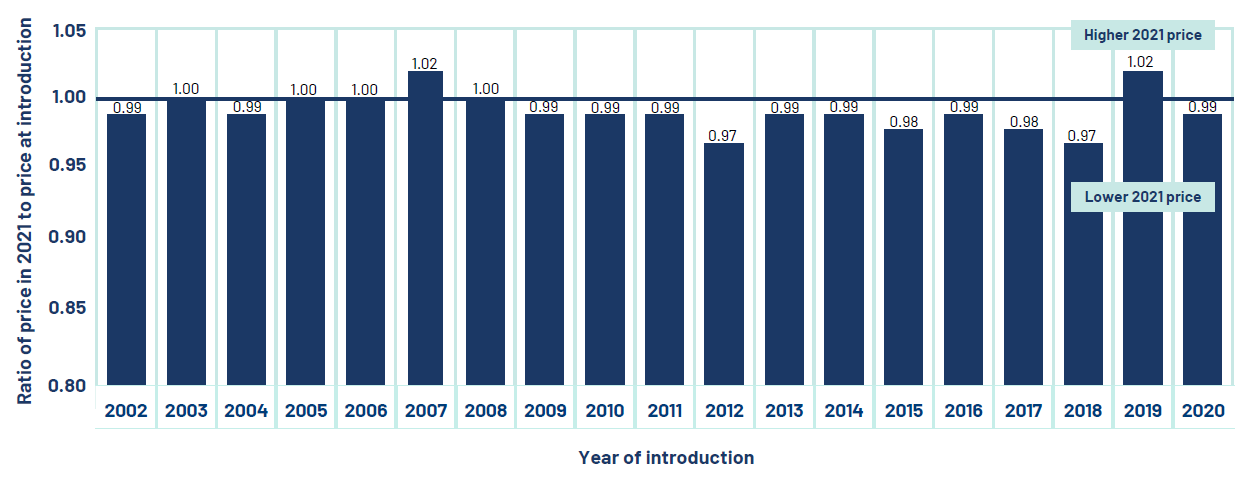
Data source: PMPRB
Figure description
This bar graph depicts the average ratio of the 2021 price of a typical patented medicine to the introductory price (the price at which the medicine was sold in its first year on the Canadian market) for medicines introduced between 2002 and 2021. A line at 1.00 indicates the 2021 price. The number of medicines included in the calculation for each bar is given in a table below the graph.
For the currently patented medicines that were introduced in 2002, the average ratio of the 2021 price to the introductory price is 0.99;
2003: 1.00;
2004: 0.99;
2005: 1.00;
2006: 1.00;
2007: 1.02;
2008: 1.00;
2009: 0.99;
2010: 0.99;
2011: 0.99;
2012: 0.97;
2013: 0.99;
2014: 0.99;
2015: 0.98;
2016: 0.99;
2017: 0.98;
2018: 0.97;
2019: 1.02;
2020: 0.99.
Price Change by Country
In 2021, in accordance with the Act and the Regulations, patentees reported publicly available prices of patented medicines for seven comparator countries (PMPRB7): France, Germany, Italy, Sweden, Switzerland, the United Kingdom (UK), and the United States (US).
The PMPRB uses this information to
- conduct international price comparison tests; and
- compare the Canadian prices of patented medicines to those prevailing in other countries.
Figure 21 gives the average annual rates of price change for Canada and each of the PMPRB7 countries. These results were obtained by applying the PMPI methodology (with weights based on Canadian sales patterns) to the international price data that patentees submitted to the PMPRB. Note that prices from the US Federal Supply Schedule (FSS)Footnote 17 are incorporated into the US results.
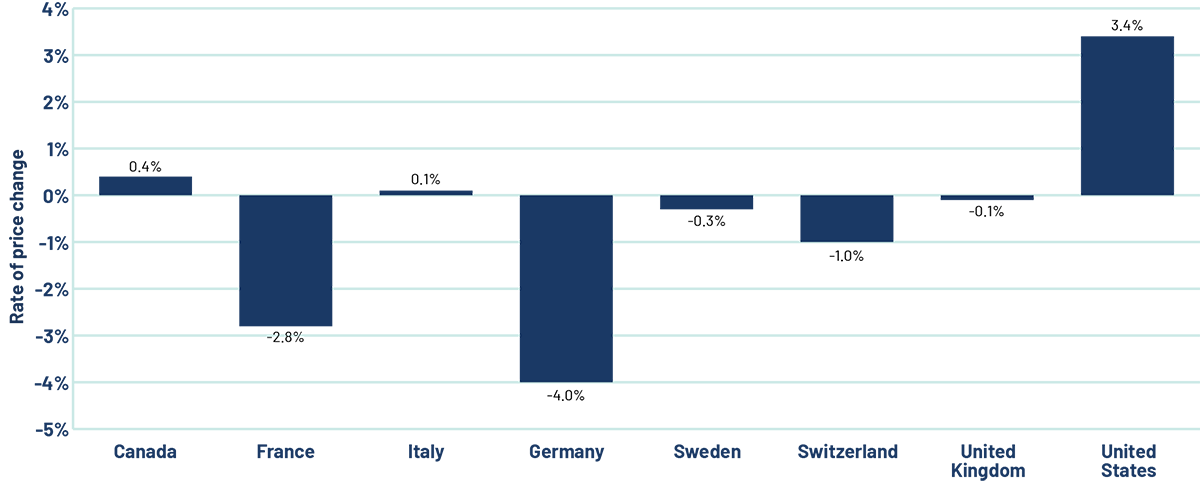
Data source: PMPRB
Figure description
This bar graph depicts the average annual rates of price change for Canada and each of the PMPRB7 comparator countries for 2021. In Canada, the average annual rate of price change was 0.4%. France, -2.8%; Italy, 0.1%; Germany, -4.0%; Sweden, -0.3%; Switzerland, -1.0%; United Kingdom, -0.1%; United States, 3.4%.
In 2021, Canadian prices saw a slight increase of 0.4%, while prices in the US rose by an average of 3.4% and those in Italy, Sweden, and the UK remained relatively steady. Prices in the remaining countries declined. These results are consistent with a long-term tendency for patented medicine prices to slowly fall over time in most comparator countries, with the exception of the US.
The foreign market results are based on publicly available gross prices, namely ex-factory price information (generally for the retail customer class) submitted by patentees to the PMPRB. The Canadian rate of change, however, is based on net prices, namely actual average transaction prices net of rebates and discounts provided by manufacturers to their direct customers.
Comparison of Canadian Prices to Foreign Prices
Tables 9 and 10 provide detailed statistics comparing the foreign prices of patented medicines to their Canadian prices. Each table provides two sets of average price ratios. These are differentiated according to the method by which foreign prices were converted to their Canadian dollar equivalents. The tables also give the numbers of strengths and dosage forms of medicines (DINs) and the volume of sales encompassed by each reported price ratio.Footnote 18
The average price ratios given in Tables 9 and 10 are sales-weighted arithmetic means of price ratios obtained for individual DINs, with weights based on Canadian sales patterns. Average price ratios constructed in this way provide answers to questions such as:
How much more/less would Canadians have paid for the patented medicines they purchased in 2021 had they paid Country X prices rather than Canadian prices?
For example, Table 9 states that the 2021 average France-to-Canada price ratio for medicines available in both countries was 0.74. This means Canadians would have paid 26% less for the patented medicines they purchased in 2021 if they had paid French prices.
For many years, the PMPRB has reported average foreign-to-Canadian price ratios with foreign prices converted to their Canadian dollar equivalents by means of market exchange rates (more exactly, the 36-month moving averages of market rates the PMPRB normally uses in applying its Guidelines). Tables 9 and 10 also report foreign-to-Canadian price ratios with currency conversion at purchasing power parity (PPP). The PPP between any two countries measures their relative costs of living expressed in units of their own currencies. In practice, cost of living is determined by pricing out a standard basket of goods and services at the prices prevailing in each country.
Because PPPs are designed to represent relative costs of living, they offer a simple way to account for differences in overall national price levels when comparing individual prices, incomes, and other monetary values across countries. When applied to the calculation of average foreign-to-Canadian price ratios, they produce statistics answering questions such as:
How much more/less consumption of other goods and services would Canadians have sacrificed for the patented medicines they purchased in 2021 had they lived in Country X?
Questions such as this cannot be answered by simply comparing the prices of medicines. Rather, one must first calculate what each price represents in terms of goods and services foregone. PPPs are designed for such purposes.
Bilateral Price Comparisons
Table 9 provides bilateral comparisons of list prices in each of the PMPRB7 countries to average transaction prices in Canada. Focusing on the results with currency conversion at market exchange rates, it appears that, as in previous years, Canadian prices were typically within the range of prices observed in comparator countries. Prices reported for France, Sweden, and Italy were lower than Canadian prices, while prices in Germany and the UK were on par with Canada. Two countries, Switzerland and the US, continued to report prices that were higher than Canada. Prices reported for the US remain much higher than prices in Canada or any other comparator country. Year-to-year changes in these ratios may be influenced by variations in international exchange rates.
It is important to note that it is not always possible to find a matching foreign price for every strength and dosage form of a patented medicine sold in Canada. Table 9 indicates how often an international price comparison was available for each of the comparator countries. For example, of the 1,141 DINs that reported a patent to the PMPRB in 2021, 47% had a publicly available ex-factory price for France while 79% had a price for the US. Given the integrated nature of the Canadian and US supply chain, it is not uncommon for the US to be the only comparator country with an available price for a strength and dosage form of a medicine sold in Canada. In this case, it is considered to constitute the international median price, as per the PMPRB’s methodology.
When international differences in the cost of living are considered (using PPP), the average price ratios indicate that Canadians incurred a larger consumption cost for the patented medicines they purchased in 2021 than residents of France, Sweden, and Switzerland.
Table 9. Average Foreign-to-Canadian Price Ratios, Bilateral Comparisons, Canada and the PMPRB7, 2021
| Canada | France | Germany | Italy | Sweden | Switzerland | United Kingdom | United States | |
|---|---|---|---|---|---|---|---|---|
At market exchange rates |
||||||||
Average price ratio 2021 |
1.00 |
0.74 |
1.00 |
0.98 |
0.88 |
1.04 |
1.00 |
3.51 |
Average price ratio 2020 |
1.00 |
0.77 |
1.09 |
1.00 |
0.87 |
1.08 |
0.98 |
3.82 |
At purchasing power parities |
||||||||
Average price ratio 2021 |
1.00 |
0.90 |
1.19 |
1.33 |
0.90 |
0.87 |
1.14 |
3.61 |
Average price ratio 2020 |
1.00 |
0.80 |
1.14 |
1.17 |
0.78 |
0.79 |
0.96 |
3.53 |
Number of patented medicines compared 2021 (DINs) |
1,141 |
531 |
858 |
691 |
674 |
716 |
821 |
896 |
Sales ($millions) |
$17,445.5 |
$11,543.9 |
$15,285.1 |
$14,356.4 |
$12,293.7 |
$14,748.0 |
$15,250.0 |
$16,363.14 |
Data source: PMPRB
Figure 22 compares the 2021 foreign-to-Canadian price ratios (at market exchange rates) to those a decade earlier, in 2012. The ratios for France and Sweden remained relatively unchanged between 2012 and 2021 with prices consistently below Canada, while Switzerland hovered just above Canadian prices in both years. Whereas prices in Italy and the UK were similar to those in France in 2012, their ratios are now at parity with Canada. The German ratio is also on par with Canada, having dropped from 1.11 in 2012. The most significant change is observed for prices in the US, where the gap with Canadian prices has widened from 2.02 in 2012 to 3.51 in 2021.
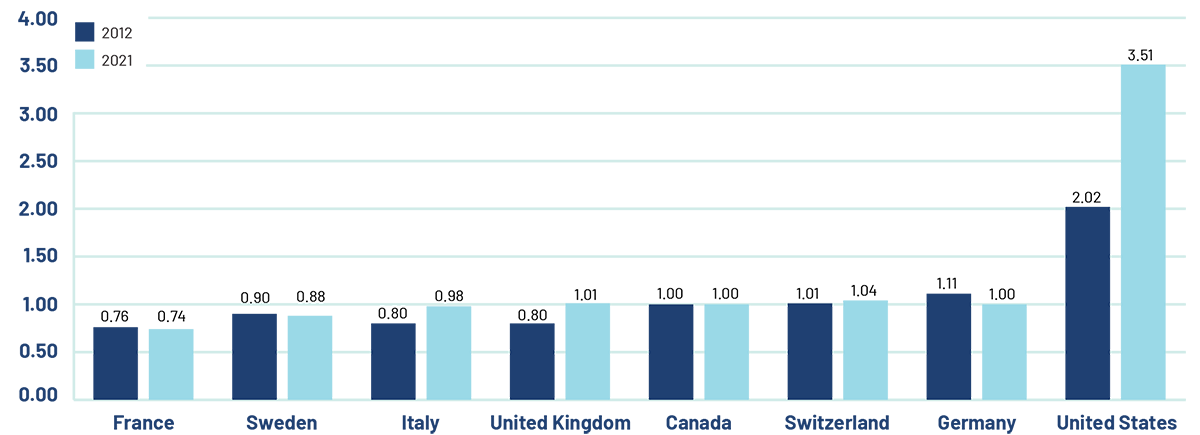
Data source: PMPRB
Figure description
This bar graph depicts the average foreign-to-Canadian price ratios in 2012 and 2021 for the PMPRB7 comparator countries.
| Country | Average foreign-to-Canadian price ratio for 2012 | Average foreign-to-Canadian price ratio for 2021 |
|---|---|---|
France |
0.76 |
0.74 |
Sweden |
0.90 |
0.88 |
Italy |
0.80 |
0.98 |
United Kingdom |
0.80 |
1.01 |
Canada |
1.00 |
1.00 |
Switzerland |
1.01 |
1.04 |
Germany |
1.11 |
1.00 |
United States |
2.02 |
3.51 |
If a patented medicine is being sold in one or more of the PMPRB7 countries, the patentee must report the publicly available ex-factory prices to the PMPRB for each class of customer.Footnote 19 Using this data, Figure 22 provides sales-weighted bilateral ratios comparing Canadian average transaction prices against foreign list prices. In order to assess how Canada compares to a basket of countries beyond the PMPRB7, Figure 23 uses Canadian and international prices reported in the IQVIA MIDAS® database at the ex-factory manufacturer level, reflecting all sales to the pharmacy and hospital sectors.Footnote 20 Note that the results presented in Figures 22 and 23 will differ somewhat due to the use of different data sources.
The international price comparisons reported in Figure 23 provide a bilateral price comparison for all countries in the Organisation for Economic Co-operation and Development (OECD) with available MIDAS® data. The average foreign-to-Canadian price ratios are calculated using the same approach employed to produce the ratios presented in Figure 22. These are Canadian sales-weighted arithmetic averages of the corresponding foreign-to-Canadian price ratios for individual medicines. As shown in Figure 23, median OECD prices are, on average, approximately 18% lower than price levels in Canada, which are the third highest among the 31 countries. Notably, the top two highest-priced countries are the US and Switzerland.
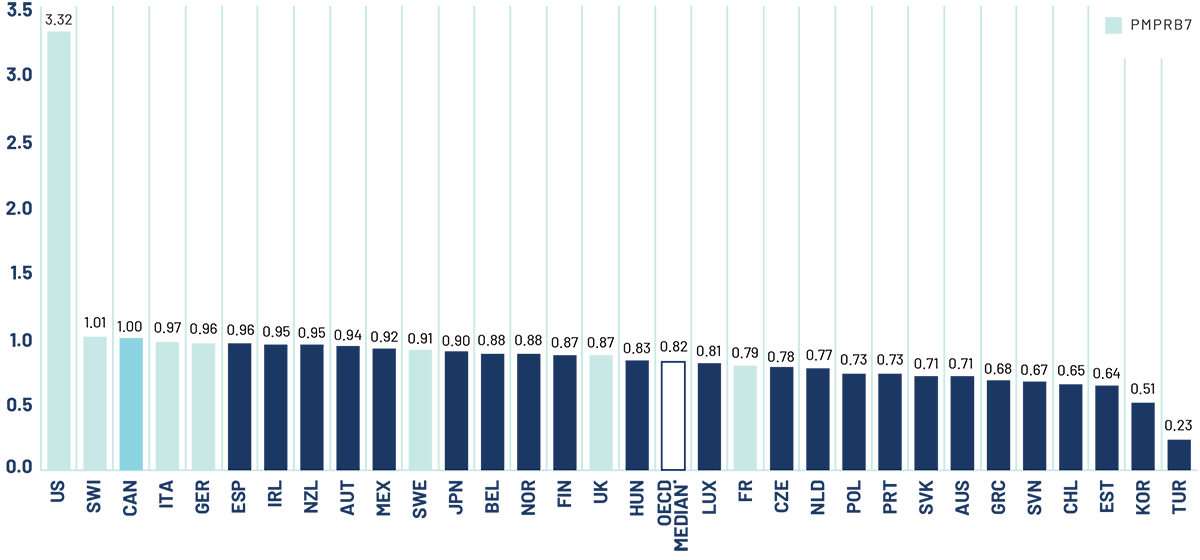
* Calculated at the medicine level for medicines with prices available in at least three foreign markets.
Data source: MIDAS® database, 2021, IQVIA (all rights reserved)
Figure description
This bar graph depicts the average foreign-to-Canadian price ratios for patented medicines in 2021 for the Organisation for Economic Co-operation and Development (OECD) countries using Canadian and international prices reported in the IQVIA MIDAS® database. The median for the OECD countries, which is calculated at the medicine level for medicines with prices available in at least three foreign markets, was 0.82.
| Country | Average foreign-to-Canadian price ratio |
|---|---|
United States |
3.32 |
Switzerland | 1.01 |
Canada |
1.00 |
Italy |
0.97 |
Germany |
0.96 |
Spain |
0.96 |
Ireland |
0.95 |
New Zealand |
0.95 |
Austria |
0.94 |
Mexico |
0.92 |
Sweden |
0.91 |
Japan |
0.90 |
Belgium |
0.88 |
Norway |
0.88 |
Finland |
0.87 |
United Kingdom |
0.87 |
Hungary |
0.83 |
Luxembourg |
0.81 |
France |
0.79 |
Czech Republic |
0.78 |
Netherland |
0.77 |
Poland |
0.73 |
Portugal |
0.73 |
Slovakia |
0.71 |
Australia |
0.71 |
Greece |
0.68 |
Slovenia |
0.67 |
Chile |
0.65 |
Estonia |
0.64 |
South Korea |
0.51 |
Turkey |
0.23 |
Brief Insights: Trends in the Price of Generic Medicines
The average price of generic medicines in Canada has dropped substantially, by 59% relative to price levels in 2007 (Figure 24). This was the second highest rate of price reduction compared to the PMPRB7 markets, following the UK, as generic price decreases continued to reduce the historic gap between Canadian and foreign generic price levels.
The most recent Canadian generic pricing policy, implemented in 2018, had brought Canadian generic prices in line with average prices in the PMPRB7. However, since 2018, the gap between Canadian and PMPRB7 countries has widened, largely due to decreases in foreign prices and fluctuating exchange rates. While Canadian prices were half the level of those in Switzerland in 2021, they were above those in the remaining PMPRB7 countries (Figure 25). Prices were marginally higher than Italy, about 20% above France, Germany, the UK, and the UK, and twice those of Sweden. Median prices for these medicines across all OECD countries were 25% lower than prices in Canada in the last quarter of 2021.
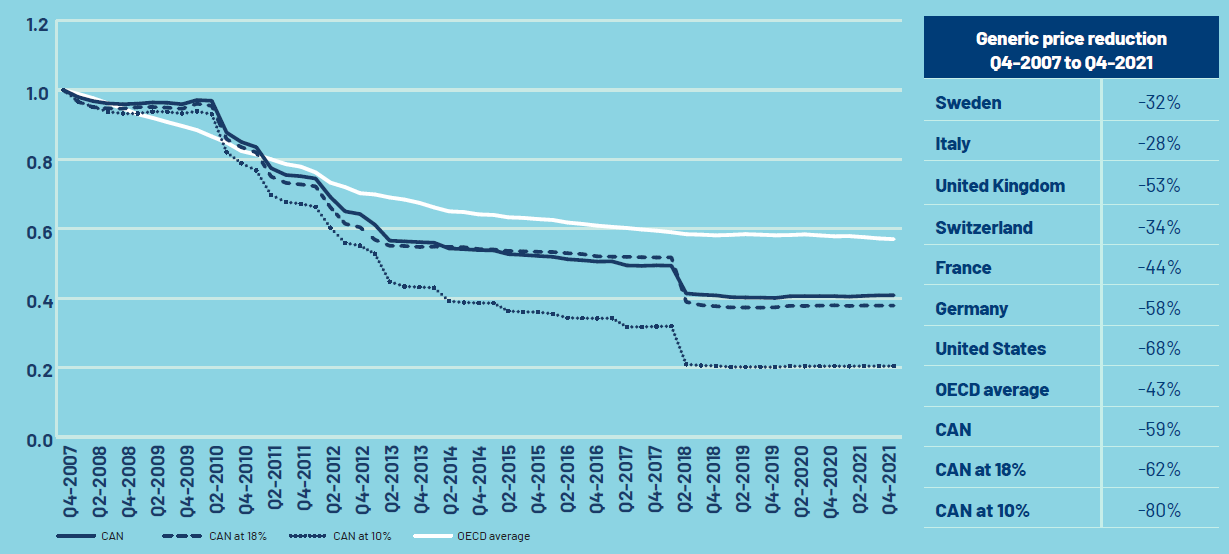
Note: The term “generic” used in this analysis includes both patented and non-patented generic medicines. Results are based on manufacturer ex-factory list prices in the national retail markets. The analysis was restricted to oral solid generic medicines that had been on the market for at least one year. CAN at 18% and 10% refer to the 67 generic medicines reduced to 18% and 10% of their brand reference prices through the generic pricing policy introduced in April 2018.
Data source: MIDAS® database, October–December 2007 to October–December 2021, IQVIA (all rights reserved)
[NPDUIS Report: Generics360, 2018 – graph updated for 2019 to 2021]
Figure description
This line graph and accompanying table focus on the price reductions for generic medicines from the fourth quarter of 2007 to the fourth quarter of 2021. The graph gives the price indices for all generic medicines in Canada, as well as those at 18% and 10% of their brand-reference prices and compares these with the average for the Organisation for Economic Co-operation and Development (OECD) countries over the same period. Note that the term “generic” used in this analysis includes both patented and non-patented generic medicines.
| Quarter year | Canada | Canada medicines at 18% | Canada medicines at 10% | OECD average |
|---|---|---|---|---|
2007: fourth quarter |
1.00 |
1.00 |
1.00 |
1.00 |
2008: first quarter |
0.98 |
0.97 |
0.97 |
0.99 |
2008: second quarter |
0.97 |
0.95 |
0.95 |
0.98 |
2008: third quarter |
0.96 |
0.95 |
0.94 |
0.96 |
2008: fourth quarter |
0.96 |
0.95 |
0.93 |
0.95 |
2009: first quarter |
0.96 |
0.95 |
0.93 |
0.93 |
2009: second quarter |
0.96 |
0.95 |
0.94 |
0.92 |
2009: third quarter |
0.96 |
0.95 |
0.94 |
0.91 |
2009: fourth quarter |
0.96 |
0.95 |
0.93 |
0.90 |
2010: first quarter |
0.97 |
0.96 |
0.94 |
0.88 |
2010: second quarter |
0.97 |
0.95 |
0.93 |
0.87 |
2010: third quarter |
0.88 |
0.86 |
0.82 |
0.85 |
2010: fourth quarter |
0.85 |
0.84 |
0.79 |
0.82 |
2011: first quarter |
0.84 |
0.82 |
0.77 |
0.81 |
2011: second quarter |
0.77 |
0.75 |
0.70 |
0.80 |
2011: third quarter |
0.76 |
0.73 |
0.68 |
0.79 |
2011: fourth quarter |
0.75 |
0.73 |
0.67 |
0.78 |
2012: first quarter |
0.75 |
0.72 |
0.66 |
0.76 |
2012: second quarter |
0.69 |
0.66 |
0.60 |
0.73 |
2012: third quarter |
0.65 |
0.61 |
0.56 |
0.72 |
2012: fourth quarter |
0.64 |
0.60 |
0.55 |
0.70 |
2013: first quarter |
0.61 |
0.57 |
0.53 |
0.70 |
2013: second quarter |
0.57 |
0.55 |
0.45 |
0.69 |
2013: third quarter |
0.56 |
0.55 |
0.43 |
0.68 |
2013: fourth quarter |
0.56 |
0.55 |
0.43 |
0.67 |
2014: first quarter |
0.56 |
0.55 |
0.43 |
0.66 |
2014: second quarter |
0.54 |
0.55 |
0.39 |
0.65 |
2014: third quarter |
0.54 |
0.55 |
0.39 |
0.65 |
2014: fourth quarter |
0.54 |
0.54 |
0.39 |
0.64 |
2015: first quarter |
0.54 |
0.54 |
0.39 |
0.64 |
2015: second quarter |
0.53 |
0.54 |
0.36 |
0.63 |
2015: third quarter |
0.52 |
0.54 |
0.36 |
0.63 |
2015: fourth quarter |
0.52 |
0.53 |
0.36 |
0.63 |
2016: first quarter |
0.52 |
0.53 |
0.35 |
0.63 |
2016: second quarter |
0.51 |
0.53 |
0.34 |
0.62 |
2016: third quarter |
0.51 |
0.53 |
0.34 |
0.61 |
2016: fourth quarter |
0.51 |
0.52 |
0.34 |
0.61 |
2017: first quarter |
0.51 |
0.52 |
0.34 |
0.61 |
2017: second quarter |
0.49 |
0.52 |
0.32 |
0.60 |
2017: third quarter |
0.49 |
0.52 |
0.32 |
0.60 |
2017: fourth quarter |
0.49 |
0.52 |
0.32 |
0.59 |
2018: first quarter |
0.49 |
0.52 |
0.32 |
0.59 |
2018: second quarter |
0.41 |
0.39 |
0.21 |
0.58 |
2018: third quarter |
0.41 |
0.38 |
0.21 |
0.58 |
2018: fourth quarter |
0.41 |
0.38 |
0.21 |
0.58 |
2019: first quarter |
0.40 |
0.37 |
0.20 |
0.58 |
2019: second quarter |
0.40 |
0.37 |
0.20 |
0.58 |
2019: third quarter |
0.40 |
0.37 |
0.20 |
0.58 |
2019: fourth quarter |
0.40 |
0.37 |
0.20 |
0.58 |
2020: first quarter |
0.41 |
0.38 |
0.20 |
0.58 |
2020: second quarter |
0.41 |
0.38 |
0.20 |
0.58 |
2020: third quarter |
0.41 |
0.38 |
0.20 |
0.58 |
2020: fourth quarter |
0.41 |
0.38 |
0.20 |
0.58 |
2021: first quarter |
0.40 |
0.38 |
0.20 |
0.58 |
2021: second quarter |
0.41 |
0.38 |
0.20 |
0.58 |
2021: third quarter |
0.41 |
0.38 |
0.20 |
0.57 |
2021: fourth quarter |
0.41 |
0.38 |
0.20 |
0.57 |
The accompanying table gives the associated generic price reductions from the fourth quarter of 2007 to the fourth quarter of 2021 for the Canadian markets and the OECD average, as well as for each of the PMPRB7 countries.
| Country | Generic price reduction |
|---|---|
Sweden |
-32% |
Italy |
-28% |
United Kingdom |
-53% |
Switzerland |
-34% |
France |
-44% |
Germany |
-58% |
United States |
-68% |
OECD average |
-43% |
Canada: all generics |
-59% |
Canada: generics at 18% |
-62% |
Canada: generics at 10% |
-80% |
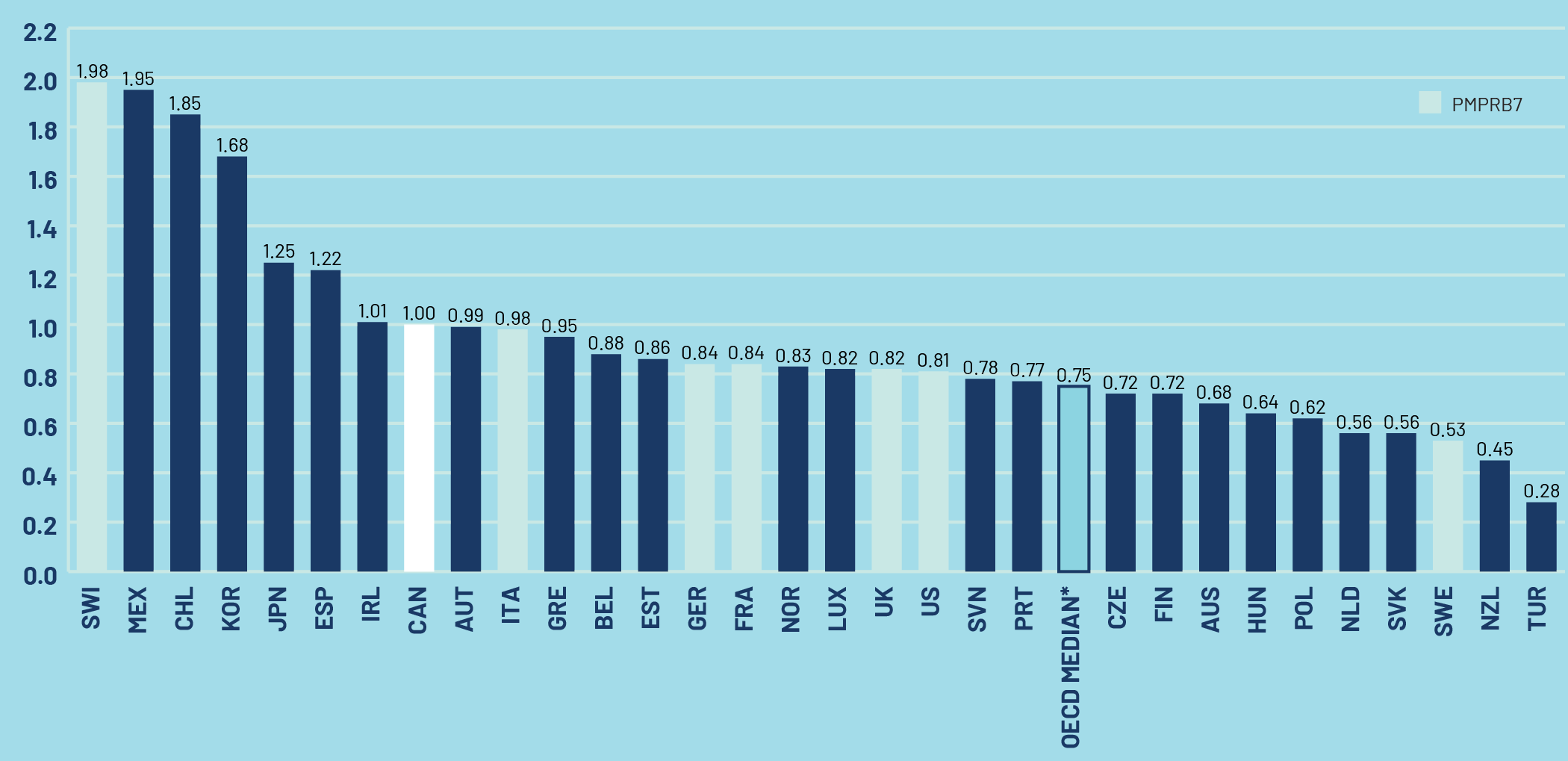
* The OECD median does not necessarily represent the median result for the individual countries reported in this graph, as it is calculated at the medicine level for generics with prices available in at least three foreign markets.
Data source: MIDAS® database, October–December 2021, IQVIA (all rights reserved)
[NPDUIS Report: Generics360, 2018 – graph updated to 2021]
Figure description
This bar graph compares the bilateral foreign-to-Canadian generic medicine price ratios for OECD countries for the fourth quarter of 2021. The median for the OECD countries, which is calculated at the medicine level for medicines with prices available in at least three foreign markets, was 0.75.
Note that the term “generic” used in this analysis includes both patented and non-patented generic medicines. Results are based on manufacturer ex-factory list prices in the national retail markets. The analysis was restricted to oral solid generic medicines that had been on the market for at least one year.
| Country | Foreign-to-Canadian price ratio |
|---|---|
Switzerland |
1.98 |
Mexico |
1.95 |
Chile |
1.85 |
South Korea |
1.68 |
Japan |
1.25 |
Spain |
1.22 |
Ireland |
1.01 |
Canada |
1.00 |
Austria |
0.99 |
Italy |
0.98 |
Greece |
0.95 |
Belgium |
0.88 |
Estonia |
0.86 |
Germany |
0.84 |
France |
0.84 |
Norway |
0.83 |
Luxembourg |
0.82 |
United Kingdom |
0.82 |
United States |
0.81 |
Slovenia |
0.78 |
Portugal |
0.77 |
Czech Republic |
0.72 |
Finland |
0.72 |
Australia |
0.68 |
Hungary |
0.64 |
Poland |
0.62 |
Netherlands |
0.56 |
Slovakia |
0.56 |
Sweden |
0.53 |
New Zealand |
0.45 |
Turkey |
0.28 |
Multilateral Price Comparisons
Table 10 provides average foreign-to-Canadian price ratios using several multilateral measures of foreign prices. The median international price (MIP) is the median of list prices observed among the PMPRB7. Other multilateral price ratios compare the minimum, maximum, and simple mean of foreign prices to the Canadian average transaction price.
Focusing again on the results based on market exchange rates, the average MIP-to-Canadian price ratio was 1.12 in 2021, lower than the 1.16 ratio in 2020 (Figure 26). Note that mean foreign prices produce higher foreign-to-Canadian price ratios than MIPs do. This is due to the influence of US prices, which are typically much higher than prices elsewhere and nearly always figure importantly in determining the mean foreign price. While the US has less of an impact on median international prices, it does exercise a significant influence over the average ratio of median international prices relative to Canadian prices, as the US is sometimes the only country with an available ex-factory price for a patented medicine sold in Canada.
Table 10. Average Foreign-to-Canadian Price Ratios, Multilateral Comparisons, 2021
| Median | Minimum | Maximum | Mean | |
|---|---|---|---|---|
Average price ratio at market exchange rates |
1.12 |
0.86 |
3.45 |
1.46 |
Average price ratio at purchasing power parities |
1.24 |
0.93 |
3.59 |
1.58 |
Number of patented medicines |
1,064 |
1,064 |
1,064 |
1,064 |
Sales ($millions) |
$17,105.14 |
$17,105.14 |
$17,105.14 |
$17,105.14 |
Data source: PMPRB
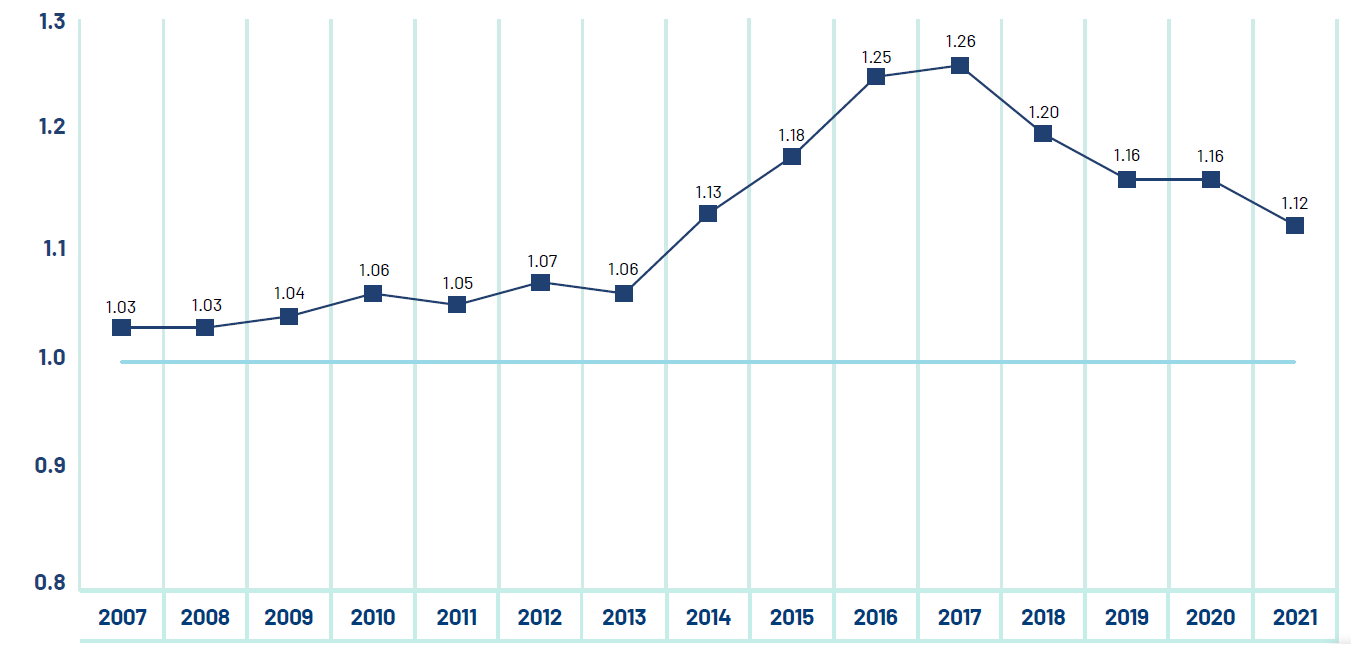
Data source: PMPRB
Figure description
This line graph depicts the trend in the average MIP-to-Canadian price ratios from 2007 to 2021 using the average transaction price (ATP) in Canada.
In 2007, the average ratio of the median international price (ATP) to Canadian price, at market exchange rates, was 1.03;
2008: 1.03;
2009: 1.04;
2010: 1.06;
2011: 1.05;
2012: 1.07;
2013: 1.06;
2014: 1.13;
2015: 1.18;
2016: 1.25;
2017: 1.26;
2018: 1.20;
2019: 1.16;
2020: 1.16;
2021: 1.12.
Figure 27 provides alternative results for the average MIP-to-Canadian price ratio at market exchange rates in 2021. To address the point that Canadian prices are national average transaction prices whereas foreign prices are list prices, a list-to-list price ratio is calculated. Using this method, the average ratio decreases from 1.12 to 1.05. It is important to keep in mind that confidential rebates provided to payers are not captured in this data.
To account for the large impact of US prices in determining the median foreign price, a ratio excluding the US and a ratio including at least five countries in the calculation of the median are also provided as additional context in Figure 27. With these restrictions, the average MIP-to-Canadian price ratios drop to 0.86 and 0.90, respectively, suggesting that median foreign list prices are, on average, 14% to 10% lower than Canadian list prices.
In many of the comparator countries, discounts off list prices are available to all payers, both public and private. By contrast, a large portion of the Canadian market pays list prices, or close to list prices. Furthermore, it should be noted that these are average ratios—some patentees charge Canadian consumers less than median international prices, while others charge more. For MIP-to-Canadian price ratios at the patentee level, please refer to Table 22 in Appendix 4 of this report.
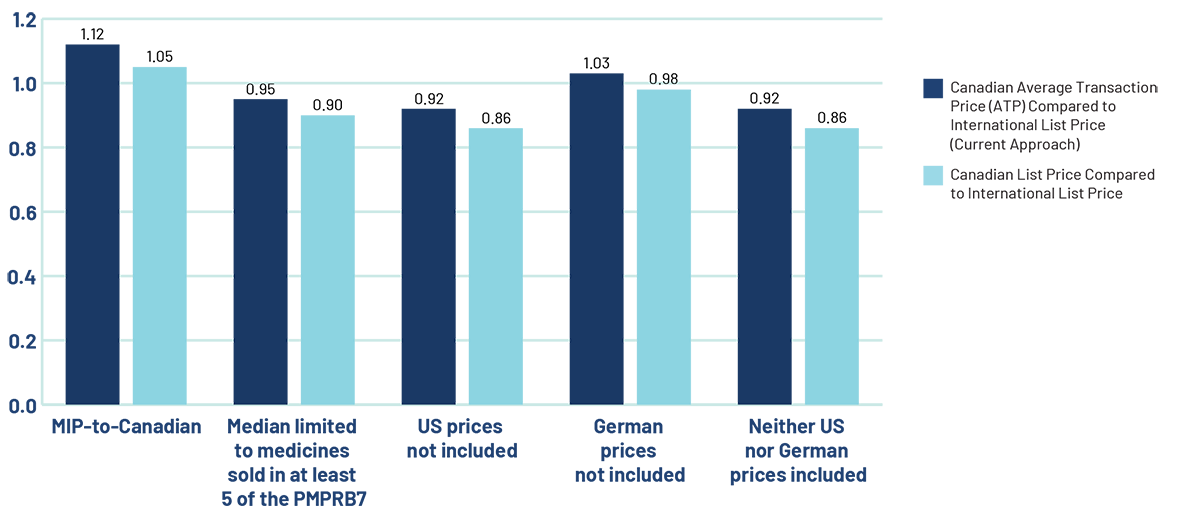
Data source: PMPRB
Figure description
This bar graph depicts the average MIP-to-Canadian price ratios at market exchange rates for 2021 using the average transaction price in Canada (ATP) compared to the PMPRB7 international list price and using the Canadian list price compared to the international list price.
| Ratio of the Average Transaction Price (ATP) to International List Price (Current approach) | Ratio of the Canadian List Price to International List Price | |
|---|---|---|
MIP to Canadian |
1.12 |
1.05 |
Median limited to medicines sold in at least 5 of the PMPRB7 countries |
0.95 |
0.90 |
US prices not included |
0.92 |
0.86 |
German prices not included |
1.03 |
0.98 |
Neither US nor German prices included |
0.92 |
0.86 |
Figure 28 offers more detail on the medicine-level MIP-to-Canadian ratios underlying the averages reported in Table 10. This figure distributes the 2021 sales of each patented medicine according to the value of its MIP-to-Canadian price ratio (more exactly, according to the range into which the ratio fell).Footnote 21 These results show a substantial dispersion in medicine-level price ratios: while patented medicines with MIP-to-Canadian price ratios between 0.90 and 1.10 accounted for 35.3% of sales, those with ratios less than 0.90 accounted for 38.5% of sales and medicines with ratios exceeding 1.10 accounted for the remaining 26.1%. Approximately one quarter of the medicines assessed had an MIP-to-Canadian ratio greater than 1.50, including many for which the US price was the only available international comparator.
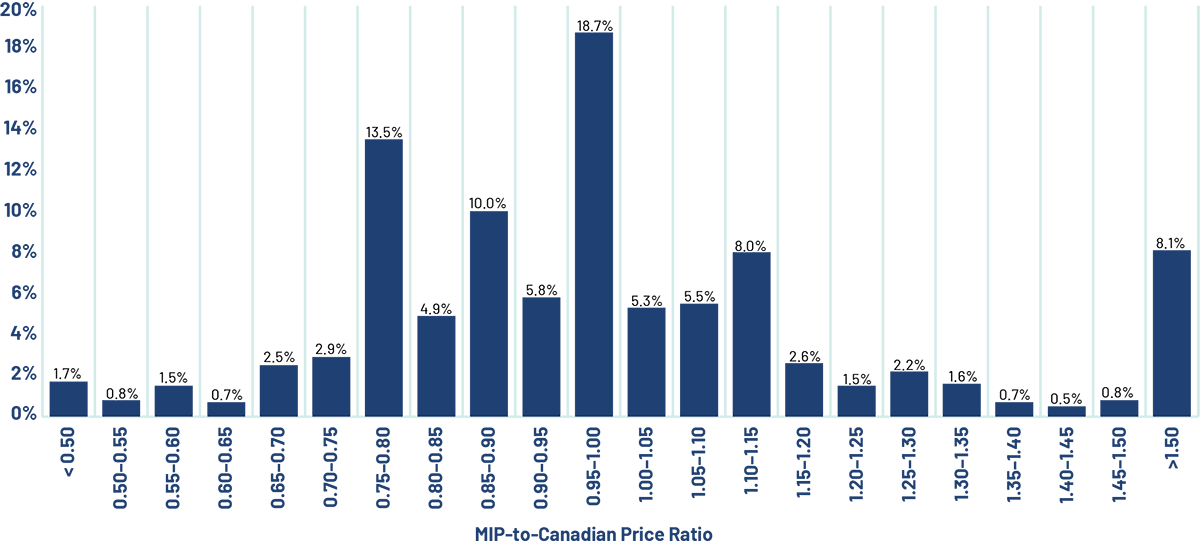
Data source: PMPRB
Figure description
This bar graph depicts the distribution of 2021 sales of patented medicines by their range of MIP-to-Canadian price ratio. Ratios between less than 0.50 and greater than 1.50 are given in increments of 0.05.
Patented medicines with price ratios less than 0.50 accounted for 1.7% of sales;
0.50 to 0.55: 0.8%;
0.55 to 0.60: 1.5%;
0.60 to 0.65: 0.7%;
0.65 to 0.70: 2.5%;
0.70 to 0.75: 2.9%;
0.75 to 0.80: 13.5%;
0.80 to 0.85: 4.9%;
0.85 to 0.90: 10.0%;
0.90 to 0.95: 5.8%;
0.95 to 1.00: 18.7%;
1.00 to 1.05: 5.3%;
1.05 to 1.10: 5.5%;
1.10 to 1.15: 8.0%;
1.15 to 1.20: 2.6%;
1.20 to 1.25: 1.5%;
1.25 to 1.30: 2.2%;
1.30 to 1.35: 1.6%;
1.35 to 1.40: 0.7%;
1.40 to 1.45: 0.5%;
1.45 to 1.50: 0.8%;
> 1.50: 8.1%.
In 2021, approximately 44% of Canadian patented medicines were priced above the median international level.Footnote 22 Table 11 examines the impact of this difference by therapeutic class. Medicines that share the fourth level ATC classification (“ATC4”)Footnote 23 are grouped to identify distinct chemical/pharmacological/therapeutic subgroups, allowing for a calculation of the average MIP-to-Canadian price ratios among medicines that may be used to treat the same conditions. Table 11 identifies the top 10 ATC4s in 2021 in which the difference between Canadian and median prices had the largest effect on Canadian patented medicine spending.Footnote 24 For example, had Canadian prices been in line with the international median for these classes of medicines in 2021, sales in Canada would have been reduced by approximately $1,021 million (an average reduction of 14% for these ATC4s). Of the 244 DINs classified into these 10 ATC4s, 53% were priced above the median international price.
Table 11. Top 10 ATC4s* by Total Sales Greater than Median International Prices, 2021
| Description | ATC4* | No. of companies | No. of chemicals in ATC4 (No. currently under patent) | Total patented DINs | Patented DINs greater than median price | 2021 net revenues for patented DINs ($millions) | Patented DINs ATC4 share of 2021 revenues | MIP-to-Canadian ratio (min. 5) of patented DINs† | Impact of difference on patented medicines in 2021 ($millions) |
|---|---|---|---|---|---|---|---|---|---|
Selective immunosuppressants |
L04AA |
13 |
18 (18) |
37 |
30 |
$2,023.25 |
11.60% |
0.88 |
$271.28 |
Protein kinase inhibitors |
L01XE |
17 |
40 (40) |
87 |
37 |
$1,386.70 |
7.95% |
0.95 |
$156.77 |
Other blood glucose lowering drugs, excl. insulins |
A10BX |
4 |
5 (5) |
11 |
9 |
$639.25 |
3.66% |
0.79 |
$133.18 |
DPP-4 inhibitors |
A10BH |
4 |
4 (4) |
9 |
7 |
$308.38 |
1.77% |
0.69 |
$96.38 |
Combinations of oral blood glucose lowering medicines |
A10BD |
5 |
10 (10) |
29 |
15 |
$405.26 |
2.32% |
0.64 |
$95.92 |
Antineovascularisation agents |
S01LA |
2 |
2 (2) |
2 |
2 |
$534.0 |
3.06% |
0.86 |
$70.88 |
Antiinfectives for systemic use |
J05AX |
3 |
11 (9) |
18 |
9 |
$295.42 |
1.69% |
0.82 |
$68.83 |
Other antineoplastic agents |
L01XC |
15 |
25 (25) |
39 |
10 |
$1,576.47 |
9.04% |
0.96 |
$50.92 |
Adrenergics in combination with corticosteroids or other medicines excluding anticholinergics |
R03AK |
2 |
4 (2) |
5 |
5 |
$69.59 |
0.41% |
0.43 |
$39.90 |
Adrenergics in combination with anticholinergics incl. triple combinations with corticosteroids |
R03AL |
5 |
6 (6) |
7 |
5 |
$106.29 |
0.61% |
0.64 |
$35.91 |
* Level 4 of the Anatomical Therapeutic Chemical (ATC) classification system maintained by the World Health Organization.
† For cases where the Canadian average transactional price was below the median international price, the MIP-to-Canadian ratio was set to 1.00.
Data source: PMPRB
Utilization of Patented Medicines
The price and sales data used to calculate the PMPI also allow the PMPRB to examine trends in the quantities of patented medicines sold in Canada. The PMPRB maintains the Patented Medicines Quantity Index (PMQI) for this purpose. Figure 29 provides average rates of utilization growth, as measured by the PMQI, from 1988 through 2021.
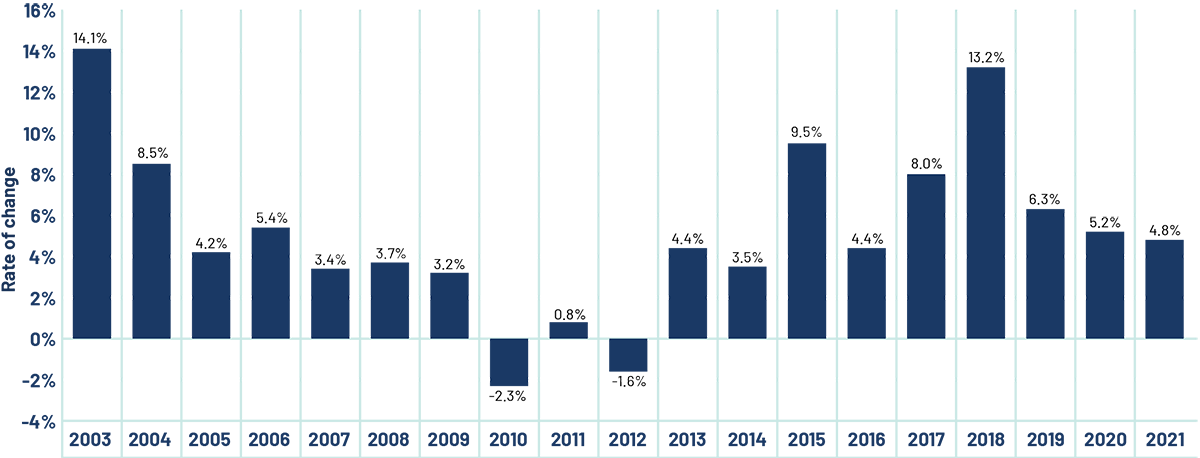
Data source: PMPRB
Figure description
This bar graph depicts the average annual rates of growth in utilization, as measured by the Patented Medicines Quantity Index (PMQI), from 2003 to 2021.
The rate of change in 2003 was 14.1%;
2004: 8.5%;
2005: 4.2%;
2006: 5.4%;
2007: 3.4%;
2008: 3.7%;
2009: 3.2%;
2010: -2.3%;
2011: 0.8%;
2012: -1.6%;
2013: 4.4%;
2014 : 3.5%;
2015: 9.5%;
2016: 4.4%;
2017: 8.0%;
2018: 13.2%;
2019: 6.3%;
2020: 5.2%;
2021: 4.8%.
Canadian Medicine Expenditures in the Global Context
IQVIAFootnote 25 regularly reports on medicine sales across a large number of countries. Based on sales data from this source, Figure 30 provides shares of global sales for Canada and other major national markets including the PMPRB7 countries.Footnote 26 The Canadian market accounted for 2.1% of the global market in 2021.
Figure 31 provides Canada’s share of global sales for 2012 to 2021. The Canadian share has remained between 1.9% and 2.6% throughout this period. Although Canada’s share of 2.1% has been relatively stable in recent years, the US share grew from 40.4% in 2014 to 44.9% in 2021.
Figure 32 gives the average annual rate of growth in total medicine sales for Canada and the PMPRB7, individually and collectively. From 2012 to 2021, sales of medicines in Canada rose at an average annual rate of 4.8%. This is on par with the average rate of growth in medicine sales among the PMPRB7 countries over the same period, though this average is heavily skewed by the influence of US sales.
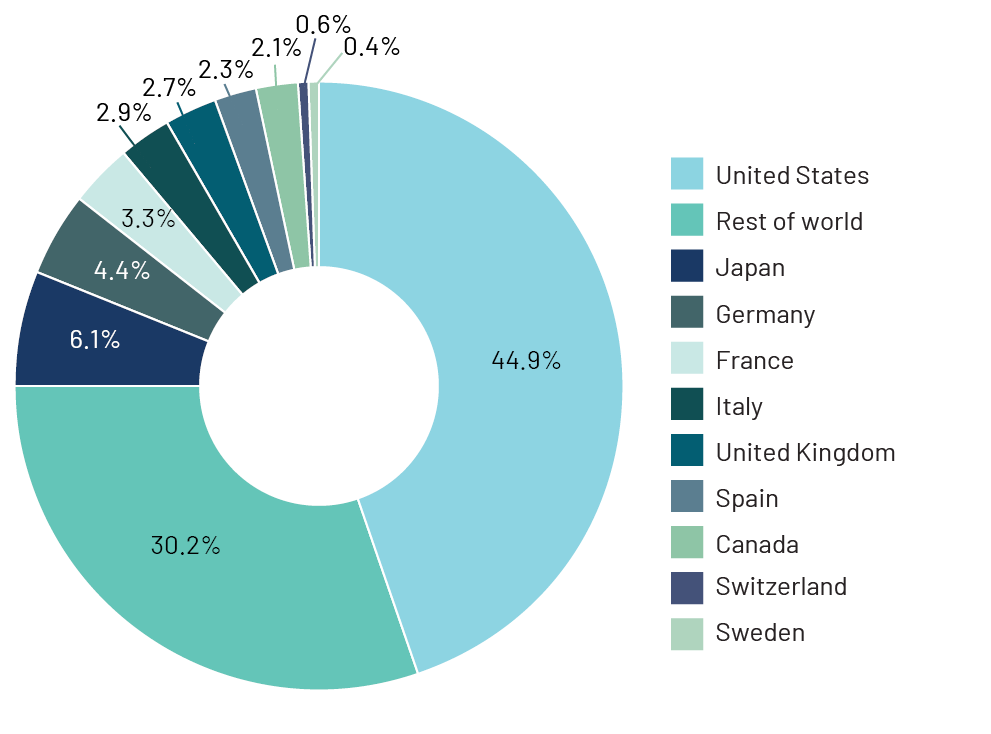
Data source: MIDAS® database, 2021, IQVIA (all rights reserved)
Figure description
This pie chart depicts the distribution of medicine sales among major global markets in 2021.
The US market accounted for 44.9% of the global market in 2021; Japan: 6.1%; Germany: 4.4%; France: 3.3%; Italy: 2.9%; United Kingdom: 2.7%; Spain 2.3%; Canada: 2.1%; Switzerland: 0.6%; Sweden: 0.4%; the rest of the world: 30.2%.
Canada is a top 10 global market
Canada is an important market for pharmaceuticals representing 2.1% of worldwide sales. Canada spends nearly the same amount as the UK on pharmaceuticals despite having only half the population.

Data source: MIDAS® database, 2012–2021, IQVIA (all rights reserved)
Figure description
This bar graph depicts Canada’s share of global medicine sales from 2012 to 2021.
In 2012, Canada made up 2.6% of global sales; 2013: 2.5%; 2014: 2.2%; 2015: 2.0%; 2016: 1.9%; 2017: 2.0%; 2018: 2.1%; 2019: 2.0%; 2020: 2.1%; 2021: 2.1%.
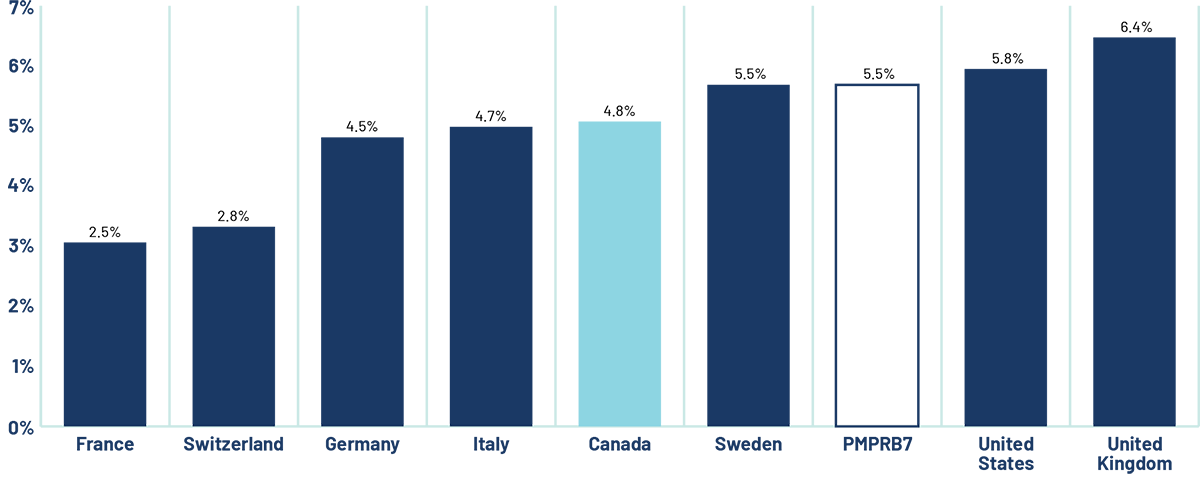
Data source: MIDAS® database, 2012–2021, IQVIA (all rights reserved)
Figure description
This bar graph depicts the average annual rate of growth in total medicine sales for Canada and the PMPRB7 comparator countries from 2012 to 2021.
In France, the average rate of growth was 2.5%; Switzerland: 2.8%; Germany: 4.5%; Italy: 4.7%; Canada: 4.8%; Sweden: 5.5%; United States: 5.8%; United Kingdom: 6.4%. The average rate of growth across all of the PMPRB7 was 5.5%.
Figure 33 compares rates of year-over-year growth in medicine sales for the entire pharmaceutical market in Canada and the PMPRB7 countries combined. In 2021, sales grew at a slightly faster rate in Canada than in the PMPRB7.
The proportion of national income allocated to the purchase of medicines provides another way to compare medicine costs across countries.Footnote 27 Figure 34 gives medicine expenditures as a share of gross domestic product (GDP) for Canada and the PMPRB7 countries based on data for 2019. Medicine expenditures absorbed between 1.1% and 2.1% of the GDP in the PMPRB7. The Canadian value of 1.7% was second only to the US but on par with Germany and just slightly above Italy (1.6%).
1.7% Medicine Expenditures in Canada
In 2019, Canadians spent 1.7% of gross domestic product on medicines. This was the second highest share in the PMPRB7, behind only the US.
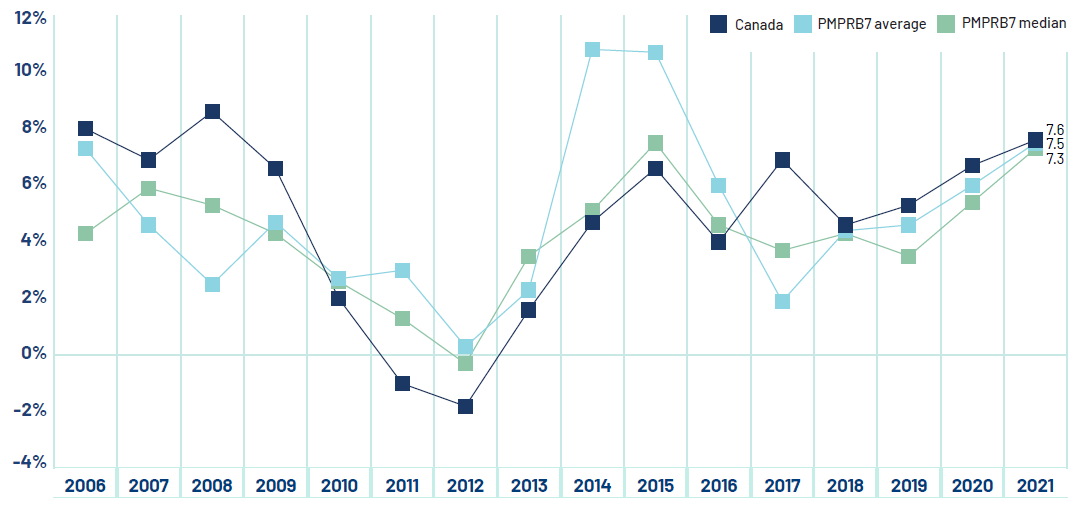
Data source: MIDAS® database, 2006–2021, IQVIA (all rights reserved)
Figure description
This line graph depicts the average annual rate of change in medicine sales, using constant 2021 market exchange rates, for Canada, the average of the PMPRB7 countries, and the PMPRB7 median from 2006 to 2021
| Year | Canada | PMPRB7 average | PMPRB7 median |
|---|---|---|---|
2006 |
8.0 |
7.3 |
4.3 |
2007 |
6.9 |
4.6 |
5.9 |
2008 |
8.6 |
2.5 |
5.3 |
2009 |
6.6 |
4.7 |
4.3 |
2010 |
2.0 |
2.7 |
2.6 |
2011 |
-1.0 |
3.0 |
1.3 |
2012 |
-1.8 |
0.3 |
-0.3 |
2013 |
1.6 |
2.3 |
3.5 |
2014 |
4.7 |
10.8 |
5.1 |
2015 |
6.6 |
10.7 |
7.5 |
2016 |
4.0 |
6.0 |
4.6 |
2017 |
6.9 |
1.9 |
3.7 |
2018 |
4.6 |
4.4 |
4.3 |
2019 |
5.3 |
4.6 |
3.5 |
2020 |
6.7 |
6.0 |
5.4 |
2021 |
7.6 |
7.5 |
7.3 |
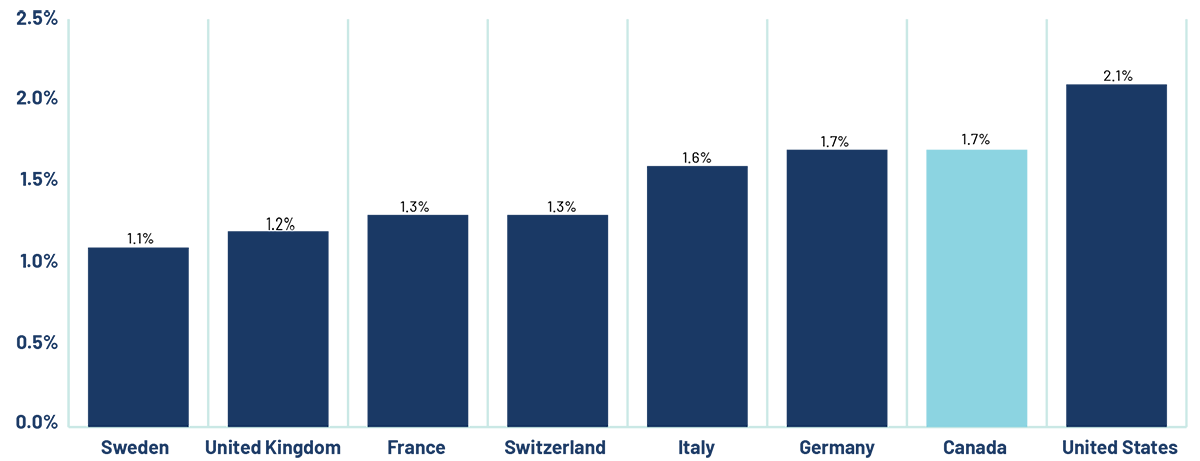
Data source: OECD
Figure description
This bar graph depicts the expenditures for medicines as a share of the gross domestic product (GDP) for Canada and the PMPRB7 comparator countries based on data for 2019.
In Sweden, medicine expenditure was 1.1% of the GDP; United Kingdom: 1.2%; France: 1.3%; Switzerland 1.3%; Italy: 1.6%; Germany: 1.7%; Canada: 1.7%; United States: 2.1%.
Table 12 provides a historical perspective on the expenditures-to-GDP ratio and per capita spending.Footnote 28 Between 2010 and 2019, Canada’s ratio declined, along with the ratios of four other PMPRB7 countries (France, Germany, Italy, and Sweden). In 2019, Canada had the third highest spending per capita on medicines compared to the PMPRB7, behind the US and Germany.
Table 12. Medicine Expenditures as a Share of GDP and Per Capita, Canada and the PMPRB7, 2010 and 2019
| Share: Medicine Expenditures/GDP 2010 | Share: Medicine Expenditures/GDP 2019 | Growth: GDP 2010-2019 | Medicine spending per capita 2010 ($US PPP) |
Medicine spending per capita 2019 ($US PPP) |
|
|---|---|---|---|---|---|
Canada |
1.90% |
1.74% |
35.9% |
$756 |
$864 |
France |
1.86% |
1.32% |
41.3% |
$622 |
$627 |
Germany |
1.72% |
1.67% |
45.2% |
$663 |
$935 |
Italy |
1.60% |
1.57% |
27.2% |
$582 |
$659 |
Sweden |
1.21% |
1.06% |
41.7% |
$466 |
$540 |
Switzerland |
1.11% |
1.34% |
44.1% |
$627 |
$850 |
United Kingdom |
1.13% |
1.17% |
42.8% |
N/A |
$516 |
United States |
2.09% |
2.12% |
42.1% |
$987 |
$1,376 |
Data source: OECD
Table 13 gives the composition of patentees’ sales by therapeutic class for Canada and the PMPRB7, individually by country and as an aggregate.Footnote 29 The results suggest considerable similarity across countries.
Table 13. Distribution of Medicine Sales by Major Therapeutic Class, Canada and the PMPRB7, 2021
| Therapeutic class | Canada | PMPRB7 | France | Germany | Italy | Sweden | Switzerland | United Kingdom | United States |
|---|---|---|---|---|---|---|---|---|---|
A: Alimentary tract and metabolism |
14.3% |
16.6% |
9.1% |
10.4% |
10.5% |
10.8% |
10.7% |
10.6% |
18.6% |
B: Blood and blood-forming organs |
4.8% |
7.3% |
8.7% |
9.3% |
8.8% |
9.8% |
6.7% |
7.5% |
6.8% |
C: Cardiovascular system |
6.1% |
4.6% |
6.1% |
8.0% |
6.6% |
4.0% |
8.9% |
5.6% |
4.0% |
D: Dermatologicals |
2.7% |
2.1% |
1.8% |
1.8% |
3.0% |
2.0% |
3.0% |
1.8% |
2.1% |
G: Genito-urinary system and sex hormones |
3.5% |
2.4% |
2.3% |
2.5% |
2.1% |
2.8% |
3.3% |
2.3% |
2.5% |
H: Systemic hormonal preparations |
1.2% |
2.1% |
1.8% |
1.6% |
1.7% |
2.1% |
1.2% |
1.5% |
2.2% |
J: General anti-infective for systemic use |
8.0% |
9.8% |
9.1% |
11.4% |
8.3% |
10.4% |
8.1% |
9.6% |
10.0% |
L: Antineoplastics and immunomodulating agents |
26.6% |
27.3% |
31.2% |
28.2% |
26.7% |
27.7% |
28.6% |
28.0% |
27.0% |
M: Musculo-skeletal system |
2.9% |
2.9% |
2.4% |
2.9% |
3.4% |
3.5% |
4.6% |
2.4% |
2.9% |
N: Nervous system |
15.5% |
13.0% |
13.1% |
12.3% |
14.1% |
14.2% |
15.1% |
13.3% |
12.9% |
P: Antiparasitic products |
0.1% |
0.1% |
0.1% |
0.0% |
0.1% |
0.1% |
0.1% |
0.1% |
0.1% |
R: Respiratory system |
6.1% |
6.8% |
5.7% |
5.0% |
6.5% |
6.1% |
4.7% |
10.2% |
6.8% |
S: Sensory organs |
4.4% |
2.2% |
3.4% |
1.9% |
2.9% |
3.8% |
4.5% |
4.3% |
2.0% |
V: Various |
3.9% |
2.7% |
5.1% |
4.6% |
5.3% |
2.9% |
0.7% |
2.9% |
2.2% |
All therapeutic classes* |
100% |
100% |
100% |
100% |
100% |
100% |
100% |
100% |
100% |
* Values may not add to 100% due to rounding.
Data source: MIDAS® database 2021, IQVIA (all rights reserved)
National Prescription Drug Utilization Information System: Supporting Health Care Decision Making in Canada
How medications are used—where, by whom, and for what—has an impact on the amount that we spend on medicines. The PMPRB contributes to Canada’s understanding of medicine usage through the National Prescription Drug Utilization Information System (NPDUIS) initiative, generating comprehensive, accurate information to help guide decision making and support the sustainability of our pharmaceutical system.
Background
NPDUIS is a research initiative established by federal, provincial, and territorial Ministers of Health in September 2001. It is a partnership between the PMPRB and the Canadian Institute for Health Information (CIHI).
At the request of the Minister of Health pursuant to section 90 of the Patent Act, the PMPRB has the mandate to conduct analysis that provides decision makers with critical information and intelligence on price, utilization, and cost trends so that Canada’s healthcare system has more comprehensive and accurate information on how medicines are being used and on sources of cost pressures.
The specific research priorities and methodologies for NPDUIS are established with the guidance of the NPDUIS Advisory Committee and reflect the priorities of the participating jurisdictions. The Advisory Committee is composed of representatives from public drug plans in British Columbia, Alberta, Saskatchewan, Manitoba, Ontario, New Brunswick, Nova Scotia, Prince Edward Island, Newfoundland and Labrador, Yukon, the Non-Insured Health Benefits (NIHB) Program, and Health Canada. It also includes observers from the CIHI, the Canadian Agency for Drugs and Technologies in Health (CADTH), the Ministère de la Santé et des Services sociaux du Québec (MSSS), and the pan-Canadian Pharmaceutical Alliance (pCPA) Office.
NPDUIS operates independently of the regulatory activities of the PMPRB. NPDUIS reports do not contain information that is confidential or privileged under sections 87 and 88 of the Patent Act.
Highlights
Since the start of 2021, the PMPRB has published five analytical reports, one chartbook, three posters, and one slide presentation under the NPDUIS banner.
ANNUAL PUBLICATIONS AND REPORT SERIES:
- CompassRx: Annual Public Drug Plan Expenditure Report, 7th Edition, 2019/20 (November 2021)
- Formularies in Canada – Part 2: Oncology Medicines (May 2021)
- Formularies in Canada – Part 3: Medicines Assessed by the Common Drug Review (February 2022)
- Meds Pipeline Monitor, 2021 (April 2022)
- Meds Entry Watch, 6th Edition (April 2022)
Chartbooks:
- Expensive Drugs for Rare Diseases: Canadian Trends and International Comparisons, 2011-2020 (January 2022)
Poster Presentations:
- Playing catch-up: where Canada stands three years into the pCPA-CGPA generics pricing initiative
- A pan-Canadian comparison of coverage for hospital and take-home oncology medicines
- Changes in Canadian Guidelines for Conducting Budget Impact Analysis
Slide Presentations:
The PMPRB continues to support and strengthen its NPDUIS engagement activities by regularly consulting with the NPDUIS Advisory Committee, participating in conferences and stakeholder committees, and organizing bilingual information sessions with interested stakeholders to share the results of the analytical studies.
Research Agenda
The NPDUIS research agenda for the 2022/23 fiscal year includes plans to publish the following analytical studies:
Annual Publications and Report Series
- CompassRx: 8th Edition, 2020/21
- Meds Pipeline Monitor, 2022
- Meds Entry Watch, 7th Edition
- Market Intelligence Report: New Oral Anti-Diabetic Drugs
- Private Drug Plans in Canada
FOCUSED REPORTS
- Drug Shortages in Canada
Additional research topics may be pursued based on consultation with the NPDUIS Advisory Committee.
Analysis of Research and Development Expenditures: At a Historical Low
Innovation is vital to advancing health care. However, the ratio of R&D expenditures to sales revenues for pharmaceutical patentees in Canada has been falling since the late 1990s and has been below the agreed-upon target of 10% since 2003. In 2021, it was at 3.4% for all patentees and 3.5% for members of Innovative Medicines Canada.
3.4% R&D-to-sales ratio
The R&D-to-sales ratio for all patentees was 3.4% in 2021. This represents a 71% decrease from a peak of 11.7% in 1995.
Analysis of Research and Development Expenditures
The Act mandates the PMPRB to monitor and report on pharmaceutical R&D spending. This chapter provides key statistics on the current state of pharmaceutical R&D investment in Canada.
Data Sources
The statistical results in this section were entirely derived from data submitted to the PMPRB by patentees.
The Act requires each patentee to report its total gross revenues from sales of all medicines for human or veterinary use (including revenues from sales of nonpatented medicines and from licensing agreements) and R&D expenditures in Canada related to medicines (both patented and non-patented for human or veterinary use). Patentees transmit this information to the PMPRB by means of its Form 3 (Revenues and Research and Development Expenditures Provided Pursuant to subsection 88(1) of the Patent Act).
The Patented Medicines Regulations (Regulations) require that each submitted Form 3 be accompanied by a certificate stating the information it contains is “true and correct”. The Board does not audit Form 3 submissions, but it does review submitted data for anomalies and inconsistencies, seeking corrections or clarifications from patentees where necessary. To confirm that PMPRB staff has correctly interpreted the data submitted, each patentee is given the opportunity to review and confirm the accuracy of its own R&D-to-sales ratio before that ratio is published.
Failure to File (Form 3)
It is a patentee’s responsibility to ensure a complete and accurate Form 3 is filed within the time frame set out in the Regulations. If a patentee fails to meet these filing requirements, the Board may issue an Order demanding compliance. No such Board Orders were issued for the 2021 reporting period.
Coverage
Note that companies without sales of patented medicines do not need to report their R&D expenditures to the PMPRB. This has two implications:
First, the statistical results reported herein should not be understood as representative of all pharmaceutical research conducted in Canada. For example, a company may sell only non-patented medicines but still perform considerable research. Similarly, a company may conduct research and have no medicine sales at all.Footnote 30 The results presented below will not reflect the R&D expenditures of firms in either scenario.
Second, as new patented medicines enter the Canadian market and existing relevant patents expire, the number and identity of companies required to file R&D data may change from year to year. In 2021, 100 companies reported on their R&D activity. Of these, 37 were members of Innovative Medicines Canada.
Definition of Sales Revenues
For reporting purposes, sales revenues are defined as total gross revenues from sales in Canada of all medicines and from licensing agreements (e.g., royalties and fees accruing to the patentee related to sales in Canada by licensees).
Definition of R&D Expenditures
Pursuant to section 6 of the Regulations, patentees are required to report R&D expenditures that would have qualified for a Scientific Research and Experimental Development (SR&ED) investment tax credit under the provisions of the Income Tax Act that came into effect on December 1, 1987.Footnote 31 By this definition, R&D expenditures may include current expenditures, capital equipment costs, and allowable depreciation expenses. Market research; sales promotions; quality control or routine testing of materials, devices, or products; and routine data collection are not eligible for an investment tax credit, and, therefore, are not to be included in the R&D expenditures reported by patentees.
Total Sales Revenues and R&D Expenditures
Table 14 provides an overview of reported sales revenues and R&D expenditures from 1988 to 2021.
Patentees reported total 2021 sales revenues of $27.5 billion, an increase of 13.2% from 2020. Sales revenues reported by Innovative Medicines Canada members were $21.2 billion, accounting for 77% of the total. Less than 1% of reported sales revenues were generated by licensing agreements. Patentees reported R&D expenditures of $922.9 million in 2021, an increase of 12.2% from 2020. Innovative Medicines Canada members reported R&D expenditures of $735.9 million in 2021, an increase of 11.0% over the previous year. Innovative Medicines Canada members accounted for 80% of all reported R&D expenditures in 2021.
R&D-to-Sales Ratios
Table 14 and Figure 35 also provide ratios of R&D expenditures to sales revenues. It should be noted that with the adoption of the 1987 amendments to the Act, Innovative Medicines Canada made a public commitment to increase its members’ annual R&D expenditures to 10% of sales revenues by 1996.Footnote 32 This level of R&D expenditure was reached by 1993, with the ratio exceeding 10% in some years.
The ratio of R&D expenditures to sales revenues among all patentees was 3.4% in 2021, which remains unchanged from 2020. The overall R&D-to-sales ratio has been less than 10% for the past 21 years.
The corresponding R&D-to-sales ratio for members of Innovative Medicines Canada was 3.5% in 2021, also unchanged from 2020.Footnote 33 The Innovative Medicines Canada ratio has been less than 10% for the past 19 years. Table 21 in Appendix 4 provides details on the range of 2021 R&D-to-sales ratios. Of the 100 companies reporting in 2021, 87.0% had R&D-to-sales ratios below 10%.
Table 14. Total R&D Expenditures and R&D-to-Sales Ratios of Reporting Companies, 1988 to 2021
| Year | All patentees | Innovative Medicines Canada patentees | R&D-to-sales ratio: all patentees | R&D-to-sales ratio: Innovative Medicines Canada patentees | |||||||
|---|---|---|---|---|---|---|---|---|---|---|---|
| Number of companies reporting | R&D expenditures by all patentees ($millions) | Change from previous Year | Sales revenues ($millions) | Change from previous year | R&D expenditures by Innovative Medicines Canada patentees ($millions) | Change from previous year | Sales revenues ($millions) | Change from previous year | |||
2021 |
100 |
$922.9 |
12.2% |
$27,478.5 |
13.2% |
$735.9 |
11.0% |
$21,243.9 |
12.4% |
3.4% |
3.5% |
2020 |
99 |
$822.9 |
-7.9% |
$24,278.2 |
5.1% |
$662.8 |
1.6% |
$18,902.9 |
12.1% |
3.4% |
3.5% |
2019 |
101 |
$893.2 |
0.1% |
$23,101.0 |
1.9% |
$652.6 |
-9.7% |
$16,858.8 |
0.4% |
3.9% |
3.9% |
2018 |
93 |
$892.6 |
2.4% |
$22,663.4 |
7.2% |
$723.0 |
-4.3% |
$16,789.7 |
2.7% |
4.0% |
4.3% |
2017 |
85 |
$871.4 |
-5.1% |
$21,147.2 |
1.4% |
$755.8 |
-1.8% |
$16,349.8 |
4.8% |
4.1% |
4.6% |
2016 |
78 |
$918.2 |
5.7% |
$20,855.7 |
5.9% |
$769.9 |
0.3% |
$15,599.9 |
0.2% |
4.4% |
4.9% |
2015 |
77 |
$869.1 |
9.7% |
$19,693.3 |
6.7% |
$767.4 |
7.8% |
$15,565.1 |
4.7% |
4.4% |
4.9% |
2014 |
75 |
$792.2 |
-0.8% |
$18,455.1 |
1.0% |
$711.7 |
2.0% |
$14,861.1 |
9.2% |
4.3% |
4.8% |
2013 |
81 |
$798.3 |
-14.7% |
$18,268.1 |
1.4% |
$697.5 |
-15.4% |
$13,614.8 |
3.4% |
4.4% |
5.1% |
2012 |
85 |
$936.1 |
-5.6% |
$18,021.1 |
1.3% |
$824.1 |
-8.6% |
$13,162.8 |
-2.1% |
5.2% |
6.3% |
2011 |
79 |
$991.7 |
-15.8% |
$17,798.8 |
4.7% |
$901.2 |
-9.9% |
$13,446.1 |
10.7% |
5.6% |
6.7% |
2010 |
82 |
$1,178.2 |
-7.4% |
$17,000.0 |
-0.3% |
$1,000.2 |
-11.7% |
$12,149.0 |
-11.8% |
6.9% |
8.2% |
2009 |
81 |
$1,272.0 |
-2.9% |
$17,051.9 |
4.5% |
$1,132.9 |
-3.4% |
$13,780.0 |
4.6% |
7.5% |
8.2% |
2008 |
82 |
$1,310.7 |
-1.1% |
$16,316.7 |
2.0% |
$1,172.2 |
-1.0% |
$13,178.2 |
-1.4% |
8.1% |
8.9% |
2007 |
82 |
$1,325.0 |
9.5% |
$15,991.0 |
7.3% |
$1,184.4 |
24.8% |
$13,359.8 |
20.0% |
8.3% |
8.9% |
2006 |
72 |
$1,210.0 |
-1.9% |
$14,902.0 |
4.7% |
$949.0 |
-8.8% |
$11,131.2 |
-5.8% |
8.1% |
8.5% |
2005 |
80 |
$1,234.3 |
5.5% |
$14,231.3 |
0.5% |
$1,040.1 |
3.9% |
$11,821.4 |
0.0% |
8.7% |
8.8% |
2004 |
84 |
$1,170.0 |
-2.0% |
$14,168.3 |
4.0% |
$1,000.8 |
0.8% |
$11,819.0 |
8.8% |
8.3% |
8.5% |
2003 |
83 |
$1,194.3 |
-0.4% |
$13,631.1 |
12.8% |
$992.9 |
-3.6% |
$10,865.7 |
5.2% |
8.8% |
9.1% |
2002 |
79 |
$1,198.7 |
13.0% |
$12,081.2 |
12.5% |
$1,029.6 |
10.1% |
$10,323.8 |
16.8% |
9.9% |
10.0% |
2001 |
74 |
$1,060.1 |
12.6% |
$10,732.1 |
15.3% |
$935.2 |
14.7% |
$8,835.4 |
14.3% |
9.9% |
10.6% |
2000 |
79 |
$941.8 |
5.3% |
$9,309.6 |
12.0% |
$815.5 |
4.0% |
$7,728.8 |
11.6% |
10.1% |
10.6% |
1999 |
78 |
$894.6 |
12.0% |
$8,315.5 |
19.2% |
$784.3 |
9.9% |
$6,923.4 |
22.8% |
10.8% |
11.3% |
1998 |
74 |
$798.9 |
10.2% |
$6,975.2 |
10.9% |
$713.7 |
8.6% |
$5,640.2 |
10.6% |
11.5% |
12.7% |
1997 |
75 |
$725.1 |
9.0% |
$6,288.4 |
7.4% |
$657.4 |
10.3% |
$5,098.2 |
4.9% |
11.5% |
12.9% |
1996 |
72 |
$665.3 |
6.4% |
$5,857.4 |
9.9% |
$595.8 |
6.5% |
$4,859.5 |
8.7% |
11.4% |
12.3% |
1995 |
71 |
$625.5 |
11.5% |
$5,330.2 |
7.5% |
$559.5 |
9.8% |
$4,468.8 |
1.4% |
11.7% |
12.5% |
1994 |
73 |
$561.1 |
11.4% |
$4,957.4 |
4.4% |
$509.5 |
10.4% |
$4,407.2 |
2.0% |
11.3% |
11.6% |
1993 |
70 |
$503.5 |
22.1% |
$4,747.6 |
14.0% |
$461.4 |
24.0% |
$4,321.4 |
14.4% |
10.6% |
10.7% |
1992 |
71 |
$412.4 |
9.6% |
$4,164.4 |
6.9% |
$372.1 |
9.0% |
$3,778.4 |
6.5% |
9.9% |
9.8% |
1991 |
65 |
$376.4 |
23.2% |
$3,894.8 |
18.1% |
$341.4 |
24.7% |
$3,546.9 |
19.5% |
9.7% |
9.6% |
1990 |
65 |
$305.5 |
24.8% |
$3,298.8 |
11.0% |
$273.8 |
25.8% |
$2,967.9 |
10.5% |
9.3% |
9.2% |
1989 |
66 |
$244.8 |
47.4% |
$2,973.0 |
9.4% |
$217.6 |
34.7% |
$2,685.5 |
7.3% |
8.2% |
8.1% |
1988 |
66 |
$165.7 |
– |
$2,718.0 |
– |
$161.5 |
– |
$2,502.3 |
– |
6.1% |
6.5% |
Data source: PMPRB
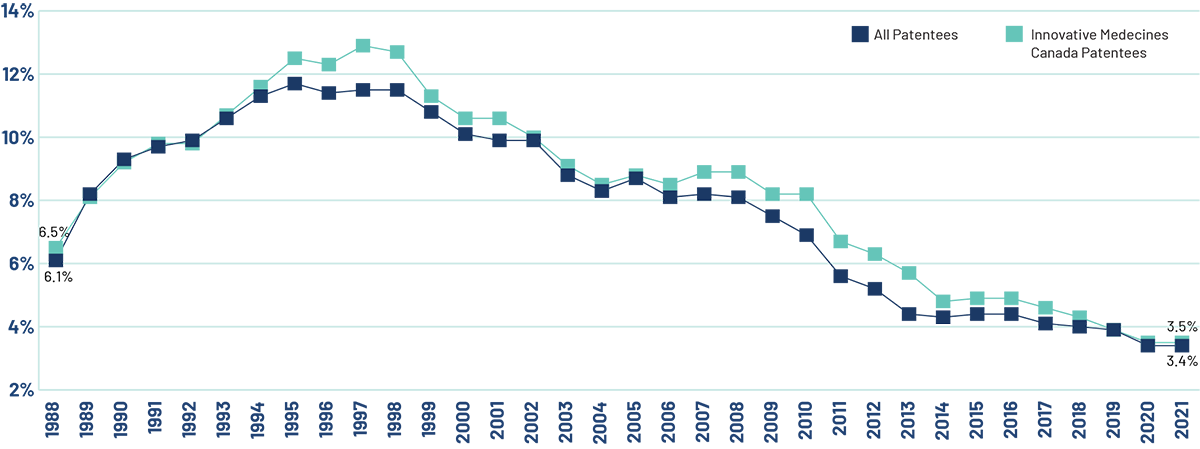
Data source: PMPRB
Figure description
This line graph depicts the annual the R&D-to-sales ratio for all patentees and members of Innovative Medicines Canada (IMC) from 1988 to 2021.
IMC Patentees: 1988: 6.5%; 1989: 8.1%; 1990: 9.2%; 1991: 9.8%; 1992: 9.8%; 1993: 10.7%; 1994: 11.6%; 1995: 12.5%; 1996: 12.3%; 1997: 12.9%; 1998: 12.7%; 1999: 11.3%; 2000: 10.6%; 2001: 10.6%; 2002: 10.0%; 2003: 9.1%; 2004: 8.5%; 2005: 8.8%; 2006: 8.5%; 2007: 8.9%; 2008: 8.9%; 2009: 8.2%; 2010: 8.2%; 2011: 6.7%; 2012: 6.3%; 2013: 5.7%; 2014: 4.8%; 2015: 4.9%; 2016: 4.9%; 2017: 4.6%; 2018: 4.3%; 2019: 3.9%; 2020: 3.5%; 2021: 3.5%.
All Patentees: 1988: 6.1%; 1989: 8.2%; 1990: 9.3%; 1991: 9.7%; 1992: 9.9%; 1993: 10.6%; 1994: 11.3%; 1995: 11.7%; 1996: 11.4%; 1997: 11.5%; 1998: 11.5%; 1999: 10.8%; 2000: 10.1%; 2001: 9.9%; 2002: 9.9%; 2003: 8.8%; 2004: 8.3%; 2005: 8.7%; 2006: 8.1%; 2007: 8.2%; 2008: 8.1%; 2009: 7.5%; 2010: 6.9%; 2011: 5.6%; 2012: 5.2%; 2013: 4.4%; 2014: 4.3%; 2015: 4.4%; 2016: 4.4%; 2017: 4.1%; 2018: 4.0%; 2019: 3.9%; 2020: 3.4%; 2021: 3.4%.
Current R&D Expenditures by Type of Research
Table 15 and Figure 36 (as well as Figure 38 in Appendix 4) provide information on the allocation of 2021 R&D expendituresFootnote 34 in basic and applied research as well as other qualifying R&D.Footnote 35 Patentees reported spending $112.7 million on basic research in 2021, representing 12.6% of current R&D expenditures, a decrease of 1.1% over the previous year. A reported $507.7 million was spent on applied research, representing 56.9% of current R&D expenditures. Clinical trials (Phase I to III) accounted for 81.0% of applied research expenditures.
Table 15. Current R&D Expenditures by Type of Research, 2021 and 2020
| Type of research | Expenditures: 2021 ($millions) | Share: 2021 | Expenditures: 2020 ($millions) | Share: 2020 | Annual change in expenditures |
|---|---|---|---|---|---|
Basic |
$112.7 |
12.6% |
$113.9 |
14.2% |
-1.1% |
Chemical |
$70.6 |
7.9% |
$71.5 |
8.9% |
-1.3% |
Biological |
$42.1 |
4.7% |
$42.4 |
5.3% |
-0.7% |
Applied |
$507.7 |
56.9% |
$455.5 |
56.8% |
11.5% |
Manufacturing process |
$44.3 |
5.0% |
$42.5 |
5.3% |
4.2% |
Pre-clinical trial I |
$31.6 |
3.5% |
$26.6 |
3.3% |
18.8% |
Pre-clinical trial II |
$19.7 |
2.2% |
$17.5 |
2.2% |
12.6% |
Clinical trial Phase I |
$53.1 |
5.9% |
$57.3 |
7.2% |
-7.3% |
Clinical trial Phase II |
$78.3 |
8.8% |
$69.1 |
8.6% |
13.3% |
Clinical trial Phase III |
$280.7 |
31.5% |
$242.4 |
30.2% |
15.8% |
Other qualifying R&D |
$272.1 |
30.5% |
$232.4 |
29.0% |
17.1% |
Total* |
$892.5 |
100% |
$801.7 |
100% |
11.3% |
* Values may not add to totals due to rounding.
Data source: PMPRB

Data source: PMPRB
Figure description
This stacked bar graph depicts the share of current R&D expenditures from 1988 to 2021 by type of research: basic, applied, and other qualifying.
| Year | Basic research (%) | Applied research (%) | Other qualifying research (%) |
|---|---|---|---|
1988 |
19.1 |
67.2 |
13.7 |
1989 |
23.4 |
62.7 |
13.9 |
1990 |
27.2 |
58.0 |
14.8 |
1991 |
26.5 |
57.3 |
16.2 |
1992 |
26.4 |
57.1 |
16.5 |
1993 |
25.3 |
60.3 |
14.4 |
1994 |
21.9 |
62.7 |
15.4 |
1995 |
22.1 |
61.8 |
16.1 |
1996 |
21.7 |
62.9 |
15.4 |
1997 |
20.7 |
62.0 |
17.3 |
1998 |
19.6 |
61.1 |
19.4 |
1999 |
18.4 |
63.3 |
18.3 |
2000 |
17.8 |
61.3 |
20.9 |
2001 |
16.1 |
59.9 |
24.0 |
2002 |
17.4 |
55.8 |
26.6 |
2003 |
15.3 |
55.2 |
29.1 |
2004 |
19.7 |
58.3 |
21.7 |
2005 |
18.2 |
62.4 |
19.5 |
2006 |
20.0 |
59.5 |
20.5 |
2007 |
20.3 |
54.4 |
25.6 |
2008 |
15.9 |
57.3 |
26.8 |
2009 |
19.4 |
56.2 |
24.3 |
2010 |
21.1 |
54.8 |
24.2 |
2011 |
17.3 |
55.0 |
27.8 |
2012 |
12.6 |
57.9 |
29.4 |
2013 |
8.7 |
63.5 |
27.8 |
2014 |
10.7 |
60.9 |
28.4 |
2015 |
12.9 |
57.7 |
29.3 |
2016 |
12.6 |
59.5 |
27.9 |
2017 |
13.1 |
60.2 |
26.7 |
2018 |
12.2 |
59.2 |
28.6 |
2019 |
13.5 |
59.9 |
26.6 |
2020 |
14.2 |
56.8 |
29.0 |
2021 |
12.6 |
56.9 |
30.5 |
Current R&D Expenditures by Performer
Patentees report expenditures on research they conduct themselves (intramural) and research performed by other establishments, such as universities, hospitals, and other manufacturers (extramural).
Table 16 shows that 46.8% of 2021 current research expenditures were intramural. Research performed by other companies on behalf of patentees made up 25.3% of current expenditures, while research conducted in universities and hospitals accounted for 16.6%.
Table 16. Current R&D Expenditures by R&D Performer, 2021 and 2020
| R&D performer | Expenditures: 2021 ($millions) | Share: 2021 | Expenditures: 2020 ($millions) | Share: 2020 | Annual change in expenditures |
|---|---|---|---|---|---|
Intramural |
|||||
Patentees |
$417.3 |
46.8% |
$368.1 |
45.9% |
13.4% |
Extramural |
|||||
Universities and hospitals |
$147.9 |
16.6% |
$152.5 |
19.0% |
-3.0% |
Other companies |
$225.9 |
25.3% |
$211.9 |
26.4% |
6.6% |
Others |
$101.4 |
11.4% |
$69.2 |
8.6% |
46.5% |
Total* |
$892.5 |
100% |
$801.7 |
100% |
11.3% |
* Values may not add to totals due to rounding.
Data source: PMPRB
Current R&D Expenditures by Region
Table 17 (as well as Tables 23 and 24 in Appendix 4) show current R&D expenditures by region. As in previous years, current expenditures were heavily concentrated in Ontario and Quebec in 2021, with these provinces accounting for 78.6% of total expenditures. Between 2020 and 2021, R&D expenditures decreased at a year-over-year rate of 27.0% in the Atlantic provinces and increased at a rate of 3.3% in Quebec, 14.1% in Ontario, and 20.6% in Western Canada.
Table 17. Current R&D Expenditures by Region, 2021 and 2020
| Region | Expenditures: 2021 ($millions) | Share: 2021 | Expenditures: 2020 ($millions) | Share: 2020 | Annual change in expenditures |
|---|---|---|---|---|---|
Atlantic provinces |
$13.0 |
1.5% |
$17.8 |
2.2% |
-27.0% |
Quebec |
$235.0 |
26.3% |
$227.5 |
28.4% |
3.3% |
Ontario |
$466.4 |
52.3% |
$408.7 |
51.0% |
14.1% |
Western provinces |
$178.0 |
19.9% |
$147.6 |
18.4% |
20.6% |
Territories |
$0.1 |
0.0% |
$0.0 |
0.0% |
199.8% |
Total* |
$892.5 |
100% |
$801.7 |
100% |
11.3% |
* Values may not add to totals due to rounding.
Data source: PMPRB
Total R&D Expenditures by Source of Funds
Table 18 provides information on the sources of funds used by patentees to finance their R&D activity. Internal company funds remained by far the single largest source of funding in 2021, accounting for 90.2% of total expenditures. Funds received from government amounted to 0.5% of total expenditures.
Table 18. Total R&D Expenditures by Source of Funds, 2021 and 2020
| Source of funds | Expenditures: 2021 ($millions) | Share: 2021 | Expenditures: 2020 ($millions) | Share: 2020 | Annual change in expenditures |
|---|---|---|---|---|---|
Company funds |
$832.3 |
90.2% |
$745.9 |
90.6% |
11.6% |
Federal/provincial governments |
$5.0 |
0.5% |
$5.2 |
0.6% |
-3.9% |
Others |
$85.7 |
9.3% |
$71.8 |
8.7% |
19.4% |
Total* |
$922.9 |
100% |
$822.9 |
100% |
12.2% |
* Values may not add to totals due to rounding.
Data source: PMPRB
The Global Context
Figure 37 compares Canadian pharmaceutical R&D-to-sales ratios to those of the PMPRB7 in 2000, 2009, and 2019. These three years of data provide a snapshot of observed market trends over the past 20 years.
Starting in 2000, Canada had an R&D-to-sales ratio of 10.1%, lower than all PMPRB7 countries except for Italy at 6.2%. Canada’s R&D-to-sales ratio moved down to 7.5% in 2009, likewise remaining below all PMPRB7 countries except for Italy at 6.6%. In 2019, Canada’s R&D-to-sales ratio dropped below that in Italy, becoming the lowest among all comparator countries at 3.9%. Across all three years, Switzerland’s ratios were much higher than the other comparator countries, rising from 102.5% in 2000 to 133.5% in 2009 and decreasing slightly to 115.4% in 2019.
The ratio obtained by aggregating R&D spending and sales across all PMPRB7 countries was 22.7%, more than five times that in Canada. The R&D-to-sales ratios represented in Figure 37 may be compared to the average bilateral price ratios reported in Table 9 (see “Comparison of Canadian Prices to Foreign Prices”). A number of comparator countries with patented medicine prices that are, on average, lower than prices in Canada, have achieved much higher R&D-to-sales ratios.
There are a multitude of factors that drive the location of pharmaceutical R&D, including where companies can find the best science base at a reasonable cost and have ready access to a quality clinical trials infrastructure. Although price levels and intellectual property protection are often cited as an important policy lever for attracting R&D, the data has not supported this link domestically or internationally.
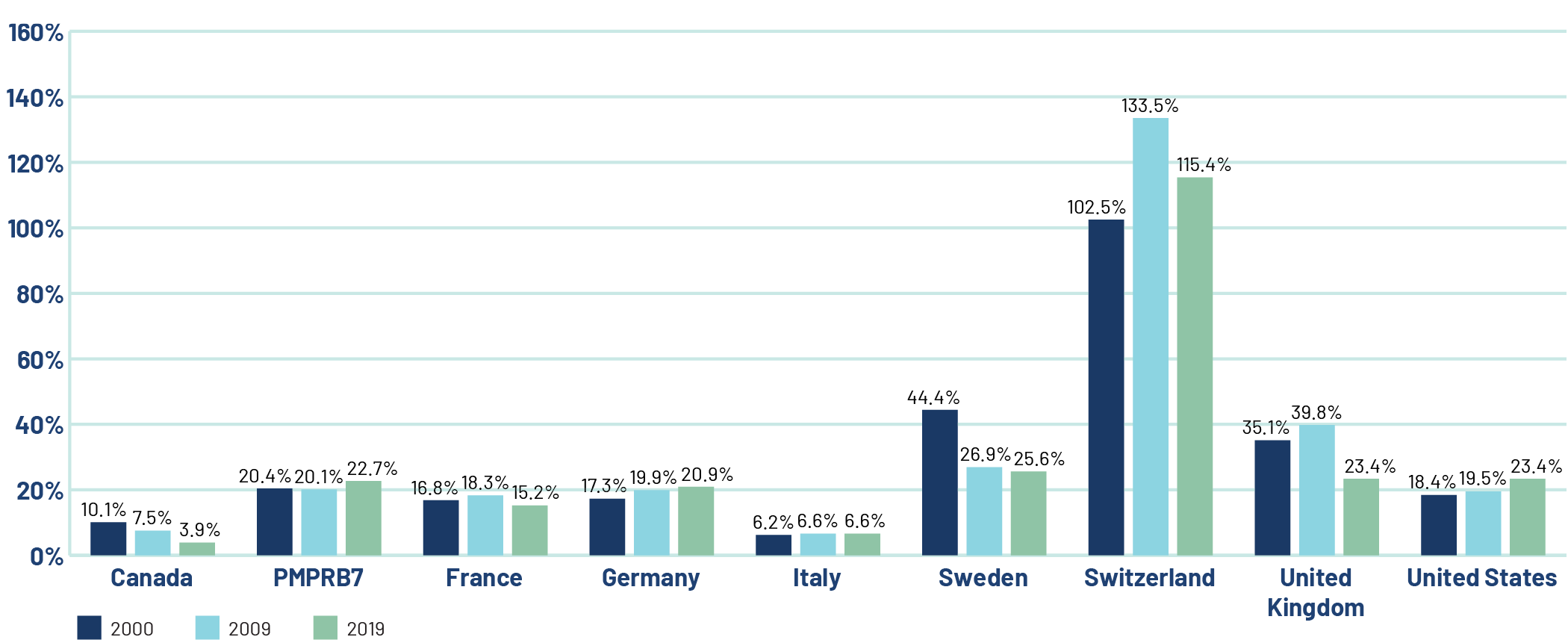
Data source: PMPRB; European Federation of Pharmaceutical Industries and Associations (EFPIA): The Pharmaceutical Industry in Figures 2021; PhRMA 2021 profile
Figure description
This bar graph depicts R&D-to-sales ratios for Canada and the PMPRB7 comparator countries for 2000, 2009, and 2019.
2000 – Canada: 10.1%; PMPRB7: 20.4%; France: 16.8%; Germany: 17.3%; Italy: 6.2%; Sweden: 44.4%; Switzerland: 102.5%; United Kingdom: 35.1%; United States: 18.4%.
2009 – Canada: 7.5%; PMPRB7: 20.1%; France: 18.3%; Germany: 19.9%; Italy: 6.6%; Sweden: 26.9%; Switzerland: 133.5%; United Kingdom: 39.8%; United States: 19.5%.
2019 – Canada: 3.9%; PMPRB7: 22.7%; France: 15.2%; Germany: 20.9%; Italy: 6.6%; Sweden: 25.6%; Switzerland: 115.4%; United Kingdom: 23.4%; United States: 23.4%.
The PMPRB7 average R&D ratio is more than 5x greater than in Canada.
The R&D-to-sales ratio obtained by aggregating R&D spending and sales across all seven comparator countries in 2019 was 22.7%, compared to just 3.9% in Canada.
Appendix 1: Glossary
These definitions are provided for general assistance only; they have no legal force and should be read in conjunction with the applicable legislation.
Active Ingredient or Medicinal Ingredient: Chemical or biological substance responsible for the claimed pharmacologic effect of a medicine.
ATC : Anatomical Therapeutic Chemical (ATC ) classification system, developed and maintained by the World Health Organization (WHO) Collaborating Centre for Drug Statistics Methodology, which divides medicines into different groups according to their site of action and therapeutic and chemical characteristics. This system is used by the PMPRB as a guide for selecting comparable medicines for purposes of price review under the Guidelines.
Drug Identification Number (DIN): A registration number (drug identification number) that the Health Products and Food Branch of Health Canada assigns to each prescription and non-prescription drug product marketed under the Food and Drug Regulations. A DIN uniquely identifies the following product characteristics: manufacturer; product name; active ingredient(s); strength of active ingredient(s); pharmaceutical dosage form; route of administration. Different strengths and dosage forms of a medicine may be assigned different DINs.
Drug Product: A particular presentation of a medicine characterized by its pharmaceutical dosage form and the strength of the active ingredient(s) (see “medicine” below).
Failure to File: The complete or partial failure of a patentee to comply with regulatory filing requirements pursuant to the Patent Act and the Patented Medicines Regulations.
Failure to Report: The complete failure of a patentee to have reported a patented medicine being sold in accordance with regulatory filing requirements pursuant to the Patent Act and the Patented Medicines Regulations.
License, Voluntary: A contractual agreement between a patent holder and a licensee under which the licensee is entitled to enjoy the benefit of the patent or to exercise any rights in relation to the patent for some consideration (e.g., royalties in the form of a share of the licensee’s sales).
Medicine: A medicinal ingredient and/or a substance or a mixture of substances manufactured, sold or represented for use in the diagnosis, treatment, mitigation or prevention of a disease, disorder or abnormal physical state, or its symptoms, in human beings or animals; or restoring, correcting or modifying organic functions in human beings or animals.
Notice of Compliance (NOC): A notice issued under section C.08.004 or C.08.004.01 of the Food and Drug Regulations. The issuance of an NOC indicates that a drug product meets the required Health Canada standards for use in humans or animals and that the manufacturer of the product is authorized to market the product in Canada.
Patent: An instrument issued by the Commissioner of Patents in the form of letters patent for an invention.
Patented Medicine Price Index (PMPI): The PMPI was developed by the PMPRB as a measure of average year-over-year change in the transaction prices of patented medicines sold in Canada, based on the price and sales information reported by patentees.
Patentee: As defined by subsection 79(1) of the Patent Act, “the person for the time being entitled to the benefit of the patent for that invention and includes, where any other person is entitled to exercise any rights in relation to that patent other than under a license continued by subsection 11(1) of the Patent Act Amendment Act, 1992, that other person in respect of those rights”.
PMPRB7: France, Germany, Italy, Sweden, Switzerland, the United Kingdom, and the United States.
Research and Development (R&D): Basic or applied research for the purpose of creating new, or improving existing, materials, devices, products, or processes (e.g., manufacturing processes).
Research and Development—Applied Research: R&D directed toward a specific practical application, comprising research intended to improve manufacturing processes, pre-clinical trials, and clinical trials.
Research and Development—Basic Research: R&D defined as work that advances scientific knowledge without a specific application in mind.
Research and Development—Other Qualifying: Eligible research and development expenditures that cannot be classified into any of the preceding categories of “type of research and development”. It includes regulatory submissions, bioavailability studies, and Phase IV clinical trials.
Research and Development Expenditures: For the purposes of the Patented Medicines Regulations, in particular Sections 5 and 6, research and development includes activities for which expenditures would have qualified for the investment tax credit for scientific research and experimental development under the Income Tax Act as it read on December 1, 1987.
Research and Development Expenditures–Current: Consist of the following non-capital expenses directly related to research work: (a) wages and salaries, (b) direct material, (c) contractors and subcontractors, (d) other direct costs such as factory overhead, (e) payments to designated institutions, (f) payments to granting councils, and (g) payments to other organizations. These elements are described in greater detail in the Patentees’ Guide to Reporting—Form 3, available on the PMPRB Website under Regulatory Filings.
Special Access Program (SAP): A program operated by Health Canada to give practitioners access to medicines that are not approved or otherwise available in Canada.
Voluntary Compliance Undertaking (VCU): A written undertaking by a patentee to adjust its price to conform to the Board’s Guidelines. A VCU represents a promise by a patentee geared towards a satisfactory resolution of an investigation initiated by Staff as per the Guidelines. A VCU takes into account the specific facts and underlying context of a particular case. As such, VCUs are not intended to have precedential value.
Appendix 2: Patented Medicines/New Dosage Forms and Strengths First Reported to the PMPRB in 2021
Table 19. Patented medicines first reported to the PMPRB in 2021
| Brand Name – Dosage Form and Strength | Company | DIN | Status - Full Year 2021 | Level of Theraputic Improvement |
|---|---|---|---|---|
AJOVY - 225 MG/AUTO-INJECTOR |
Teva Canada Innovation G.P.-S.E.N.C. |
2509474 |
VCU |
SN |
AMGEVITA - 40 MG/SYRINGE |
Amgen Canada Inc. |
2459299 |
Within Guidelines |
SN |
AMGEVITA - 40 MG/AUTO-INJECTOR |
Amgen Canada Inc. |
2459302 |
Within Guidelines |
SN |
AMGEVITA - 20 MG/SYRINGE |
Amgen Canada Inc. |
2459310 |
Within Guidelines |
SN |
BRUKINSA - 80 MG/CAPSULE |
BeiGene Ltd |
2512963 |
Within Guidelines |
SN |
CREON MINIMICROSPHERES 35 - 35000 UNIT/CAPSULE |
BGP Pharma ULC |
2494639 |
Does Not Trigger |
SN |
DOJOLVI - 1000 MG/ML |
Ultragenyx Pharmaceuticals Inc. |
2512556 |
Does Not Trigger |
SN |
DUPIXENT - 300 MG/AUTO-INJECTOR |
Sanofi-Aventis Canada Inc. |
2510049 |
Subject to Investigation |
SN |
EMGALITY - 100 MG/ML |
Eli Lilly Canada Inc. |
2505134 |
Under Review |
Under Review |
EVRYSDI - 0.75 MG/ML |
Hoffmann-La Roche Ltd |
2514931 |
Subject to Investigation |
SN |
FASENRA PEN - 30 MG/DOSE |
AstraZeneca Canada Inc. |
2496135 |
Within Guidelines |
SN |
HADLIMA - 40 MG/SYRINGE |
Organon Canada Inc. |
2473097 |
Within Guidelines |
SN |
HADLIMA PUSH TOUCH - 40 MG/AUTO-INJECTOR |
Organon Canada Inc. |
2473100 |
Within Guidelines |
SN |
HIZENTRA - 200 MG/ML |
CSL Behring Canada Inc. |
2498251 |
Within Guidelines |
SN |
JANSSEN COVID-19 VACCINE - 0.5 ML/DOSE |
Janssen Inc. |
2513153 |
Under Review |
Under Review |
JORVEZA - 1 MG/TABLET |
Avir Pharma Inc. |
2493675 |
Subject to Investigation |
SN |
KESIMPTA - 20 MG/PEN |
Novartis Pharmaceuticals Canada Inc. |
2511355 |
Does Not Trigger |
SN |
NIROGACESTAT - 100 MG/TABLET |
SpringWorks Therapeutics Inc. |
– |
Under Review |
Under Review |
NIROGACESTAT - 50 MG/TABLET |
SpringWorks Therapeutics Inc. |
– |
Under Review |
Under Review |
NIROGACESTAT - 10 MG/TABLET |
SpringWorks Therapeutics Inc. |
– |
Under Review |
Under Review |
PHESGO 60/60 - 120 MG/ML |
Hoffmann-La Roche Ltd |
2512920 |
Subject to Investigation |
SN |
PHESGO 80/40 - 120 MG/ML |
Hoffmann- |
2512912 |
Subject to Investigation |
SN |
POTELIGEO - 4 MG/ML |
Kyowa Kirin Inc. |
Under Review |
Under Review |
|
QINLOCK - 50 MG/TABLET |
Medison Pharma Canada Inc. |
2500833 |
Subject to Investigation |
MI-P |
RIABNI - 10 MG/ML |
Amgen Canada Inc. |
2513447 |
Within Guidelines |
SN |
TAKHZYRO - 150 MG/ML |
Takeda Canada Inc. |
2505614 |
Within Guidelines |
SN |
TAVALISSE - 100 MG/TABLET |
Medison Pharma Canada Inc. |
2508052 |
Subject to Investigation |
SN |
TAVALISSE - 150 MG/TABLET |
Medison Pharma Canada Inc. |
2508060 |
Within Guidelines |
SN |
ADYNOVATE - 250 IU/VIAL |
Takeda Canada Inc. |
2498537 |
Under Review |
Under Review |
ADYNOVATE - 500 IU/VIAL |
Takeda Canada Inc. |
2498545 |
Under Review |
Under Review |
ADYNOVATE - 1000 IU/VIAL |
Takeda Canada Inc. |
2498588 |
Under Review |
Under Review |
ARIKAYCE - 590 MG/VIAL |
Insmed Inc. |
– |
Under Review |
Under Review |
BRAFTOVI - 75 MG/CAPSULE |
Pfizer Canada ULC |
2513099 |
Under Review |
Under Review |
CEQUA - 0.9 MG/ML |
Sun Pharmaceutical Industries Inc. |
2512629 |
Under Review |
Under Review |
ENHERTU - 100 MG/VIAL |
AstraZeneca Canada Inc. |
2514400 |
Under Review |
Under Review |
JORVEZA - 0.5 MG/TABLET |
Avir Pharma Inc. |
2513854 |
Under Review |
Under Review |
KALYDECO - 25 MG/PACK |
Vertex Pharmaceuticals Canada Inc. |
2519364 |
Under Review |
Under Review |
KANJINTI - 150 MG/VIAL |
Amgen Canada Inc. |
2518244 |
Under Review |
Under Review |
MEKTOVI - 15 MG/TABLET |
Pfizer Canada ULC |
2513080 |
Under Review |
Under Review |
MINJUVI - 200 MG/VIAL |
Incyte Biosciences Canada Corporation |
2518627 |
Under Review |
Under Review |
NEXTSTELLIS 15/3 - 18 MG/TABLET |
Searchlight Pharma Inc. |
2513218 |
Under Review |
Under Review |
ONUREG - 200 MG/TABLET |
Celgene Inc. |
2510197 |
Under Review |
Under Review |
ONUREG- 300 MG/TABLET |
Celgene Inc. |
2510200 |
Under Review |
Under Review |
OPSYNVI - 50 MG/TABLET |
Janssen Inc. |
2521083 |
Under Review |
Under Review |
POLIVY - 30 MG/VIAL |
Hoffmann- |
2515431 |
Under Review |
Under Review |
PONVORY - 1/KIT |
Janssen Inc. |
2515474 |
Under Review |
Under Review |
PONVORY - 20 MG/TABLET |
Janssen Inc. |
2515482 |
Under Review |
Under Review |
RINVOQ - 30 MG/TABLET |
AbbVie Corporation |
2520893 |
Under Review |
Under Review |
SUBOXONE 4/1 - 5 MG/FILM |
Indivior Canada Ltd |
2502321 |
Under Review |
Under Review |
TISSUEBLUE - 0.25 MG/ML |
Dutch Ophthalmic Research Center (International) B.V. |
2510995 |
Under Review |
Under Review |
TRELEGY ELLIPTA 200/62.5/25 - 287.5 MCG/DOSE |
GlaxoSmithKline Inc. |
2515776 |
Within Guidelines |
SN |
TEPMETKO - 225 MG/TAB |
EMD Serono Canada Inc. |
2516322 |
Under Review |
Under Review |
TRODELVY - 180 MG/VIAL |
Gilead Sciences Canada Inc. |
2520788 |
Under Review |
Under Review |
VIMIZIM - 1 MG/ML |
BioMarin Pharmaceutical Canada Inc. |
2427184 |
Under Review |
Under Review |
VERQUVO - 2.5 MG/TABLET |
Bayer Inc. |
– |
Under Review |
Under Review |
VERQUVO - 5 MG/TABLET |
Bayer Inc. |
– |
Under Review |
Under Review |
VERQUVO - 10 MG/TABLET |
Bayer Inc. |
– |
Under Review |
Under Review |
XARELTO - 1 MG/ML |
Bayer Inc. |
2510162 |
Under Review |
Under Review |
XARELTO - 1 MG/ML |
Bayer Inc. |
2510170 |
Under Review |
Under Review |
- SN Slight or No Improvement
- MI-S Moderate Improvement – Secondary
- MI-P Moderate Improvement – Primary
- SI Substantial Improvement
- B Breakthrough
Appendix 3: Pharmaceutical Trends - Sales
Table 20. Sales of Patented Medicines, 1990 to 2021
| Year | Patented medicine | 5-year compound annual growth rate | Sales of patented medicines as a share of all medicine sales* | Patented medicine sales per capita | Change in patented medicine sales per capita | Patented medicine sales per GDP | |
|---|---|---|---|---|---|---|---|
| Sales ($billions) | Change | ||||||
2021 |
$17.4 |
-1.7% |
2.2% |
51.0% |
$456.14 |
-3.3% |
0.758% |
2020 |
$17.7 |
3.0% |
3.2% |
55.4% |
$472.00 |
2.9% |
0.801% |
2019 |
$17.2 |
3.5% |
4.5% |
57.5% |
$458.60 |
2.7% |
0.748% |
2018 |
$16.7 |
-0.6% |
4.5% |
59.0% |
$446.30 |
-1.7% |
0.751% |
2017 |
$16.8 |
7.6% |
5.4% |
61.5% |
$454.09 |
5.4% |
0.783% |
2016 |
$15.6 |
3.3% |
3.9% |
60.8% |
$430.94 |
2.2% |
0.770% |
2015 |
$15.1 |
9.4% |
4.0% |
61.6% |
$421.80 |
8.5% |
0.760% |
2014 |
$13.8 |
3.1% |
1.2% |
59.9% |
$388.70 |
1.8% |
0.696% |
2013 |
$13.4 |
4.2% |
1.2% |
60.7% |
$381.80 |
2.7% |
0.706% |
2012 |
$12.9 |
0.1% |
1.3% |
59.2% |
$371.80 |
-1.2% |
0.708% |
2011 |
$12.9 |
3.5% |
2.0% |
58.3% |
$376.10 |
3.1% |
0.729% |
2010 |
$12.4 |
-4.3% |
2.6% |
55.8% |
$364.70 |
-5.7% |
0.746% |
2009 |
$13.0 |
2.9% |
4.4% |
59.6% |
$386.90 |
1.9% |
0.829% |
2008 |
$12.6 |
4.6% |
5.4% |
61.7% |
$379.50 |
2.9% |
0.762% |
2007 |
$12.1 |
3.2% |
6.3% |
63.2% |
$368.90 |
2.5% |
0.769% |
2006 |
$11.7 |
7.4% |
9.0% |
67.8% |
$360.00 |
6.3% |
0.784% |
2005 |
$10.9 |
4.2% |
11.6% |
70.6% |
$338.50 |
2.8% |
0.769% |
2004 |
$10.5 |
7.8% |
14.2% |
72.2% |
$329.20 |
7.2% |
0.789% |
2003 |
$9.7 |
9.0% |
17.7% |
72.7% |
$307.00 |
8.0% |
0.776% |
2002 |
$8.9 |
17.5% |
19.2% |
67.4% |
$284.30 |
16.0% |
0.748% |
2001 |
$7.6 |
18.9% |
20.4% |
65.0% |
$245.20 |
19.1% |
0.666% |
2000 |
$6.3 |
16.7% |
19.4% |
63.0% |
$205.90 |
15.9% |
0.571% |
1999 |
$5.4 |
27.0% |
17.6% |
61.0% |
$177.60 |
24.3% |
0.538% |
1998 |
$4.3 |
18.9% |
12.4% |
55.1% |
$142.90 |
15.4% |
0.459% |
1997 |
$3.7 |
22.6% |
11.0% |
52.3% |
$123.70 |
22.1% |
0.409% |
1996 |
$3.0 |
12.8% |
8.4% |
45.0% |
$101.40 |
14.2% |
0.350% |
1995 |
$2.6 |
10.8% |
8.9% |
43.9% |
$88.70 |
7.2% |
0.314% |
1994 |
$2.4 |
-2.1% |
— |
40.7% |
$82.80 |
-1.4% |
0.304% |
1993 |
$2.4 |
9.4% |
— |
44.4% |
$83.90 |
7.9% |
0.322% |
1992 |
$2.2 |
14.0% |
— |
43.8% |
$77.70 |
8.8% |
0.307% |
1991 |
$2.0 |
13.1% |
— |
43.2% |
$71.40 |
16.0% |
0.286% |
1990 |
$1.7 |
— |
— |
43.2% |
$61.60 |
— |
0.245% |
* The denominator in this ratio comprises sales of patented and non-patented brand medicines and patented and non-patented generic medicines. Starting with the estimate for 2005, this value is derived from data contained in IQVIA’s MIDAS® database. In previous years, IQVIA data was used to calculate sales of generic medicines only, while sales of non-patented brand products were estimated from data submitted by patentees. This approach was abandoned because of anomalies related to year-to-year changes in the set of companies reporting to the PMPRB. Ratios reported for years before 2005 likely overstate the patented share, but by only a small amount. This small bias in no way invalidates the strong upward trend evinced by the results for the years 1990 through 2003. Ratios since 2009 have also been revised slightly as a result of data updates from IQVIA—none of these adjustments resulted in a change greater than 0.4%.
Data source: PMPRB; MIDAS® database, 2005−2021, IQVIA (all rights reserved)
Appendix 4: Research and Development
Table 21. Range of R&D-to-Sales Ratios by Number of Reporting Companies and Total Sales Revenue, 2021 and 2020
| Range: R&D-to-sales ratio | Number of reporting companies: 2021 | Sales revenues: 2021 ($millions) | Share: 2021 (%) | Number of reporting companies: 2019 | Sales revenues: 2020 ($millions) | Share: 2020 (%) |
|---|---|---|---|---|---|---|
0% |
44 |
$3,017.2 |
11.0% |
42 |
$2,552.2 |
10.5% |
≤10% |
43 |
$23,160.3 |
84.3% |
42 |
$20,538.3 |
84.6% |
>10% |
13 |
$1,301.0 |
4.7% |
15 |
$1,187.7 |
4.9% |
Total* |
100 |
$27,478.5 |
100% |
99 |
$24,278.2 |
100% |
* Values may not add to totals due to rounding.
Data source: PMPRB
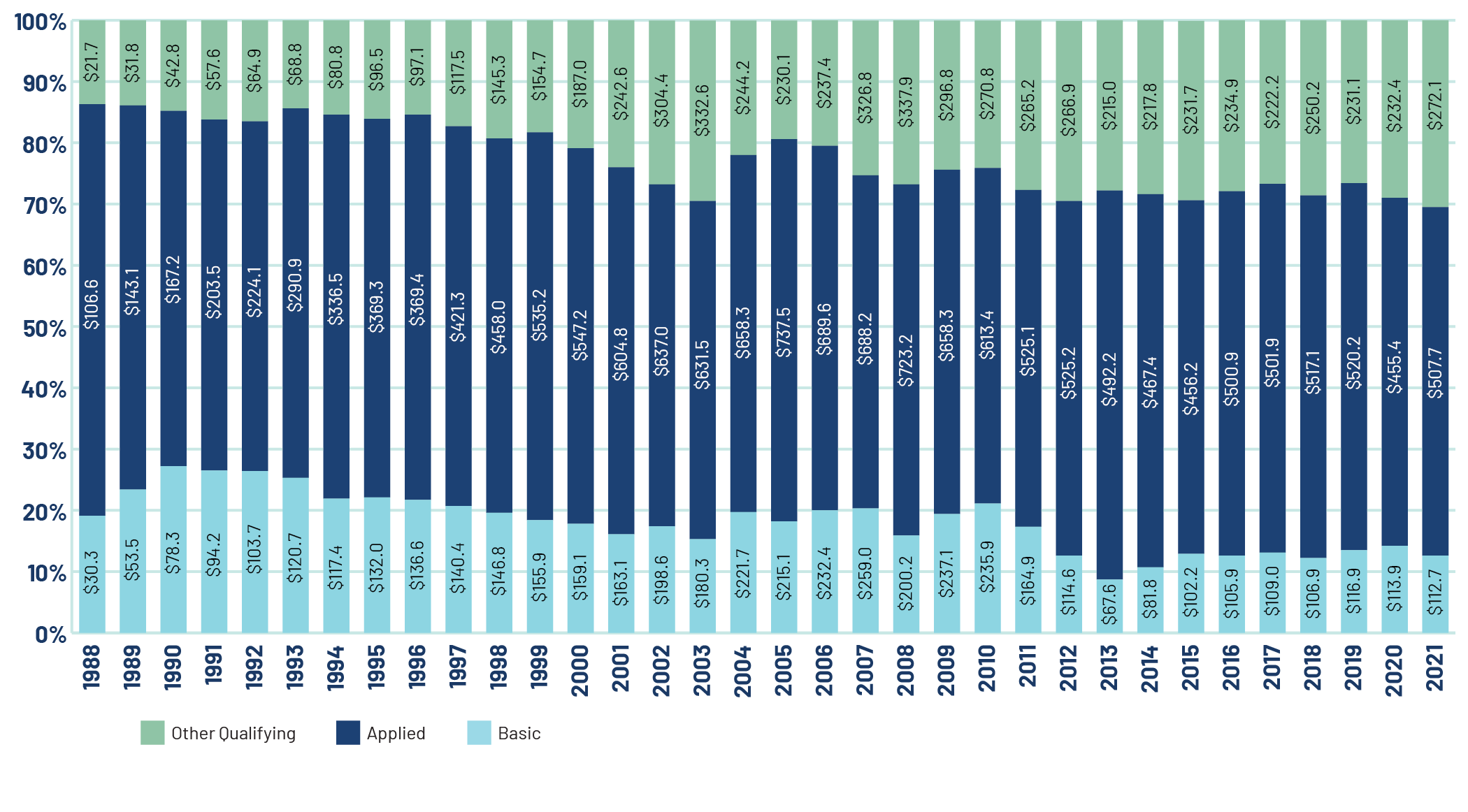
Data source: PMPRB
Figure description
This stacked bar graph depicts current R&D expenditures in millions of dollars from 1988 to 2021 by type of research: basic, applied, and other qualifying.
| Year | Basic research (millions of dollars) | Applied research (millions of dollars) | Other qualifying research (millions of dollars) |
|---|---|---|---|
1988 |
$30.3 |
$106.6 |
$21.7 |
1989 |
$53.5 |
$143.1 |
$31.8 |
1990 |
$78.3 |
$167.2 |
$42.8 |
1991 |
$94.2 |
$203.5 |
$57.6 |
1992 |
$103.7 |
$224.1 |
$64.9 |
1993 |
$120.7 |
$290.9 |
$68.8 |
1994 |
$117.4 |
$336.5 |
$80.8 |
1995 |
$132.0 |
$369.3 |
$96.5 |
1996 |
$136.6 |
$369.4 |
$97.1 |
1997 |
$140.4 |
$421.3 |
$117.5 |
1998 |
$146.8 |
$458.0 |
$145.3 |
1999 |
$155.9 |
$535.2 |
$154.7 |
2000 |
$159.1 |
$547.2 |
$187.0 |
2001 |
$163.1 |
$604.8 |
$242.6 |
2002 |
$198.6 |
$637.0 |
$304.4 |
2003 |
$180.3 |
$631.5 |
$332.6 |
2004 |
$221.7 |
$658.3 |
$244.2 |
2005 |
$215.1 |
$737.5 |
$230.1 |
2006 |
$232.4 |
$689.6 |
$237.4 |
2007 |
$259.0 |
$688.2 |
$326.8 |
2008 |
$200.2 |
$723.2 |
$337.9 |
2009 |
$237.1 |
$685.3 |
$296.8 |
2010 |
$235.9 |
$613.4 |
$270.8 |
2011 |
$164.9 |
$525.1 |
$265.2 |
2012 |
$114.6 |
$525.5 |
$266.9 |
2013 |
$67.6 |
$492.2 |
$215.0 |
2014 |
$81.8 |
$467.4 |
$217.8 |
2015 |
$102.2 |
$456.2 |
$231.7 |
2016 |
$105.9 |
$500.9 |
$234.9 |
2017 |
$109.0 |
$501.9 |
$222.2 |
2018 |
$106.9 |
$517.1 |
$250.2 |
2019 |
$116.9 |
$520.2 |
$231.1 |
2020 |
$113.9 |
$455.5 |
$232.4 |
2021 |
$112.7 |
$507.7 |
$272.1 |
Table 22. Ratios of R&D Expenditures to Sales Revenue by Reporting Patentee1, 2021 and 2020
| Company | R&D-to-sales ratio 2021 | R&D-to-sales ratio 2021 | MIP-to-Cdn price ratio – 5 country limit | Canadian sales compared to PMPRB7 sales 2021 | Canadian sales compared to rest of OECD sales 2021 |
|---|---|---|---|---|---|
AbbVie Corporation2,3 |
2.4% |
2.8% |
0.83 |
2.8 |
2.6 |
Advanced Accelerator Applications3 |
0.0% |
0.0% |
– |
0.1 |
0.04 |
Aerie Pharmaceuticals Inc. |
0.0% |
0.0% |
– |
– |
– |
Alexion Pharmaceuticals Inc.3 |
0.0% |
0.0% |
0.91 |
– |
– |
ALK-Abelló A/S |
7.7% |
1.4% |
1.08 |
3.6 |
2.8 |
Alkermes Inc. |
0.0% |
N/A |
– |
– |
– |
Allergan Inc. |
2.2% |
1.4% |
0.72 |
1.6 |
1.5 |
Alnylam Pharmaceuticals Inc.3 |
0.0% |
0.0% |
– |
– |
– |
Altius Healthcare Inc. |
14.4% |
40.9% |
– |
– |
– |
Amgen Canada Inc.2,3 |
3.2% |
3.6% |
0.90 |
1.7 |
1.6 |
Amicus Therapeutics UK Ltd2 |
0.0% |
0.0% |
1.19 |
– |
– |
Aralez Pharmaceuticals Inc. |
0.0% |
0.0% |
– |
– |
– |
Astellas Pharma Canada Inc.2 |
0.03% |
0.1% |
1.24 |
3.5 |
2.3 |
AstraZeneca Canada Inc.2,3 |
8.0% |
7.3% |
0.89 |
4.9 |
3.9 |
Avir Pharma Inc. |
0.0% |
0.0% |
0.98 |
– |
– |
Bausch Health Canada Inc. |
0.4% |
0.4% |
1.20 |
5.2 |
4.5 |
Baxter Corporation |
0.1% |
0.1% |
1.37 |
0.4 |
0.3 |
Bayer Inc.2,3 |
3.8% |
5.1% |
0.99 |
14.0 |
6.7 |
BeiGene Ltd3,4 |
76.6% |
N/A |
– |
– |
– |
BGP Pharma ULC |
0.0% |
0.0% |
0.54 |
90.5 |
63.9 |
Biogen Idec Canada Inc.3 |
11.1% |
10.4% |
0.94 |
3.2 |
2.4 |
BioMarin Canada Inc.3 |
2.1% |
5.1% |
0.94 |
– |
– |
Boehringer Ingelheim (Canada) Ltd2 |
1.1% |
1.8% |
0.87 |
3.2 |
2.7 |
Bristol-Myers Squibb Canada2,3 |
9.8% |
7.4% |
0.99 |
– |
– |
Celgene Inc.2 |
0.3% |
1.4% |
0.99 |
0.6 |
0.2 |
Cheplapharm Arzneimittel GmbH |
0.0% |
0.0% |
0.72 |
1.6 |
1.3 |
Chiesi USA Inc. |
0.0% |
0.0% |
– |
0.6 |
0.4 |
Cipher Pharmaceuticals Inc. |
0.9% |
1.3% |
– |
– |
– |
CSL Behring Canada Inc.3 |
0.1% |
0.1% |
1.62 |
– |
– |
Duchesnay Inc. |
0.0% |
0.1% |
– |
11.6 |
10.4 |
Dutch Ophthalmic Research Center (International) B.V.4 |
0.0% |
N/A |
– |
– |
– |
Eisai Ltd3 |
21.6% |
27.8% |
0.92 |
1.7 |
0.9 |
Eli Lilly Canada Inc. |
8.6% |
5.2% |
0.91 |
1.2 |
1.1 |
Elvium Life Sciences2,4 |
0.6% |
N/A |
0.84 |
– |
– |
EMD Serono Canada Inc.2 |
0.0% |
0.0% |
1.01 |
3.4 |
3.3 |
Fresenius Kabi4 |
0.4% |
N/A |
– |
0.9 |
0.7 |
Ferring Pharmaceuticals Inc.3 |
0.0% |
0.0% |
0.85 |
3.4 |
2.5 |
Galderma Canada Inc. |
0.0% |
0.0% |
0.36 |
5.3 |
4.3 |
GE Healthcare Inc. |
0.0% |
0.0% |
– |
– |
– |
Gilead Sciences Canada Inc.2,3 |
20.7% |
17.2% |
0.95 |
2.1 |
1.8 |
GlaxoSmithKline Inc.2 |
6.3% |
2.6% |
0.96 |
59.0 |
14.9 |
Grifols Canada Ltd |
0.0% |
0.0% |
– |
– |
– |
HLS Therapeutics Inc. |
0.2% |
0.2% |
– |
74.5 |
74.5 |
Hoffmann-La Roche Ltd Canada2,3 |
6.9% |
6.4% |
1.09 |
11.7 |
5.9 |
Horizon Pharma PLC2,3 |
0.0% |
0.0% |
– |
– |
– |
Incyte Biosciences Canada Corporation2,3,4 |
0.0% |
N/A |
– |
– |
– |
Indivior Canada Ltd |
0.0% |
0.0% |
0.92 |
3.8 |
3.7 |
Insmed Inc.4 |
0.0% |
N/A |
– |
– |
– |
Intercept Pharmaceuticals Inc. |
8.3% |
6.7% |
– |
1.3 |
1.0 |
Ipsen Biopharmaceuticals Inc.2,3 |
0.4% |
0.3% |
0.88 |
2.6 |
1.9 |
Janssen Inc.2,3 |
2.4% |
2.3% |
1.05 |
8.1 |
6.1 |
Jazz Pharmaceuticals3 |
41.1% |
36.4% |
– |
0.2 |
0.1 |
Johnson & Johnson Medical Products |
0.0% |
0.0% |
– |
– |
– |
Knight Therapeutics Inc.2 |
4.4% |
5.1% |
0.52 |
– |
– |
Labtician Théa. |
4.3% |
10.4% |
0.92 |
– |
– |
Lantheus MI Canada Inc. |
0.0% |
0.0% |
– |
– |
– |
LEO Pharma Inc.2 |
0.1% |
0.1% |
0.67 |
15.2 |
8.4 |
Lundbeck Canada Inc.2 |
0.6% |
0.6% |
0.59 |
12.5 |
7.4 |
Lupin Pharma Canada Ltd |
0.0% |
0.0% |
0.97 |
0.7 |
0.7 |
Medexus Inc. |
0.0% |
0.0% |
1.66 |
36.6 |
26.8 |
Medison Canada |
44.0% |
0.0% |
– |
– |
– |
Merck Canada Inc.2,3 |
5.9% |
5.7% |
1.00 |
4.1 |
3.2 |
Merz Pharma Canada Ltd |
0.0% |
0.0% |
1.17 |
2.5 |
1.8 |
Noden Pharma DAC |
0.0% |
0.0% |
– |
4.1 |
3.6 |
Novartis Pharmaceuticals Canada Inc.2,3 |
1.7% |
1.9% |
0.91 |
5.1 |
3.5 |
Novo Nordisk Canada Inc.2.3 |
1.4% |
1.3% |
1.94 |
2.7 |
2.4 |
Octapharma Canada Inc. |
0.0% |
0.0% |
– |
– |
– |
Organon Canada Inc.4 |
0.0% |
N/A |
1.03 |
– |
– |
Otsuka Canada Pharmaceutical Inc. (OCPI)2 |
2.1% |
1.5% |
0.99 |
6.0 |
2.9 |
Paladin Labs Inc.2 |
0.3% |
0.2% |
1.07 |
– |
– |
Partner Therapeutics Inc. |
0.0% |
0.0% |
– |
– |
– |
Pediapharm Inc. |
0.0% |
0.0% |
– |
– |
– |
Pfizer Canada Inc.2,3 |
0.1% |
0.3% |
1.17 |
3.9 |
3.2 |
Pierre Fabre Dermo-Cosmétique Canada Inc. |
0.0% |
0.0% |
1.01 |
0.5 |
0.2 |
Purdue Pharma |
0.1% |
0.7% |
1.22 |
14.7 |
12.8 |
Recordati Rare Diseases |
0.0% |
0.0% |
0.85 |
– |
– |
Sandoz Canada Inc. |
0.0% |
0.0% |
– |
15.3 |
8.1 |
Sanofi Canada Inc.2,3 |
1.5% |
2.3% |
0.89 |
24.3 |
11.3 |
Sanofi Pasteur Ltd |
43.7% |
47.5% |
– |
– |
– |
Santen SAS2 |
0.0% |
0.0% |
– |
0.3 |
0.02 |
Searchlight Pharma Inc. |
0.0% |
0.0% |
0.96 |
– |
– |
Seagen Canada Inc. (Seattle Genetics Inc.)3 |
7.4% |
11.6% |
1.35 |
– |
– |
Seqirus Canada Inc.3 |
9.5% |
8.0% |
1.87 |
0.4 |
0.3 |
Servier Canada Inc.2,3 |
2.7% |
3.7% |
1.04 |
33.0 |
6.5 |
SpringWorks Therapeutics Inc.4 |
0.0% |
N/A |
1.48 |
– |
– |
SteriMax Inc. |
1.0% |
1.6% |
– |
99.0 |
97.0 |
Sun Pharmaceutical Industries Inc. |
342.7% |
20,074.4% |
– |
0.5 |
0.4 |
Sunovion Pharmaceuticals Canada Inc.2 |
0.0% |
0.0% |
0.49 |
1.1 |
1.0 |
Swedish Orphan Biovitrum AB (Sobi)2,3 |
0.0% |
0.0% |
0.83 |
0.05 |
0.02 |
Taiho Oncology Inc.3 |
44.0% |
2.3% |
1.10 |
3.1 |
0.8 |
Takeda Canada Inc.2,3 |
0.1% |
0.1% |
– |
3.8 |
2.8 |
Theratechnologies Inc.2 |
665.7% |
798.5% |
– |
– |
– |
Teva Canada Innovation3 |
0.1% |
0.1% |
0.98 |
5.8 |
4.5 |
UCB Canada Inc.3 |
20.0% |
7.8% |
0.95 |
1.6 |
1.2 |
Ultragenyx Pharmaceutical Inc.2 |
12.1% |
21.3% |
0.88 |
– |
– |
Upjohn Canada ULC |
0.0% |
0.0% |
0.77 |
14.1 |
9.3 |
Valeo Pharma2 |
0.0% |
0.0% |
0.72 |
– |
– |
Vertex Pharma Canada Inc.3 |
0.5% |
0.0% |
1.06 |
– |
– |
ViiV Healthcare ULC2 |
0.0% |
0.0% |
1.03 |
3.0 |
2.4 |
Xediton Pharmaceuticals Inc. |
0.0% |
0.0% |
0.93 |
– |
– |
1 To avoid double counting sales revenues, revenues from royalties are included in calculating each company’s ratio but not included in calculating industry-wide ratios. Federal and provincial government grants are subtracted from the R&D expenditure in calculating individual R&D-to-sales ratios but are included in calculating industry-wide ratios. Differences between the list of companies filing data on prices and those filing R&D data are due to differences in the reporting practices of patentees and their affiliates or licensees. Note as well that some veterinary patentees (i.e., those without revenue from sales of products for human use) are required to file information on R&D expenditures but not price and sales information.
2 Member of Innovative Medicines Canada.
3 Member of BIOTECanada.
4 Not a patentee in 2020.
Data source: PMPRB
Table 23. Current R&D Expenditures by Province/Territory, 2021
| Province | Expenditures: All patentees ($thousands) | Regional share | Expenditures: Innovative Medicines Canada ($thousands) | Regional share |
|---|---|---|---|---|
Newfoundland and Labrador |
$1,464.25 |
0.164% |
$895.40 |
0.125% |
Prince Edward Island |
$205.92 |
0.023% |
$5.61 |
0.001% |
Nova Scotia |
$9,742.19 |
1.092% |
$6,856.88 |
0.958% |
New Brunswick |
$1,593.48 |
0.179% |
$1,062.29 |
0.148% |
Quebec |
$234,974.95 |
26.327% |
$202,379.46 |
28.269% |
Ontario |
$466,443.52 |
52.262% |
$351,638.91 |
49.118% |
Manitoba |
$3,712.12 |
0.416% |
$2,457.72 |
0.343% |
Saskatchewan |
$2,095.55 |
0.235% |
$619.40 |
0.087% |
Alberta |
$101,173.12 |
11.336% |
$96,139.53 |
13.429% |
British Columbia |
$71,035.55 |
7.959% |
$53,852.32 |
7.522% |
Territories |
$70.60 |
0.008% |
$0.00 |
0.000% |
Canada* |
$892,511.25 |
100% |
$715,907.52 |
100% |
* Provincial/territorial values may not add to totals for Canada due to rounding.
Data source: PMPRB
Table 24. Current R&D Expenditures by Performer and Province/Territory, 2021
| Province | Patentees | Other companies | Universities | Hospitals | Others | |
|---|---|---|---|---|---|---|
Newfoundland and Labrador |
Expenditure ($thousands) |
$644.61 |
$536.50 |
$113.05 |
$21.95 |
$148.14 |
Share |
44.0% |
36.6% |
7.7% |
1.5% |
10.1% |
|
Prince Edward Island |
Expenditure ($thousands) |
$91.39 |
$108.93 |
$0.00 |
$5.61 |
$0.00 |
Share |
44.4% |
52.9% |
0.0% |
2.7% |
0.0% |
|
Nova Scotia |
Expenditure ($thousands) |
$1,198.57 |
$2,991.64 |
$1,112.77 |
$477.82 |
$3,961.38 |
Share |
12.3% |
30.7% |
11.4% |
4.9% |
40.7% |
|
New Brunswick |
Expenditure ($thousands) |
$663.86 |
$343.86 |
$110.41 |
$73.14 |
$402.21 |
Share |
41.7% |
21.6% |
6.9% |
4.6% |
25.2% |
|
Quebec |
Expenditure ($thousands) |
$58,203.70 |
$93,591.89 |
$18,745.84 |
$23,572.73 |
$40,860.79 |
Share |
24.8% |
39.8% |
8.0% |
10.0% |
17.4% |
|
Ontario |
Expenditure ($thousands) |
$256,804.92 |
$82,968.76 |
$39,193.78 |
$46,616.06 |
$40,859.99 |
Share |
55.1% |
17.8% |
8.4% |
10.0% |
8.8% |
|
Manitoba |
Expenditure ($thousands) |
$1,587.87 |
$665.01 |
$653.29 |
$509.43 |
$296.52 |
Share |
42.8% |
17.9% |
17.6% |
13.7% |
8.0% |
|
Saskatchewan |
Expenditure ($thousands) |
$672.77 |
$475.52 |
$506.36 |
$11.04 |
$429.86 |
Share |
32.1% |
22.7% |
24.2% |
0.5% |
20.5% |
|
Alberta |
Expenditure ($thousands) |
$73,532.40 |
$12,437.76 |
$4,072.90 |
$4,192.31 |
$6,937.76 |
Share |
72.7% |
12.3% |
4.0% |
4.1% |
6.9% |
|
British Columbia |
Expenditure ($thousands) |
$23,860.60 |
$31,702.34 |
$4,763.28 |
$3,179.76 |
$7,529.57 |
Share |
33.6% |
44.6% |
6.7% |
4.5% |
10.6% |
|
Territories |
Expenditure ($thousands) |
$70.60 |
$0.00 |
$0.00 |
$0.00 |
$0.00 |
Share |
100.0% |
0.0% |
0.0% |
0.0% |
0.0% |
|
Canada* |
Expenditure ($thousands) |
$417,331.29 |
$225,822.21 |
$69,271.68 |
$78,659.85 |
$101,426.22 |
Share |
46.8% |
25.3% |
7.8% |
8.8% |
11.4% |
|
Note: For each jurisdiction, the share for each category represents the percentage of total R&D expenditures for the given province or territory (or nationally for the total R&D in Canada).
* Provincial/territorial expenditures may not add to totals for Canada and shares across individual rows may not add to 100% due to rounding.
Total R&D expenditures are the sum of current expenditures and capital expenditures (equipment + depreciation).
Data source: PMPRB